 | –≠–ª–µ–∫—Ç—Ä–æ–Ω–Ω—ã–π –∫–æ–º–ø–æ–Ω–µ–Ω—Ç: TDA9870AH | –°–∫–∞—á–∞—Ç—å:  PDF PDF  ZIP ZIP |
Document Outline
- CONTENTS
- 1 FEATURES
- 1.1 Demodulator and decoder section
- 1.2 DSP section
- 1.3 Analog audio section
- 2 GENERAL DESCRIPTION
- 3 ORDERING INFORMATION
- 4 BLOCK DIAGRAM
- 5 PINNING
- 6 FUNCTIONAL DESCRIPTION
- 6.1 Demodulator and decoder section
- 6.2 Digital signal processing
- 6.3 Analog audio section
- 7 LIMITING VALUES
- 8 THERMAL CHARACTERISTICS
- 9 CHARACTERISTICS
- 10 I 2 C-BUS CONTROL
- 10.1 Introduction
- 10.2 Power-up state
- 10.3 Slave receiver mode
- 10.3.1 AGC GAIN REGISTER
- 10.3.2 GENERAL CONFIGURATION REGISTER
- 10.3.3 MONITOR SELECT REGISTER
- 10.3.4 CARRIER 1 FREQUENCY REGISTER
- 10.3.5 CARRIER 2 FREQUENCY REGISTER
- 10.3.6 DEMODULATOR CONFIGURATION REGISTER
- 10.3.7 FM DE-EMPHASIS REGISTER
- 10.3.8 FM MATRIX REGISTER
- 10.3.9 FM CHANNEL 1 LEVEL ADJUST REGISTER
- 10.3.10 FM CHANNEL 2 LEVEL ADJUST REGISTER
- 10.3.11 REGISTER 14
- 10.3.12 REGISTER 15
- 10.3.13 REGISTER 16
- 10.3.14 REGISTER 17
- 10.3.15 AUDIO MUTE CONTROL REGISTER
- 10.3.16 DAC OUTPUT SELECT REGISTER
- 10.3.17 SCART 1 OUTPUT SELECT REGISTER
- 10.3.18 SCART 2 OUTPUT SELECT REGISTER
- 10.3.19 LINE OUTPUT SELECT REGISTER
- 10.3.20 ADC OUTPUT SELECT REGISTER
- 10.3.21 MAIN CHANNEL SELECT REGISTER
- 10.3.22 AUDIO EFFECTS REGISTER
- 10.3.23 VOLUME CONTROL REGISTERS (MAIN)
- 10.3.24 CONTOUR CONTROL REGISTER
- 10.3.25 BASS CONTROL REGISTER (MAIN)
- 10.3.26 TREBLE CONTROL REGISTER (MAIN)
- 10.3.27 AUXILIARY CHANNEL SELECT REGISTER
- 10.3.28 VOLUME CONTROL REGISTERS (AUXILIARY)
- 10.3.29 BASS CONTROL REGISTER (AUXILIARY)
- 10.3.30 TREBLE CONTROL REGISTER (AUXILIARY)
- 10.3.31 FEATURE INTERFACE CONFIGURATION REGISTER
- 10.3.32 I 2 S1 OUTPUT SELECT REGISTER
- 10.3.33 I 2 S1 INPUT LEVEL ADJUST REGISTER
- 10.3.34 I 2 S1 OUTPUT LEVEL ADJUST REGISTER
- 10.3.35 I 2 S2 OUTPUT SELECT REGISTER
- 10.3.36 I 2 S2 INPUT LEVEL ADJUST REGISTER
- 10.3.37 I 2 S2 OUTPUT LEVEL ADJUST REGISTER
- 10.3.38 BEEPER FREQUENCY CONTROL REGISTER
- 10.3.39 BEEPER VOLUME CONTROL REGISTER
- 10.3.40 BASS BOOST CONTROL REGISTER
- 10.4 Slave transmitter mode
- 11 I 2 S-BUS DESCRIPTION
- 12 APPLICATION INFORMATION
- 13 PACKAGE OUTLINES
- 14 SOLDERING
- 14.1 Introduction
- 14.2 Through-hole mount packages
- 14.3 Surface mount packages
- 14.4 Suitability of IC packages for wave, reflow and dipping soldering methods
- 15 DEFINITIONS
- 16 LIFE SUPPORT APPLICATIONS
- 17 PURCHASE OF PHILIPS I 2 C COMPONENTS

DATA SHEET
Product specification
Supersedes data of 1998 Aug 10
File under Integrated Circuits, IC02
1999 Dec 20
INTEGRATED CIRCUITS
TDA9870A
Digital TV Sound Processor
(DTVSP)

1999 Dec 20
2
Philips Semiconductors
Product specification
Digital TV Sound Processor (DTVSP)
TDA9870A
CONTENTS
1
FEATURES
1.1
Demodulator and decoder section
1.2
DSP section
1.3
Analog audio section
2
GENERAL DESCRIPTION
2.1
Supported standards
3
ORDERING INFORMATION
4
BLOCK DIAGRAM
5
PINNING
6
FUNCTIONAL DESCRIPTION
6.1
Demodulator and decoder section
6.2
Description of the DSP
6.3
Analog audio section
7
LIMITING VALUES
8
THERMAL CHARACTERISTICS
9
CHARACTERISTICS
10
I
2
C-BUS CONTROL
10.1
Introduction
10.2
Power-up state
10.3
Slave receiver mode
10.4
Slave transmitter mode
10.5
Expert mode
11
I
2
S-BUS DESCRIPTION
12
APPLICATION INFORMATION
13
PACKAGE OUTLINES
14
SOLDERING
14.1
Introduction
14.2
Through-hole mount packages
14.3
Surface mount packages
14.4
Suitability of IC packages for wave, reflow and
dipping soldering methods
15
DEFINITIONS
16
LIFE SUPPORT APPLICATIONS
17
PURCHASE OF PHILIPS I
2
C COMPONENTS

1999 Dec 20
3
Philips Semiconductors
Product specification
Digital TV Sound Processor (DTVSP)
TDA9870A
1
FEATURES
1.1
Demodulator and decoder section
∑
Sound IF (SIF) input switch e.g. to select between
terrestrial TV SIF and SAT SIF sources
∑
SIF AGC with 24 dB control range
∑
SIF 8-bit Analog-to-Digital Converter (ADC)
∑
Two-carrier multistandard FM demodulation
(B/G, D/K and M standard)
∑
Decoding for three analog multi-channel systems
(A2, A2+ and A2*) and satellite sound
∑
Programmable identification (B/G, D/K and M standard)
and different identification times.
1.2
DSP section
∑
Digital crossbar switch for all digital signal sources and
destinations
∑
Control of volume, balance, contour, bass, treble,
pseudo stereo, spatial, bass boost and soft mute
∑
Plop-free volume control
∑
Automatic Volume Level (AVL) control
∑
Adaptive de-emphasis for satellite
∑
Programmable beeper
∑
Monitor selection for FM/AM DC values and signals,
with peak detection option
∑
I
2
S-bus interface for a feature extension (e.g. Dolby
surround) with matrix, level adjust and mute.
1.3
Analog audio section
∑
Analog crossbar switch with inputs for mono and stereo
(also applicable as SCART 3 input), SCART 1
input/output, SCART 2 input/output and line output
∑
User defined full-level/
-
3 dB scaling for SCART outputs
∑
Output selection of mono, stereo, dual A/B, dual A or
dual B
∑
20 kHz bandwidth for SCART-to-SCART copies
∑
Standby mode with functionality for SCART copies
∑
Dual audio Digital-to-Analog Converter (DAC) from DSP
to analog crossbar switch, bandwidth of 15 kHz
∑
Dual audio ADC from analog inputs to DSP
∑
Two dual audio DACs for loudspeaker (Main) and
headphone (Auxiliary) outputs; also applicable for
L, R, C and S in the Dolby Pro Logic mode with feature
extension.
2
GENERAL DESCRIPTION
The TDA9870A is a single-chip Digital TV Sound
Processor (DTVSP) for analog multi-channel sound
systems in TV sets and satellite receivers.
2.1
Supported standards
The multistandard/multi-stereo capability of the
TDA9870A is mainly of interest in Europe, but also in
Hong Kong/Peoples Republic of China and South East
Asia. This includes B/G, D/K, I, M and L standard. In other
application areas there exists only subsets of those
standard combinations otherwise only single standards
are transmitted.
M standard is transmitted in Europe by the American
Forces Network (AFN) with European channel spacing
(7 MHz VHF, 8 MHz UHF) and monaural sound.
Korea has a stereo sound system similar to Europe and is
supported by the TDA9870A. Differences include
deviation, modulation contents and identification. It is
based on M standard.
An overview of the supported standards and sound
systems and their key parameters is given in Table 1.
The analog multi-channel sound systems (A2, A2+
and A2*) are 2-Carrier Systems (2CS).
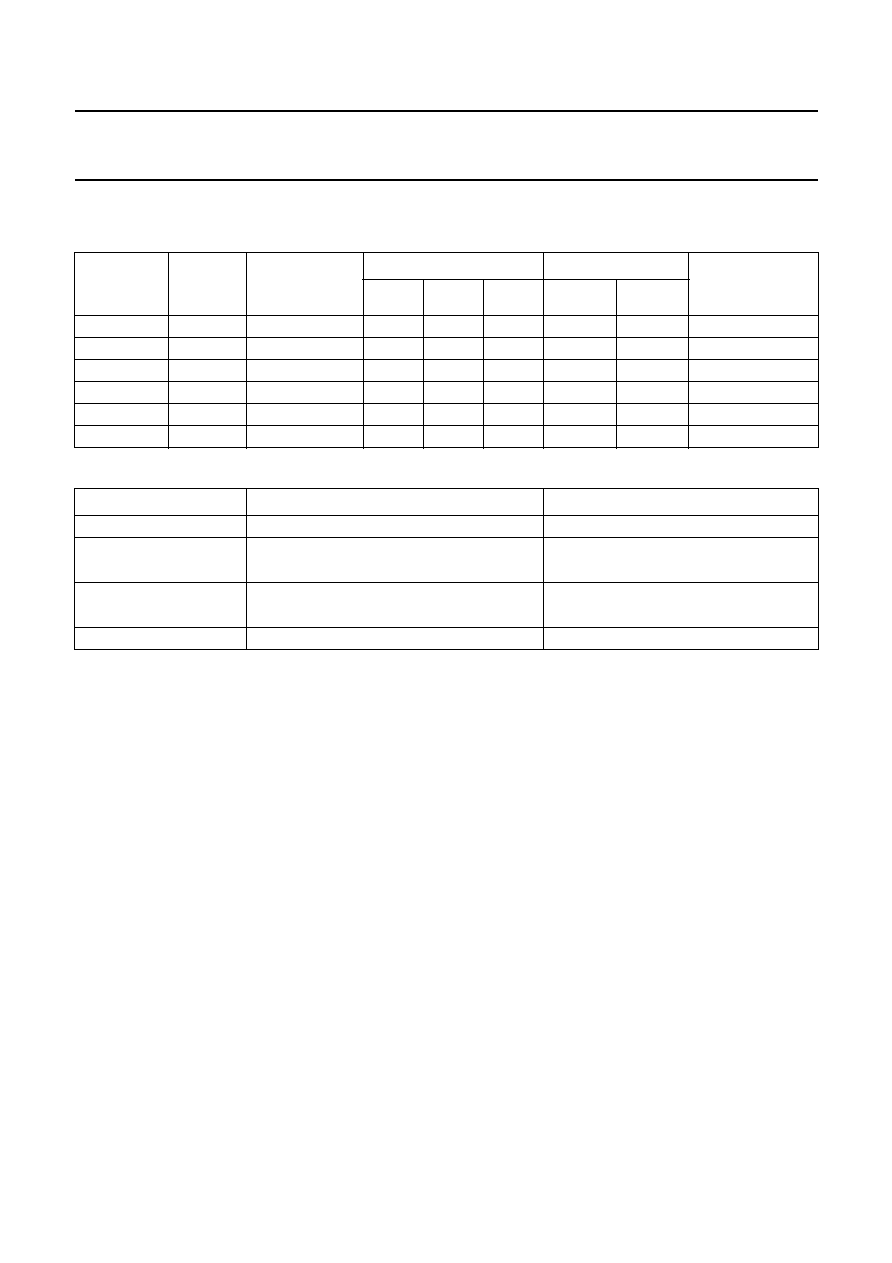
1999 Dec 20
4
Philips Semiconductors
Product specification
Digital TV Sound Processor (DTVSP)
TDA9870A
2.1.1
A
NALOG
2-
CARRIER SYSTEMS
Table 1
Frequency modulation
Table 2
Identification for A2 systems
STANDARD
SOUND
SYSTEM
CARRIER
FREQUENCY
(MHz)
FM DEVIATION (kHz)
MODULATION
BANDWIDTH/
DE-EMPHASIS
(kHz/
µ
s)
NOM.
MAX.
OVER
SC1
SC2
M
mono
4.5
15
25
50
mono
-
15/75
M
A2+
4.5/4.724
15
25
50
1
/
2
(L + R)
1
/
2
(L
-
R)
15/75 (Korea)
B/G
A2
5.5/5.742
27
50
80
1
/
2
(L + R)
R
15/50
I
mono
6.0
27
50
80
mono
-
15/50
D/K
A2
6.5/6.742
27
50
80
1
/
2
(L + R)
R
15/50
D/K
A2*
6.5/6.258
27
50
80
1
/
2
(L + R)
R
15/50
PARAMETER
A2/A2*
A2+ (KOREA)
Pilot frequency
54.6875 kHz = 3.5
◊
line frequency
55.0699 kHz = 3.5
◊
line frequency
Stereo identification
frequency
Dual identification
frequency
AM modulation depth
50%
50%
117.5 Hz
line frequency
133
-------------------------------------
=
149.9 Hz
line frequency
105
-------------------------------------
=
274.1 Hz
line frequency
57
-------------------------------------
=
276.0 Hz
line frequency
57
-------------------------------------
=

1999 Dec 20
5
Philips Semiconductors
Product specification
Digital TV Sound Processor (DTVSP)
TDA9870A
2.1.2
S
ATELLITE SYSTEMS
An important specification for satellite TV reception is the
"Astra specification". The TDA9870A is suited for the reception
of Astra and other satellite signals.
Table 3
FM satellite sound
Notes
1. For other satellite systems, frequencies of, for example, 5.80, 6.60 or 6.65 MHz can also be received.
2. A de-emphasis of 60
µ
s, or in accordance with J17, is available.
3. m/st/d = mono, stereo or dual language sound.
4. Adaptive de-emphasis is compatible to transmitter specification.
3
ORDERING INFORMATION
CARRIER TYPE
CARRIER
FREQUENCY
(MHz)
MODULATION
INDEX
MAXIMUM
FM DEVIATION
(kHz)
MODULATION
BANDWIDTH/
DE-EMPHASIS
(kHz/
µ
s)
Main
6.50
(1)
0.26
85
mono
15/50
(2)
Sub
7.02/7.20
0.15
50
m/st/d
(3)
15/adaptive
(4)
Sub
7.38/7.56
Sub
7.74/7.92
Sub
8.10/8.28
TYPE NUMBER
PACKAGE
NAME
DESCRIPTION
VERSION
TDA9870A
SDIP64
plastic shrink dual in-line package; 64 leads (750 mil)
SOT274-1
TDA9870AH
QFP64
plastic quad flat package; 64 leads (lead length 1.6 mm);
body 14
◊
14
◊
2.7 mm
SOT393-1

1999 Dec 20
6
Philips Semiconductors
Product specification
Digital TV Sound Processor (DTVSP)
TDA9870A
4
BLOCK DIAGRAM
handbook, full pagewidth
MHB593
I
2
C-BUS
INTERFACE
INPUT SWITCH
AGC, ADC
FM (AM)
DEMODULATION
SUPPLY
SOUND IF
(SIF)
IDENTIFICATION
A2/SATELLITE
DECODER
AUDIO PROCESSING
SUPPLY
SCART,
DAC,
ADC
LEVEL
ADJUST
PEAK
DETECTION
ADC (2)
DAC (2)
DAC (2)
TEST
TDA9870A
(TDA9870AH)
MOL
DAC (2)
ANALOG
CROSSBAR
SWITCH
CLOCK
SIF2
SIF1
9 (1)
20 (12)
10 (2)
12 (4)
3 (59)
13 (5)
4 (60)
5 (61)
P1
P2
ADDR1
ADDR2
18 (10)
XTALI
19 (11)
XTALO
21 (13)
SYSCLK
SCL
SDA
I
2
S-BUS
INTERFACE
27 (19)
26 (18)
25 (17)
24 (16)
22 (14)
23 (15)
SDI1
SDI2
SDO1
SDO2
SCK
WS
DIGITAL
SUPPLY
DIGITAL
SELECT
15 (7)
64 (56)
35 (27)
17 (9)
16 (8)
VDDD1
VDDD2
VSSD3
VSSD4
CRESET
14 (6)
49 (41)
VSSD1
VSSD2
28 (20)
Vref3
Vref(n)
Vref(p)
VDEC2
VDDA
PCAPL
PCAPR
30 (22)
(51) 59
(30) 38
(46) 54
i.c.
(58) 2
i.c.
(57) 1
LOL
LOR
SCOL2
SCOR2
SCOL1
SCOR1
(44) 52
(43) 51
(54) 62
(55) 63
(40) 48
(39) 47
Iref
(64) 8
Vref1
(3) 11
VSSA1
(62) 6
VDEC1
(63) 7
MONOIN
EXTIL
EXTIR
SCIL2
SCIR2
SCIL1
(23) 31
(29) 37
(21) 29
(24) 32
(28) 36
(26) 34
SCIR1
(25) 33
(47) 55
(31) 39
(32) 40
(53)
61
MOR
(52)
60
AUXOL
(50)
58
AUXOR
(49)
57
TEST2
TEST1
i.c.
(34) 42
i.c.
(33) 41
i.c.
(36) 44
i.c.
(37) 45
VSSA3
VSSA2
Vref2
(38) 46
(45) 53
(35) 43
(48) 56
VSSA4
(42) 50
Fig.1 Block diagram.
The pin numbers given in parenthesis refer to the TDA9870AH version.
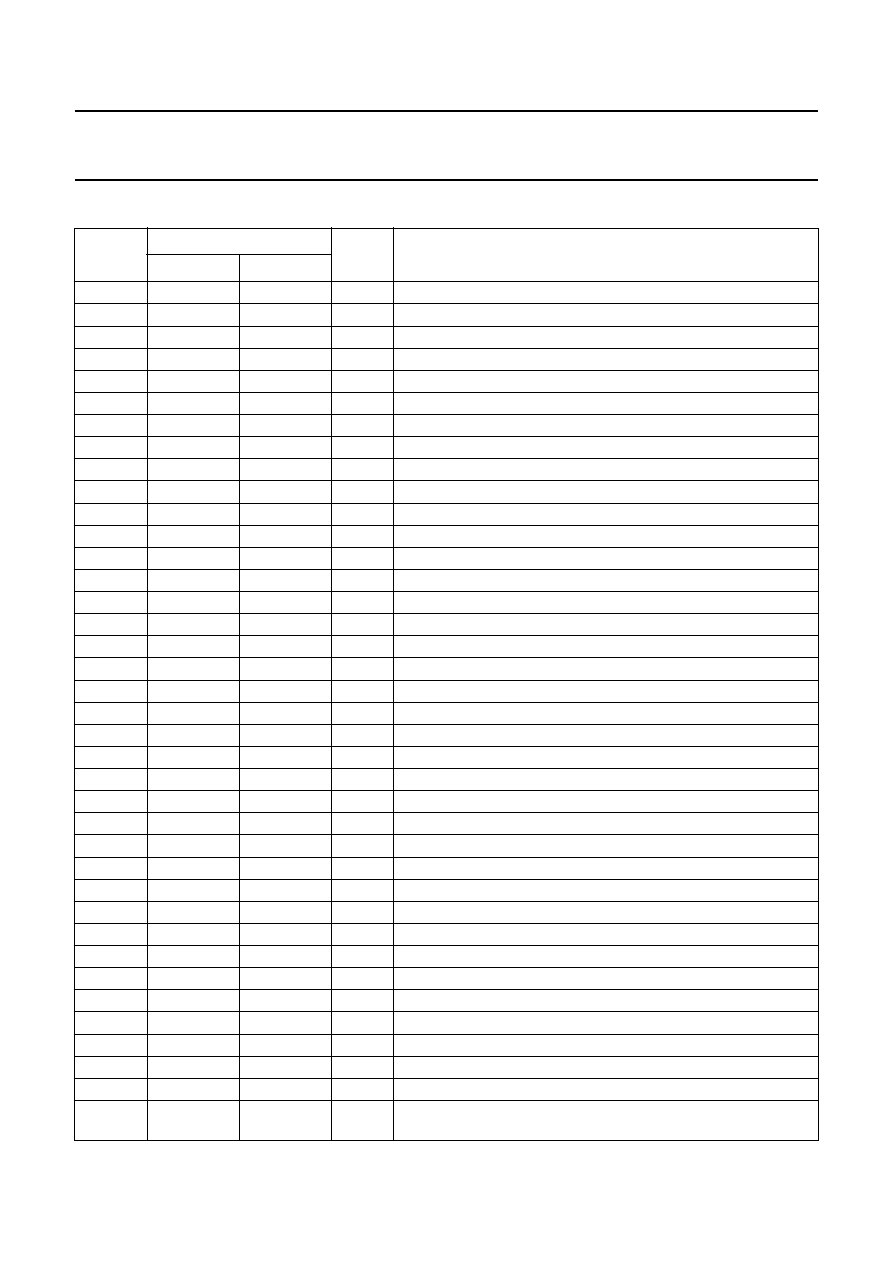
1999 Dec 20
7
Philips Semiconductors
Product specification
Digital TV Sound Processor (DTVSP)
TDA9870A
5
PINNING
SYMBOL
PIN
PIN
TYPE
(1)
DESCRIPTION
TDA9870A
TDA9870AH
i.c.
1
57
-
internally connected; note 2
i.c.
2
58
-
internally connected; note 2
ADDR1
3
59
I
I
2
C-bus slave address input 1
SCL
4
60
I
I
2
C-bus clock input
SDA
5
61
I/O
I
2
C-bus data input/output
V
SSA1
6
62
S
supply ground 1; analog front-end circuitry
V
DEC1
7
63
-
supply voltage decoupling 1; analog front-end circuitry
I
ref
8
64
-
resistor for reference current generator; analog front-end circuitry
P1
9
1
I/O
general purpose input/output pin 1
SIF2
10
2
I
sound IF input 2
V
ref1
11
3
-
reference voltage 1; analog front-end circuitry
SIF1
12
4
I
sound IF input 1
ADDR2
13
5
I
I
2
C-bus slave address input 2
V
SSD1
14
6
S
supply ground 1; digital circuitry
V
DDD1
15
7
S
digital supply voltage 1; digital circuitry
CRESET
16
8
-
capacitor for Power-on reset
V
SSD4
17
9
S
supply ground 4; digital circuitry
XTALI
18
10
I
crystal oscillator input
XTALO
19
11
O
crystal oscillator output
P2
20
12
I/O
general purpose input/output pin 2
SYSCLK
21
13
O
system clock output
SCK
22
14
I/O
I
2
S-bus clock input/output
WS
23
15
I/O
I
2
S-bus word select input/output
SDO2
24
16
O
I
2
S-bus data output 2 (I
2
S2 output)
SDO1
25
17
O
I
2
S-bus data output 1 (I
2
S1 output)
SDI2
26
18
I
I
2
S-bus data input 2 (I
2
S2 input)
SDI1
27
19
I
I
2
S-bus data input 1 (I
2
S1 input)
TEST1
28
20
I
test pin 1; connected to V
SSD1
for normal operation
MONOIN
29
21
I
audio mono input
TEST2
30
22
I
test pin 2; connected to V
SSD1
for normal operation
EXTIR
31
23
I
external audio input right channel
EXTIL
32
24
I
external audio input left channel
SCIR1
33
25
I
SCART 1 input right channel
SCIL1
34
26
I
SCART 1 input left channel
V
SSD3
35
27
S
supply ground 3; digital circuitry
SCIR2
36
28
I
SCART 2 input right channel
SCIL2
37
29
I
SCART 2 input left channel
V
DEC2
38
30
-
supply voltage decoupling 2; audio analog-to-digital converter
circuitry
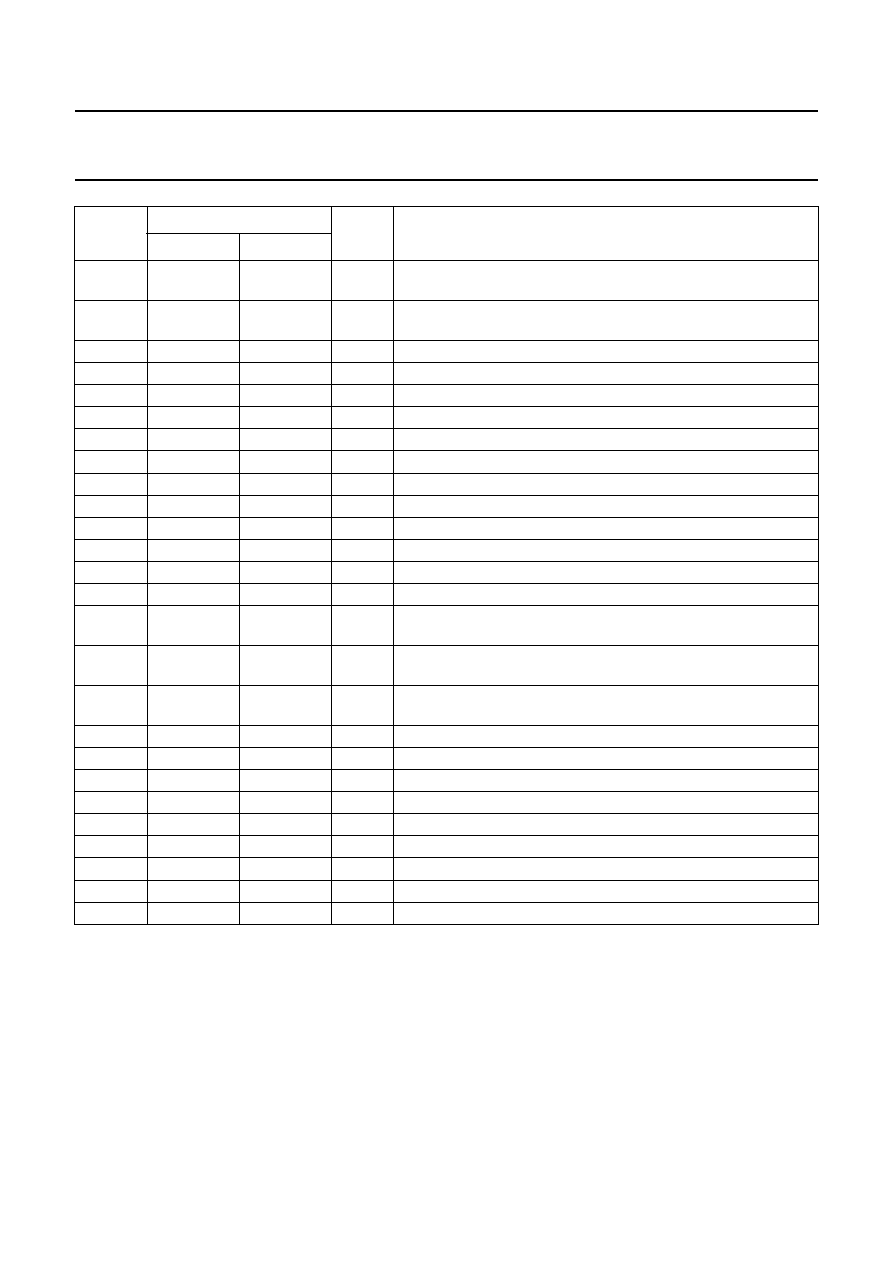
1999 Dec 20
8
Philips Semiconductors
Product specification
Digital TV Sound Processor (DTVSP)
TDA9870A
Notes
1. Pin type: I = Input; O = Output; S = Supply.
2. Test pin: CMOS 3-state stage, pull-up resistor, can be connected to V
SS
.
3. Test pin: CMOS level input, pull-up resistor, can be connected to V
SS
.
4. Test pin: CMOS 3-state stage, can be connected to V
SS
.
V
ref(p)
39
31
-
positive reference voltage; audio analog-to-digital converter
circuitry
V
ref(n)
40
32
-
reference voltage ground; audio analog-to-digital converter
circuitry
i.c.
41
33
-
internally connected; note 3
i.c.
42
34
-
internally connected; note 4
V
SSA2
43
35
S
supply ground 2; audio analog-to-digital converter circuitry
i.c.
44
36
-
internally connected; note 4
i.c.
45
37
-
internally connected; note 3
V
ref2
46
38
-
reference voltage 2; audio analog-to-digital converter circuitry
SCOR1
47
39
O
SCART 1 right channel output
SCOL1
48
40
O
SCART 1 left channel output
V
SSD2
49
41
S
supply ground 2; digital circuitry
V
SSA4
50
42
S
supply ground 4; audio operational amplifier circuitry
SCOR2
51
43
O
SCART 2 right channel output
SCOL2
52
44
O
SCART 2 left channel output
V
ref3
53
45
-
reference voltage 3; audio digital-to-analog converter and
operational amplifier circuitry
PCAPR
54
46
-
post-filter capacitor pin right channel, audio digital-to-analog
converter
PCAPL
55
47
-
post-filter capacitor pin left channel, audio digital-to-analog
converter
V
SSA3
56
48
S
supply ground 3; audio digital-to-analog converter circuitry
AUXOR
57
49
O
headphone (Auxiliary) right channel output
AUXOL
58
50
O
headphone (Auxiliary) left channel output
V
DDA
59
51
S
analog power supply voltage; analog circuitry
MOR
60
52
O
loudspeaker (Main) right channel output
MOL
61
53
O
loudspeaker (Main) left channel output
LOL
62
54
O
line output left channel
LOR
63
55
O
line output right channel
V
DDD2
64
56
S
digital supply voltage 2; digital circuitry
SYMBOL
PIN
PIN
TYPE
(1)
DESCRIPTION
TDA9870A
TDA9870AH

1999 Dec 20
9
Philips Semiconductors
Product specification
Digital TV Sound Processor (DTVSP)
TDA9870A
handbook, halfpage
TDA9870A
MHB111
1
2
3
4
5
6
7
8
9
10
11
12
13
14
15
16
17
18
19
20
21
22
23
24
25
26
27
28
29
30
31
32
64
63
62
61
60
59
58
57
56
55
54
53
52
51
50
49
48
47
46
45
44
43
42
41
40
39
38
37
36
35
34
33
VDDD2
LOR
LOL
MOL
MOR
VDDA
AUXOL
AUXOR
VSSA3
PCAPL
PCAPR
Vref3
SCOL2
SCOR2
VSSA4
VSSD2
SCOL1
SCOR1
Vref2
i.c.
i.c.
VSSA2
i.c.
i.c.
Vref(n)
Vref(p)
VDEC2
SCIL2
SCIR2
VSSD3
SCIL1
SCIR1
i.c.
i.c.
ADDR1
SCL
SDA
VSSA1
VDEC1
Iref
P1
SIF2
Vref1
SIF1
ADDR2
VSSD1
VDDD1
CRESET
XTALO
XTALI
VSSD4
P2
SYSCLK
SCK
WS
SDO2
SDO1
SDI2
SDI1
TEST1
MONOIN
TEST2
EXTIR
EXTIL
Fig.2 Pin configuration (TDA9870A).

1999 Dec 20
10
Philips Semiconductors
Product specification
Digital TV Sound Processor (DTVSP)
TDA9870A
handbook, full pagewidth
TDA9870AH
MHB594
1
2
3
4
5
6
7
8
9
10
11
12
13
14
15
16
48
47
46
45
44
43
42
41
40
39
38
37
36
35
34
VSSA3
PCAPL
PCAPR
Vref3
SCOL2
SCOR2
VSSA4
VSSD2
SCOL1
SCOR1
Vref2
i.c.
i.c.
VSSA2
i.c.
i.c.
P1
SIF2
Vref1
SIF1
ADDR2
VSSD1
VDDD1
CRESET
VSSD4
XTALI
XTALO
P2
SYSCLK
SCK
WS
SDO2
33
17
18
19
20
21
22
23
24
25
26
27
28
29
30
31
32
64
63
62
61
60
59
58
57
56
55
54
53
52
51
50
I ref
V
DEC1
V
SSA1
SDA
SCL
ADDR1
i.c.
i.c.
V
DDD2
LOR
LOL
MOL
MOR
V
DDA
AUXOL
AUXOR
SDO1
SDI2
SDI1
TEST1
MONOIN
TEST2
EXTIR
EXTIL
SCIR1
SCIL1
V
SSD3
SCIR2
SCIL2
V
DEC2
V
ref(p)
V
ref(n)
49
Fig.3 Pin configuration (TDA9870AH).

1999 Dec 20
11
Philips Semiconductors
Product specification
Digital TV Sound Processor (DTVSP)
TDA9870A
6
FUNCTIONAL DESCRIPTION
6.1
Demodulator and decoder section
6.1.1
SIF
INPUT
Two input pins are provided: SIF1 e.g. for terrestrial TV
and SIF2 e.g. for a satellite tuner. For higher SIF signal
levels the SIF input can be attenuated with an internally
switchable
-
10 dB resistor divider. As no specific filters are
integrated, both inputs have the same specification giving
flexibility in application. The selected signal is passed
through an AGC circuit and then digitized by an 8-bit ADC
operating at 24.576 MHz.
6.1.2
AGC
The gain of the AGC amplifier is controlled from the ADC
output by means of a digital control loop employing
hysteresis. The AGC has a fast attack behaviour to
prevent ADC overloads and a slow decay behaviour to
prevent AGC oscillations. For AM demodulation the AGC
must be switched off. When switched off, the control loop
is reset and fixed gain settings can be chosen
(see Table 14; subaddress 0).
The AGC can be controlled via the I
2
C-bus. Details can be
found in the I
2
C-bus register definitions (see Chapter 10).
6.1.3
M
IXER
The digitized input signal is fed to the mixers, which mix
one or both input sound carriers down to zero IF. A 24-bit
control word for each carrier sets the required frequency.
Access to the mixer control word registers is via the
I
2
C-bus.
6.1.4
FM
AND
AM
DEMODULATION
An FM or AM input signal is fed via a band-limiting filter to
a demodulator that can be used for either FM or AM
demodulation. Apart from the standard (fixed)
de-emphasis characteristic, an adaptive de-emphasis is
available for encoded satellite programs. A stereo decoder
recovers the left and right signal channels from the
demodulated sound carriers. Both the European and
Korean stereo systems are supported.
6.1.5
FM
IDENTIFICATION
The identification of the FM sound mode is performed by
AM synchronous demodulation of the pilot signal and
narrow-band detection of the identification frequencies.
The result is available via the I
2
C-bus interface. A selection
can be made via the I
2
C-bus for B/G, D/K and M standard
and for three different modes that represent different
trade-offs between speed and reliability of identification.
6.1.6
C
RYSTAL OSCILLATOR
The circuitry of the crystal oscillator is fully integrated, only
the external 24.576 MHz crystal is needed (see Fig.10).
6.1.7
T
EST PINS
Test pins TEST1 and TEST2 are active HIGH and in
normal operating mode of the device they are connected
to V
SSD1
. Test functions are for manufacturing tests only
and are not available to customers. Without external
circuitry these pins are pulled down to LOW level with
internal resistors.
6.1.8
P
OWER FAIL DETECTOR
The power fail detector monitors the internal power supply
for the digital part of the device. If the supply has
temporarily been lower than the specified lower limit, the
Power-on reset bit POR (see Section 10.4.1), will be set to
logic 1. Bit CLRPOR (see Section 10.3.2) resets the
Power-on reset flip-flop to LOW. If this is detected, an
initialization of the TDA9870A has to be carried out to
ensure reliable operation.

1999 Dec 20
12
Philips Semiconductors
Product specification
Digital TV Sound Processor (DTVSP)
TDA9870A
6.1.9
P
OWER
-
ON RESET
The reset is active LOW. In order to perform a reset at
power-up, a simple RC circuit may be used which consists
of the integrated passive pull-up resistor and an external
capacitor connected to ground. The pull-up resistor has a
nominal value of 50 k
, which can easily be measured
between pins CRESET and V
DDD2
. Before the supply
voltage has reached a certain minimum, the state of the
circuit is completely undefined, and it remains in this
undefined state unless a reset is applied.
The reset is guaranteed to be active when:
∑
The power supply is within the specified limits
(4.75 and 5.5 V)
∑
The crystal oscillator is functioning
∑
The voltage at pin CRESET is below 0.3V
DDD
(1.5 V if
V
DDD
= 5.0 V, typically below 1.8 V).
The required capacitor value depends on the gradient of
the rising power supply voltage. The time constant of the
RC circuit should be clearly larger than the rise time of the
power supply, to make sure that the reset condition is
always satisfied (see Fig.4), even considering the
tolerance spread. To avoid problems with a too slow
discharging of the capacitor at power-down, it may be
helpful to add a diode from pin CRESET to V
DDD
. It should
be noted that the internal ESD protection diode does not
help here as it only conducts at higher voltages. Under
difficult power supply conditions (e.g. very slow or
non-monotonic ramp-up), it is recommended to drive the
reset line from a microcontroller port or the like.
handbook, halfpage
MHB595
reset active
guaranteed
1.5
5
voltage
(V)
t
VCRESET
<
0.3VDDD
VDDD
>
4.75 V
Fig.4 Reset at power-on.
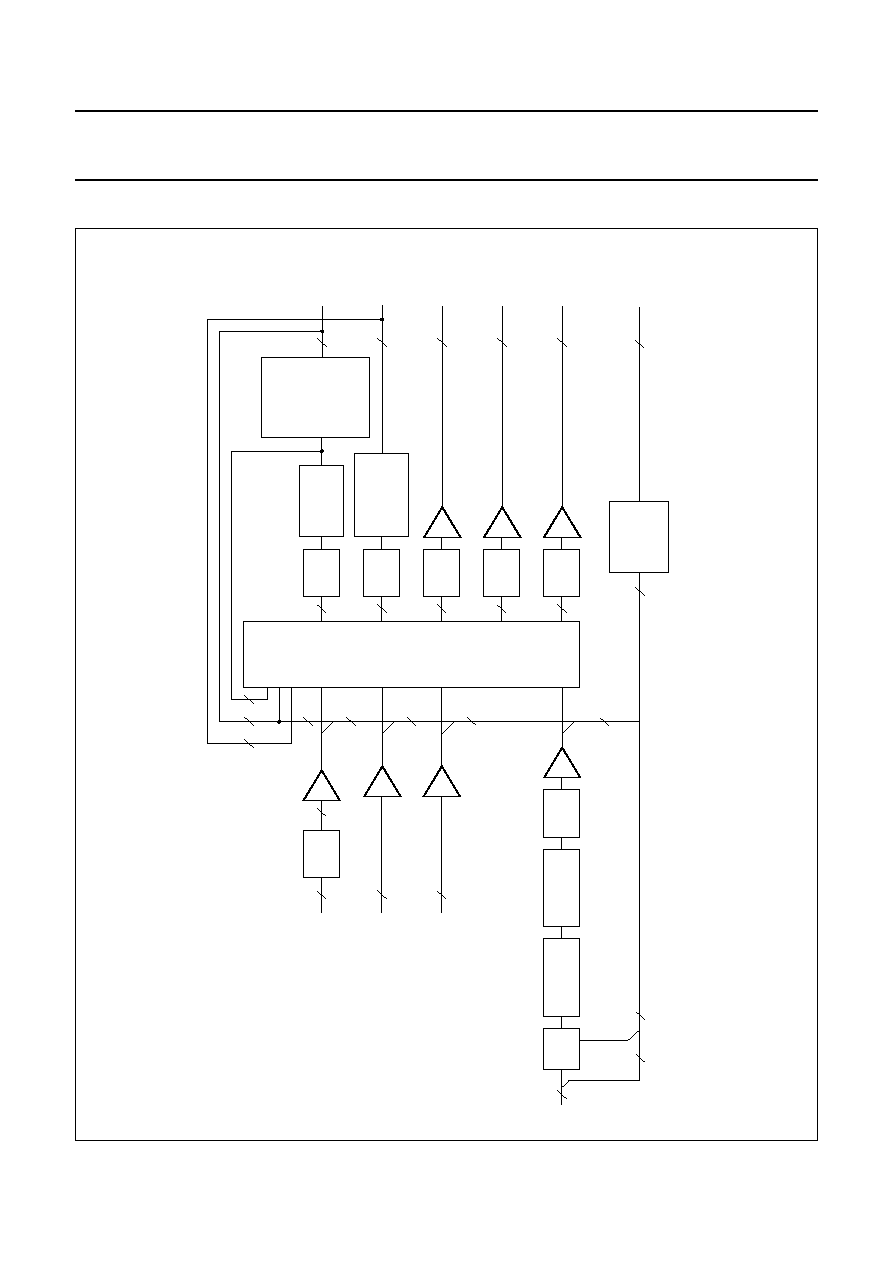
1999
Dec
20
13
Philips Semiconductors
Product specification
Digital TV Sound Processor (DTVSP)
TD
A9870A
This text is here in white to force landscape pages to be rotated correctly when browsing through the pdf in the Acrobat reader.This text is here in
_
white to force landscape pages to be rotated correctly when browsing through the pdf in the Acrobat reader.This text is here inThis text is here in
white to force landscape pages to be rotated correctly when browsing through the pdf in the Acrobat reader. white to force landscape pages to be ...
6.2
Digital signal pr
ocessing
ha
ndbook, full pagewidth
MHB112
2
from ADC
2
2
2
2
LEVEL ADJUST
LEVEL ADJUST
DIGITAL
CROSSBAR
SELECT
2
LEVEL ADJUST
LEVEL ADJUST AND MUTE
LEVEL ADJUST AND MUTE
LEVEL ADJUST
LEVEL ADJUST
2
DC
FILTER
MONITOR
SELECT
PEAK
DETECTION
2
2
2
2
2
14
2
FM
2
4
MATRIX
FIXED
DE-EMPHASIS
2
1
MATRIX
2
MATRIX
2
MATRIX
2
MATRIX
VOLUME
SOFT-MUTE
BASS/TREBLE
BEEPER
2
Main
Auxiliary
I
2
S1
I
2
S2
DAC
I
2
C-bus
MATRIX
AUTOMATIC
VOLUME
LEVEL
SPATIAL
PSEUDO
VOLUME
BASS/TREBLE
BASS BOOST
CONTOUR
SOFT-MUTE
BEEPER
ADAPTIVE
DE-EMPHASIS
DC
FILTER
I
2
S1
I
2
S2
10
8
6
4
2
Fig.5 DSP data flow diagram.

1999 Dec 20
14
Philips Semiconductors
Product specification
Digital TV Sound Processor (DTVSP)
TDA9870A
6.2.1
L
EVEL SCALING
All input channels to the digital crossbar switch (except for
the loudspeaker feedback path) are equipped with a level
adjust facility to change the signal level in a range from
+
15 to
-
15 dB (see Fig.5). It is recommended to scale all
input channels to be 15 dB below full-scale (
-
15 dB
full-scale) under nominal conditions.
6.2.2
FM (AM)
PATH
A high-pass filter suppresses DC offsets from the
FM demodulator, due to carrier frequency offsets, and
supplies the monitor/peak function with DC values and an
unfiltered signal, e.g. for the purpose of carrier detection.
The de-emphasis function offers fixed settings for the
supported standards (50, 60 and 75
µ
s).
An adaptive de-emphasis is available for
Wegener-Panda 1 encoded programs.
A matrix performs the dematrixing of the A2 stereo, dual
and mono signals.
6.2.3
M
ONITOR
This function provides data words from a number of
locations of the signal processing paths to the I
2
C-bus
interface (2 data bytes). Signal sources include the
FM demodulator outputs, most inputs to the digital
crossbar switch and the outputs of the ADC. Source
selection and data read-out is performed via the I
2
C-bus.
Optionally, the peak value can be measured instead of
simply taking samples. The internally stored peak value is
reset to zero when the data is read via the I
2
C-bus.
The monitor function may be used, for example, for signal
level measurements or carrier detection.
6.2.4
L
OUDSPEAKER
(M
AIN
)
CHANNEL
The matrix provides the following functions: forced mono,
stereo, channel swap, channel 1, channel 2 and spatial
effects.
There are fixed coefficient sets for spatial settings of 30%,
40% and 52%.
The Automatic Volume Level (AVL) function provides a
constant output level of
-
23 dB full-scale for input levels
between 0 and
-
29 dB full-scale. There are some fixed
decay time constants to choose from, i.e. 2, 4 and 8 s.
Pseudo stereo is based on a phase shift in one channel via
a second-order all-pass filter. There are fixed coefficient
sets to provide 90 degrees phase shift at frequencies of
150, 200 and 300 Hz.
Volume is controlled individually for each channel ranging
from +24 to
-
83 dB with 1 dB resolution. There is also a
mute position. For the purpose of a simple control software
in the microcontroller, the decimal number that is sent as
an I
2
C-bus data byte for volume control is identical to the
volume setting in dBs (e.g. the I
2
C-bus data byte +10 sets
the new volume value to +10 dB).
Balance can be realized by independent control of the left
and right channel volume settings.
Contour is adjustable between 0 and +18 dB with 1 dB
resolution. This function is linked to the volume setting by
means of microcontroller software.
Bass is adjustable between +15 and
-
12 dB with 1 dB
resolution and treble is adjustable between
+12 and
-
12 dB with 1 dB resolution.
For the purpose of a simple control software in the
microcontroller, the decimal number that is sent as an
I
2
C-bus data byte for contour, bass or treble is identical to
the new contour, bass or treble setting in dBs (e.g. the
I
2
C-bus data byte +8 sets the new value to +8 dB).
Extra bass boost is provided up to 20 dB with 2 dB
resolution. The implemented coefficient set serves merely
as an example on how to use this filter.
The beeper provides tones in a range from approximately
400 Hz to 30 kHz. The frequency can be selected via the
I
2
C-bus. The beeper output signal is added to the
loudspeaker and headphone channel signals. The beeper
volume is adjustable with respect to full-scale between
0 and
-
93 dB with 3 dB resolution. The beeper is not
effected by mute.
Soft mute provides a mute ability in addition to volume
control with a well defined time (32 ms) after which the soft
mute is completed. A smooth fading is achieved by a
cosine masking.
6.2.5
H
EADPHONE
(A
UXILIARY
)
CHANNEL
The matrix provides the following functions: forced mono,
stereo, channel swap, channel 1 and channel 2
(or C and S in Dolby Surround Pro Logic mode).
Volume is controlled individually for each channel in a
range from +24 to
-
83 dB with 1 dB resolution. There is
also a mute position.
For the purpose of a simple control software in the
microcontroller, the decimal number that is sent as an
I
2
C-bus data byte for volume control is identical to the
volume setting in dB (e.g. the I
2
C-bus data byte +10 sets
the new volume value to +10 dB).

1999 Dec 20
15
Philips Semiconductors
Product specification
Digital TV Sound Processor (DTVSP)
TDA9870A
Balance can be realized by independent control of the left
and right channel volume settings.
Bass is adjustable between +15 and
-
12 dB with 1 dB
resolution and treble is adjustable between
+12 and
-
12 dB with 1 dB resolution.
For the purpose of a simple control software in the
microcontroller, the decimal number that is sent as an
I
2
C-bus data byte for bass or treble is identical to the new
bass or treble setting in dB (e.g. the I
2
C-bus data byte +8
sets the new value to +8 dB).
The beeper provides tones in a range from approximately
400 Hz to 30 kHz. The frequency can be selected via the
I
2
C-bus. The beeper output signal is added to the
loudspeaker and headphone channel signals. The beeper
volume is adjustable with respect to full-scale between
0 and
-
93 dB with 3 dB resolution. The beeper is not
effected by mute.
Soft mute provides a mute ability in addition to volume
control with a well defined time (32 ms) after which the soft
mute is completed. A smooth fading is achieved by a
cosine masking.
6.2.6
F
EATURE INTERFACE
The feature interface comprises two I
2
S-bus input/output
ports and a system clock output. Each I
2
S-bus port is
equipped with level adjust facilities that can change the
signal level in a range from +15 to
-
15 dB with 1 dB
resolution. Outputs can be disabled to improve EMC
performance.
The I
2
S-bus output matrix provides the following functions:
forced mono, stereo, channel swap, channel 1 and
channel 2.
One example of how the feature interface can be used in
a TV set is to connect an external Dolby Surround Pro
Logic DSP, such as the SAA7710, to the I
2
S-bus ports.
Outputs must be enabled and a suitable master clock
signal for the DSP can be taken from pin SYSCLK.
A stereo signal from any source will be output on one of
the I
2
S-bus serial data outputs and the four processed
signal channels will be entered at both I
2
S-bus serial data
inputs. Left and right could then be output to the power
amplifiers via the Main channel, centre and surround via
the Auxiliary channel.
6.2.7
C
HANNEL FROM THE AUDIO
ADC
The signal level at the output of the ADC can be adjusted
in a range from +15 to
-
15 dB with 1 dB resolution.
The audio ADC itself is scaled to a gain of
-
6 dB.
6.2.8
C
HANNEL TO THE ANALOG CROSSBAR PATH
Level adjust with control positions 0, +3, +6 and +9 dB.
6.2.9
D
IGITAL CROSSBAR SWITCH
Input channels to the crossbar switch are from the audio
ADC, I
2
S1, I
2
S2, FM path and from the loudspeaker
channel path after matrix and AVL (see Fig.6).
Output channels comprise loudspeaker, headphone, I
2
S1,
I
2
S2 and the audio DACs for line output and SCART.
The I
2
S1 and I
2
S2 outputs also provide digital outputs from
the loudspeaker and headphone channels, but without the
beeper signals.
6.2.10
S
IGNAL GAIN
There are a number of functions that can provide signal
gain, e.g. volume, bass and treble control. Great care has
to be taken when using gain with large input signals in
order not to exceed the maximum possible signal swing,
which would cause severe signal distortion. The nominal
signal level of the various signal sources to the digital
crossbar switch should be 15 dB below digital full-scale
(
-
15 dB full-scale). This means that a volume setting of,
say, +15 dB would just produce a full-scale output signal
and not cause clipping, if the signal level is nominal.
Sending illegal data patterns via the I
2
C-bus will not cause
any changes of the current setting for the volume, bass,
treble, bass boost and level adjust functions.
6.2.11
E
XPERT MODE
The TDA9870A provides a special expert mode that gives
direct write access to the internal Coefficient RAM (CRAM)
of the DSP. It can be used to create user-defined
characteristics, such as a tone control with different corner
frequencies or special boost/cut characteristics to correct
the low-frequency loudspeaker and/or cabinet frequency
responses by means of the bass boost filter. However, this
mode must be used with great care.
More information on the functions of this device, such as
the number of coefficients per function, their default
values, memory addresses etc., can be made available on
request.
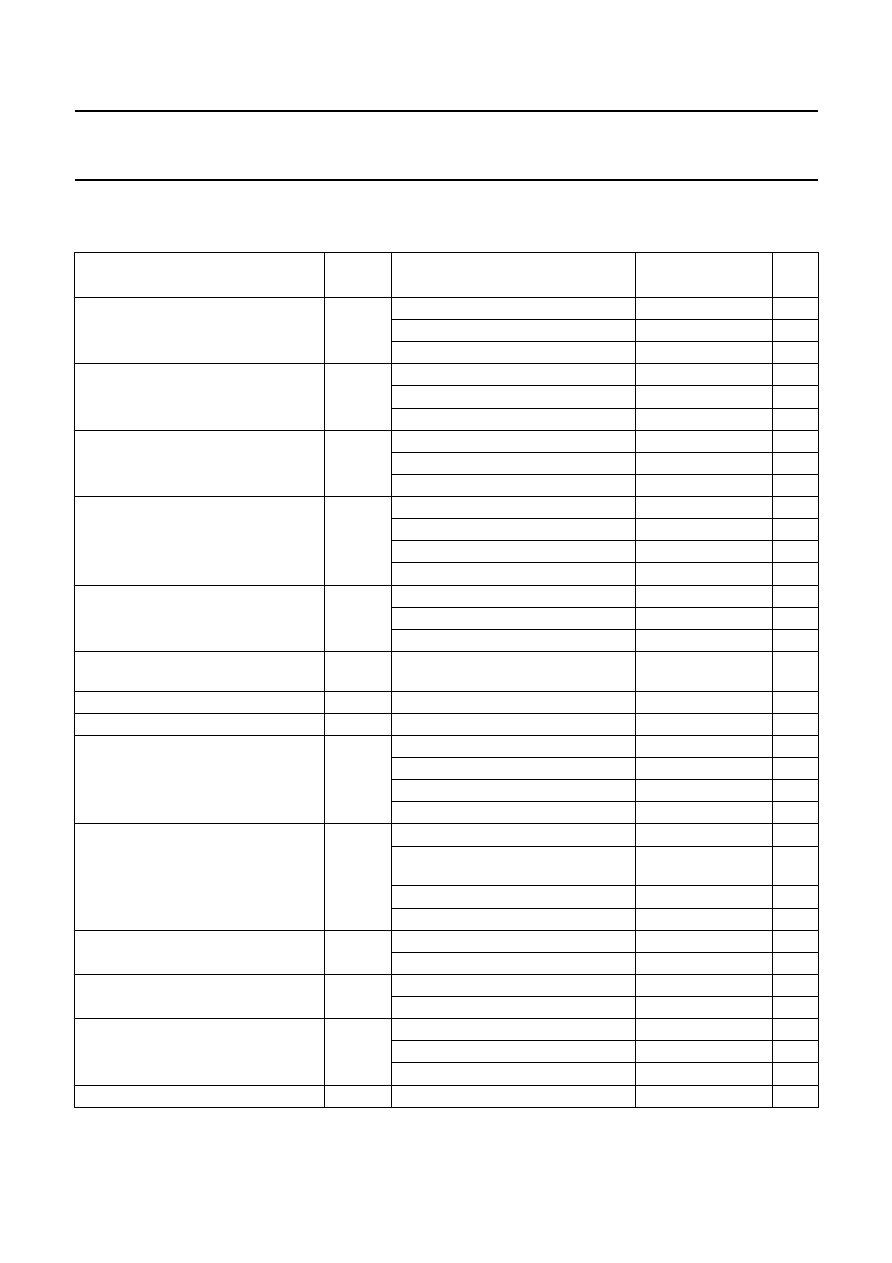
1999 Dec 20
16
Philips Semiconductors
Product specification
Digital TV Sound Processor (DTVSP)
TDA9870A
6.2.12
DSP
FUNCTIONS
Table 4
Overview of DSP functions
FUNCTION
EXPERT
MODE
PARAMETER
VALUE
UNIT
Bass control for loudspeaker and
headphone output
yes
control range
-
12 to +15
dB
resolution
1
dB
resolution at frequency
40
Hz
Treble control for loudspeaker and
headphone output
yes
control range
-
12 to +12
dB
resolution
1
dB
resolution at frequency
14
kHz
Contour for loudspeaker output
yes
control range
0 to +18
dB
resolution
1
dB
resolution at frequency
40
Hz
Bass boost for loudspeaker output
yes
control range
0 to +20
dB
resolution
2
dB
resolution at frequency
20
Hz
corner frequency
350
Hz
Volume control for each separate
channel in loudspeaker and
headphone output
no
control range
-
83 to +24
dB
resolution
1
dB
mute position at step
10101100
Soft mute for loudspeaker and
headphone output
no
processing time
32
ms
Spatial effects
yes
anti-phase crosstalk positions
30, 40 and 52
%
Pseudo stereo
yes
90 degrees phase shift at frequency
150, 200 and 300
Hz
Beeper additional to the signal in the
loudspeaker and headphone channel
yes
beep frequencies
see Section 10.3.38
control range
0 to
-
93
dB
resolution
3
dB
mute position at step
00100000
Automatic Volume Level (AVL)
yes
step width
quasi continuously
AVL output level for an input level
between 0 and
-
29 dB full-scale
-
23
dB
attack time
10
ms
decay time constant
2, 4 and 8
s
General
no
-
3 dB lower corner frequency of DSP 10
Hz
-
1 dB bandwidth of DSP
14.5
kHz
Level adjust I
2
S1 and I
2
S2 inputs
yes
control range
-
15 to +15
dB
resolution
1
dB
Level adjust I
2
S1 and I
2
S2 outputs
yes
control range
-
15 to +15
dB
resolution
1
dB
mute position at step
00010000
Level adjust analog crossbar path
no
control positions
0, 3, 6 and 9
dB
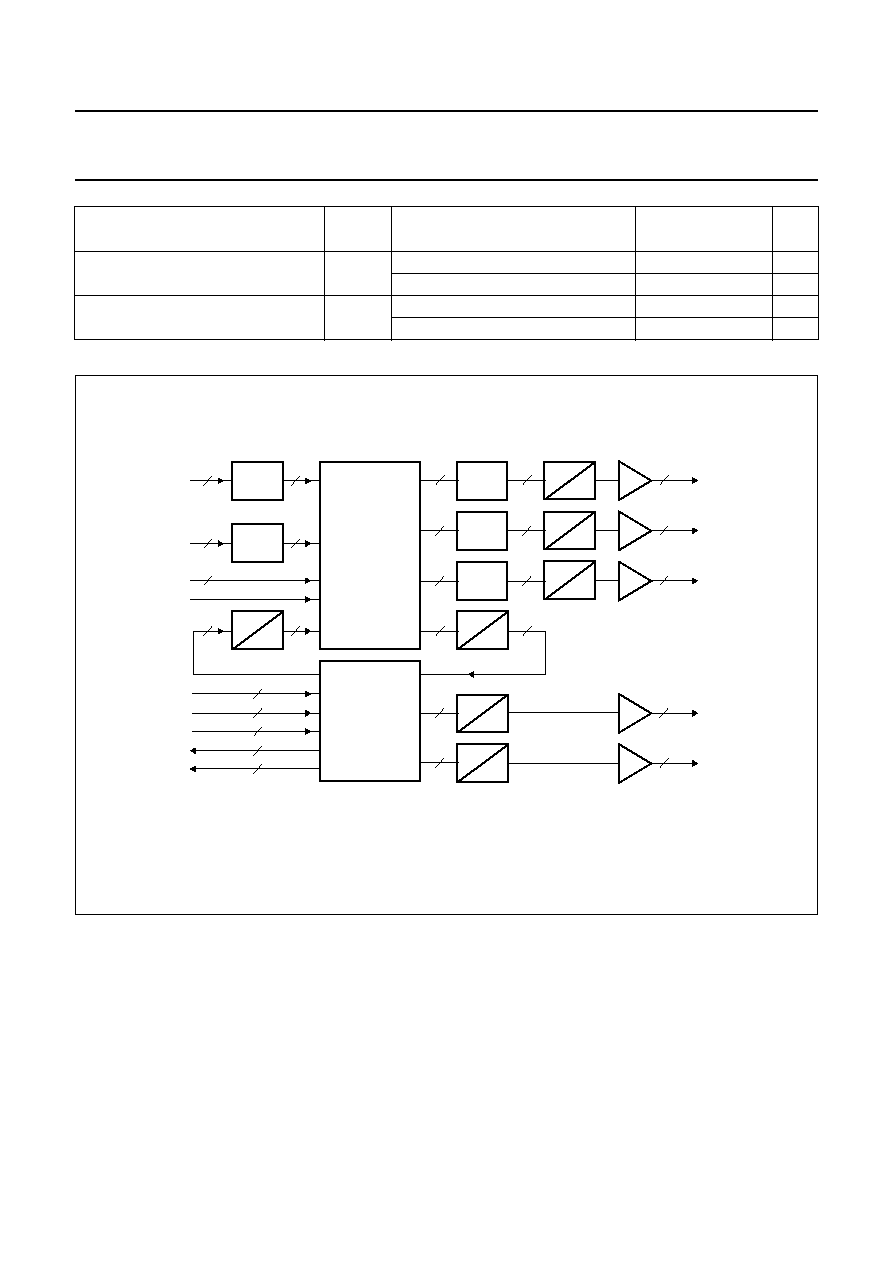
1999 Dec 20
17
Philips Semiconductors
Product specification
Digital TV Sound Processor (DTVSP)
TDA9870A
6.3
Analog audio section
Level adjust audio ADC outputs
yes
control range
+15 to
-
15
dB
resolution
1
dB
Level adjust FM path
yes
control range
+15 to
-
15
dB
resolution
1
dB
FUNCTION
EXPERT
MODE
PARAMETER
VALUE
UNIT
handbook, full pagewidth
MHB113
-
3 dB
2
SCART 1
2
2
2
2
2
2
2
2
SCART 1
SCART 2
Line output
2
2
Main
Auxiliary
2
2
2
2
2
-
3 dB
2
SCART 2
2
external
mono
2
ANALOG
CROSSBAR
SWITCH
ANALOG
MATRIX
ANALOG
MATRIX
ANALOG
MATRIX
2
2
2
2
2
I
2
S1
I
2
S1
FM
I
2
S2
I
2
S2
2
D
A
2
D
A
2
D
A
A
D
3 dB
0 dB
3 dB
0 dB
3 dB
0 dB
DSP
AND
DIGITAL
CROSSBAR
SWITCH
Fig.6 Block diagram for the audio section.

1999 Dec 20
18
Philips Semiconductors
Product specification
Digital TV Sound Processor (DTVSP)
TDA9870A
6.3.1
A
NALOG CROSSBAR SWITCH AND ANALOG MATRIX
There are a number of analog input and output ports with
the TDA9870A (see Figs 6 and 8). Analog source selector
switches are employed to provide the desired analog
signal routing capability. The analog signal routing is
performed by the analog crossbar switch section. A dual
audio ADC provides the connection to the DSP section
and a dual audio DAC provides the connection from the
DSP section to the analog crossbar switch. The digital
signal routing is performed by a digital crossbar switch.
The basic signal routing philosophy of the TDA9870A is
that each switch handles two signal channels at the same
time, e.g. left and right, language A and B, directly at the
source.
Each source selector switch is followed by an analog
matrix to perform further selection tasks, such as putting a
signal from one input channel, say language A, to both
output channels or for swapping left and right channels
(see Fig.7).
The analog matrix provides the functions given in Table 5.
Table 5
Analog matrix functions
All switches and matrices are controlled via the I
2
C-bus.
6.3.2
SCART
INPUTS
The SCART specification allows for a signal level of up to
2 V (RMS). Because of signal handling limitations, due to
the 5 V supply voltage of the TDA9870A, it is necessary to
have fixed 3 dB attenuators at the SCART inputs to obtain
a 2 V input. This results in a
-
3 dB SCART-to-SCART
copy gain. If 0 dB copy gain is preferred (with maximum
1.4 V input), there are 3 and 0 dB amplifiers at the outputs
of SCART 1 and SCART 2 and at the line output.
The input attenuator is realized by an external series
resistor in combination with the input impedance, both of
which form a voltage divider. With this voltage divider the
maximum SCART signal level of 2 V (RMS) is scaled
down to 1.4 V (RMS) at the input pin.
6.3.3
E
XTERNAL AND MONO INPUTS
The 3 dB input attenuators are not required for the external
and mono inputs, because those signal levels are under
control of the TV designer. The maximum allowed input
level is 1.4 V (RMS). By adding external series resistors,
the external inputs can be used as an additional SCART
input.
6.3.4
SCART
OUTPUTS
The SCART outputs employ amplifiers with two gain
settings. The gain can be set to 3 or 0 dB via the I
2
C-bus.
The 3 dB position is needed to compensate for the 3 dB
attenuation at the SCART inputs should
SCART-to-SCART copies with 0 dB gain be preferred
[under the condition of 1.4 V (RMS) maximum input level].
The 0 dB position is needed, for example, for an
external-to-SCART copy with 0 dB gain.
MODE
MATRIX OUTPUT
LEFT OUTPUT
RIGHT OUTPUT
1
left input
right input
2
right input
left input
3
left input
left input
4
right input
right input
handbook, halfpage
MGK110
ANALOG
MATRIX
left input
right input
left output
right output
Fig.7 Analog matrix.

1999 Dec 20
19
Philips Semiconductors
Product specification
Digital TV Sound Processor (DTVSP)
TDA9870A
6.3.5
L
INE OUTPUT
The line output can provide an unprocessed copy of the
audio signal in the loudspeaker channels. This can be
either an external signal that comes from the dual audio
ADC, or a signal from an internal digital audio source that
comes from the dual audio DAC. The line output employs
amplifiers with two gain settings. The 3 dB position is
needed to compensate for the attenuation at the SCART
inputs, while the 0 dB position is needed, for example, for
non-attenuated external or internal digital signals
(see Section 6.3.4).
6.3.6
L
OUDSPEAKER
(M
AIN
)
AND HEADPHONE
(A
UXILIARY
)
OUTPUTS
Signals from any audio source can be applied to the
loudspeaker and to the headphone output channels via the
digital crossbar switch and the DSP.
6.3.7
D
UAL AUDIO
DAC
The TDA9870A contains three dual audio DACs, one for
the connection from the DSP to the analog crossbar switch
section and two for the loudspeaker and headphone
outputs. Each of the three dual low-noise high-dynamic
range DACs consists of two 15-bit DACs with current
outputs, followed by a buffer operational amplifier.
The audio DACs operate with four-fold oversampling and
noise shaping.
6.3.8
D
UAL AUDIO
ADC
There is one dual audio ADC in the TDA9870A for the
connection of the analog crossbar switch section to the
DSP. The dual audio ADC consists of two bitstream
3rd-order sigma-delta audio ADCs and a high-order
decimation filter.
6.3.9
S
TANDBY MODE
The standby mode, selected by setting bit STDBY to
logic 1 (see Section 10.3.2) disables most functions and
reduces power dissipation. The analog crossbar switch
and the SCART section remain operational and can be
controlled by the I
2
C-bus to support copying of analog
signals from SCART-to-SCART.
Unused internal registers may lose their information in the
standby mode. Therefore, the device needs to be
initialized on returning to the normal operating mode. This
can be accomplished in the same way as after a Power-on
reset.
6.3.10
S
UPPLY GROUND
The different supply grounds V
SS
are internally connected
via the substrate. It is recommended to connect all ground
pins by a copper plane close to the pins.

1999
Dec
20
20
Philips Semiconductors
Product specification
Digital TV Sound Processor (DTVSP)
TD
A9870A
This text is here in white to force landscape pages to be rotated correctly when browsing through the pdf in the Acrobat reader.This text is here in
_
white to force landscape pages to be rotated correctly when browsing through the pdf in the Acrobat reader.This text is here inThis text is here in
white to force landscape pages to be rotated correctly when browsing through the pdf in the Acrobat reader. white to force landscape pages to be ...
a
ndbook, full pagewidth
MHB114
SCART 1
SCART 2
FM/AM
part
external
ADC
-
6 dB
mono
FM
LEVEL
ADJUST
ADC
LEVEL
ADJUST
DAC
I
2
S2
OUTPUT
LEVEL
ADJUST
DAC
GAIN
DAC
Main
Auxiliary
Line
SCART 1
SCART 2
I
2
S1
I
2
S2
DAC
DIGITAL
MATRIX
DIGITAL
MATRIX
BUFFER
0/
+
3 dB
BUFFER
0/
+
3 dB
BUFFER
0/
+
3 dB
ANALOG
MATRIX
ANALOG
MATRIX
ANALOG
MATRIX
I
2
S1
OUTPUT
LEVEL
ADJUST
DIGITAL
MATRIX
DIGITAL
MATRIX
DIGITAL
MATRIX
AUTOMATIC
VOLUME
LEVEL
LOUDSPEAKER
CHANNEL
PROCESSING
HEADPHONE
CHANNEL
PROCESSING
STEREO
DECODER
FIXED
DE-EMPHASIS
ADAPTIVE
DE-EMPHASIS
FM/AM
DEMODULATOR
I
2
S1
INPUT
LEVEL
ADJUST
I
2
S2
INPUT
LEVEL
ADJUST
I
2
S1
I
2
S2
Fig.8 Audio signal flow diagram.
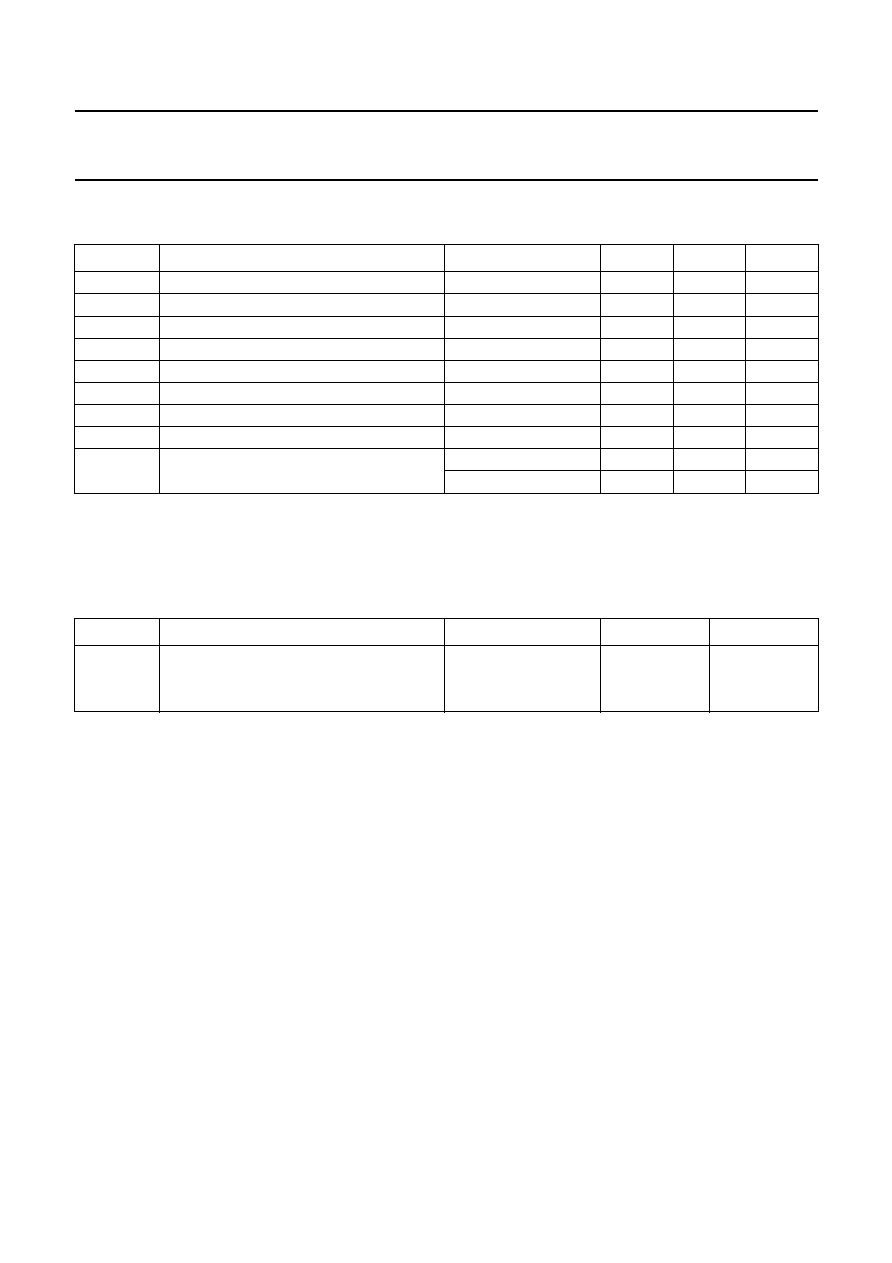
1999 Dec 20
21
Philips Semiconductors
Product specification
Digital TV Sound Processor (DTVSP)
TDA9870A
7
LIMITING VALUES
In accordance with the Absolute Maximum Rating System (IEC 134).
Notes
1. Human body model: C = 100 pF; R = 1.5 k
.
2. Machine model: C = 200 pF; L = 0.75
µ
H; R = 0
.
8
THERMAL CHARACTERISTICS
SYMBOL
PARAMETER
CONDITIONS
MIN.
MAX.
UNIT
V
DD
DC supply voltage
-
0.5
+6.0
V
V
DD
voltage differences between two V
DD
pins
-
550
mV
V
n
voltage on any other pin
-
0.5
V
DD
+ 0.5 V
I
DDD
,I
SSD
DC current per digital supply pin
-
±
180
mA
I
lu(prot)
latch-up protection current
100
-
mA
P
tot
total power dissipation
-
1.0
W
T
stg
storage temperature
-
55
+125
∞
C
T
amb
ambient temperature
-
20
+70
∞
C
V
es
electrostatic handling voltage
note 1
-
2000
+2000
V
note 2
-
200
+200
V
SYMBOL
PARAMETER
CONDITIONS
VALUE
UNIT
R
th(j-a)
thermal resistance from junction to ambient
in free air
TDA9870A (SDIP64)
40
K/W
TDA9870AH (QFP64)
50
K/W
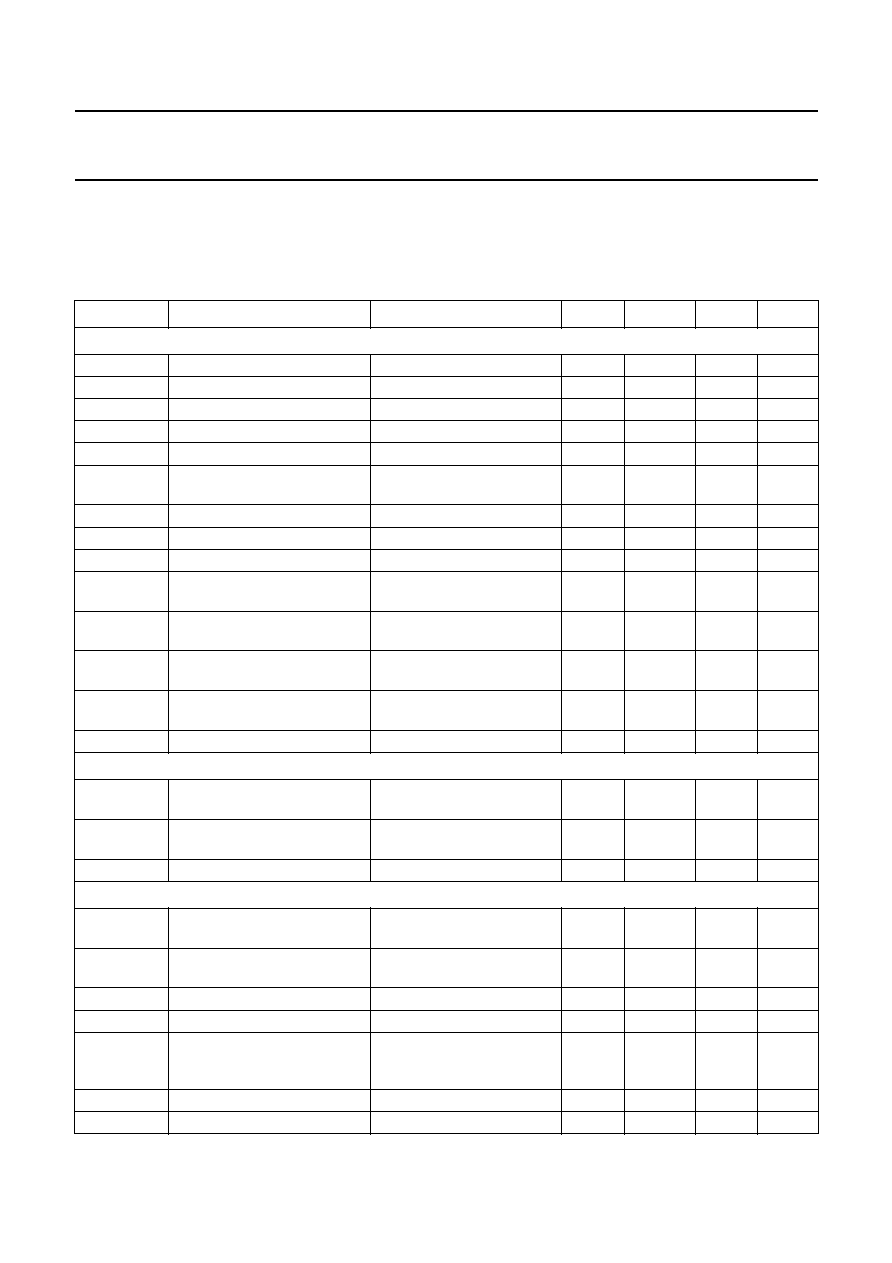
1999 Dec 20
22
Philips Semiconductors
Product specification
Digital TV Sound Processor (DTVSP)
TDA9870A
9
CHARACTERISTICS
V
SIF(p-p)
= 300 mV; AGCOFF = 0; AGCSLOW = 0; AGCLEV = 0; level and gain settings in accordance with note 1;
V
DD
= 5 V; T
amb
= 25
∞
C; settings in accordance with B/G standard; FM deviation
±
50 kHz; f
mod
= 1 kHz; FM sound
parameters in accordance with system A2; 1 k
measurement source resistance for AF inputs; with external
components of Fig.10; unless otherwise specified.
SYMBOL
PARAMETER
CONDITIONS
MIN.
TYP.
MAX.
UNIT
Supplies
V
DDD1
digital supply voltage 1
4.75
5.0
5.5
V
V
SSD1
digital supply ground 1
note 2
-
0.0
-
V
I
DDD1
digital supply current 1
V
DDD1
= 5.0 V
53
68
83
mA
V
DDD2
digital supply voltage 2
4.75
5.0
5.5
V
V
SSD2
digital supply ground 2
note 2
-
0.0
-
V
I
DDD2
digital supply current 2
V
DDD2
= 5.0 V; system clock
output disabled
0.1
0.4
2
mA
V
SSD3
digital supply ground 3
note 2
-
0.0
-
V
V
SSD4
digital supply ground 4
note 2
-
0.0
-
V
V
DDA
analog supply voltage
4.75
5.0
5.5
V
I
DDA
analog supply current for
DAC part
V
DDA
= 5.0 V; digital silence
44
56
68
mA
V
SSA1
analog ground for analog
front-end
note 2
-
0.0
-
V
V
SSA2
analog ground for audio ADC
part
note 2
-
0.0
-
V
V
SSA3
analog ground for audio DAC
part
note 2
-
0.0
-
V
V
SSA4
analog ground for SCART
-
0.0
-
V
Demodulator supply decoupling and references
V
DEC1
analog supply decoupling
voltage for demodulator part
3.0
3.3
3.6
V
V
ref1
analog reference voltage for
demodulator part
-
2
-
V
I
ref1(sink)
sink current at pin V
ref1
-
200
-
µ
A
Audio supply decoupling and references
V
DEC2
analog supply decoupling
voltage for audio ADC part
3.0
3.3
3.6
V
V
ref2
reference voltage ratio for
audio ADCs
referenced to V
DEC2
and
V
SSA2
-
50
-
%
Z
Vref2-VDEC2
impedance pins V
ref2
to V
DEC2
-
20
-
k
Z
Vref2-VSSA2
impedance pins V
ref2
to V
SSA2
-
20
-
k
V
ref3
reference voltage ratio for
audio DAC and operational
amplifier
referenced to V
DDA
and
V
SSA3
-
50
-
%
Z
Vref3-VDDA
impedance pins V
ref3
to V
DDA
-
20
-
k
Z
Vref3-VSSA3
impedance pins V
ref3
to V
SSA3
-
20
-
k

1999 Dec 20
23
Philips Semiconductors
Product specification
Digital TV Sound Processor (DTVSP)
TDA9870A
Power fail detector
V
th(pf)
power fail threshold voltage
-
3.9
-
V
Digital inputs and outputs
I
NPUTS
CMOS level input, pull-down (pins TEST1 and TEST2)
V
IL
LOW-level input voltage
-
-
0.3V
DDD
V
V
IH
HIGH-level input voltage
0.7V
DDD
-
-
V
C
i
input capacitance
-
-
10
pF
Z
i
input impedance
-
50
-
k
CMOS level input, hysteresis, pull-up (pin CRESET)
V
IL
LOW-level input voltage
-
-
0.3V
DDD
V
V
IH
HIGH-level input voltage
0.7V
DDD
-
-
V
V
hys
hysteresis voltage
-
1.3
-
V
C
i
input capacitance
-
-
10
pF
Z
i
input impedance
30
50
-
k
I
NPUTS
/
OUTPUTS
I
2
C-bus level input with Schmitt trigger, open-drain output stage, 400 kHz I
2
C-bus operation (pins SCL and SDA)
V
IL
LOW-level input voltage
-
-
0.3V
DDD
V
V
IH
HIGH-level input voltage
0.7V
DDD
-
-
V
V
hys
hysteresis voltage
-
0.05V
DDD
-
V
I
LI
input leakage current
-
-
±
10
µ
A
C
i
input capacitance
-
-
10
pF
V
OL
LOW-level output voltage
-
-
0.6
V
C
L
load capacitance
-
-
400
pF
TTL/CMOS level, 4 mA 3-state output stage, pull-up (pins ADDR1, ADDR2, P1, P2, SCK, WS, SDO1, SDO2, SDI1
and SDI2)
V
IL
LOW-level input voltage
-
-
0.8
V
V
IH
HIGH-level input voltage
2.0
-
-
V
C
i
input capacitance
-
-
10
pF
V
OL
LOW-level output voltage
-
-
0.4
V
V
OH
HIGH-level output voltage
2.4
-
-
V
C
L
load capacitance
-
-
100
pF
Z
i
input impedance
-
50
-
k
O
UTPUTS
CMOS level output, 4 mA 3-state output stage, slew rate controlled (pin SYSCLK)
V
OL
LOW-level output voltage
-
-
0.3V
DDD
V
V
OH
HIGH-level output voltage
0.7V
DDD
-
-
V
C
L
load capacitance
-
-
100
pF
I
LIZ
3-state leakage current
V
i
= 0 to V
DDD
-
-
±
10
µ
A
SYMBOL
PARAMETER
CONDITIONS
MIN.
TYP.
MAX.
UNIT

1999 Dec 20
24
Philips Semiconductors
Product specification
Digital TV Sound Processor (DTVSP)
TDA9870A
SIF1 and SIF2 analog inputs
V
SIF(max)(p-p)
maximum composite SIF input
voltage for clipping
(peak-to-peak value)
SIF input level adjust 0 dB
-
941
-
mV
SIF input level adjust
-
10 dB
-
2976
-
mV
V
SIF(min)(p-p)
minimum composite SIF input
voltage for lower limit of AGC
(peak-to-peak value)
SIF input level adjust 0 dB
-
59
-
mV
SIF input level adjust
-
10 dB
-
188
-
mV
AGC
AGC range
-
24
-
dB
f
i
input frequency
4
-
9.2
MHz
R
i
input resistance
AGCLEV = 0
10
-
-
k
C
i
input capacitance
-
7.5
11
pF
f
FM
FM deviation
B/G standard; THD < 1%
±
100
-
-
kHz
f
FM(FS)
FM deviation full-scale level
terrestrial FM; level adjust
0 dB
±
150
-
-
kHz
C/N
FM
FM carrier-to-noise ratio
N
FM
bandwidth = 6 MHz;
white noise for S/N = 40 dB;
"CCIR468"; quasi peak
-
77
-
ct
crosstalk attenuation
SIF1 to SIF2
f
i
= 4 to 9.2 MHz; note 3
50
-
-
dB
Demodulator performance
THD + N
total harmonic distortion plus
noise
from FM source to any
output; V
o
= 1 V (RMS) with
low-pass filter
-
0.3
0.5
%
S/N
signal-to-noise ratio
SC1 from FM source to any
output; V
o
= 1 V (RMS);
"CCIR468"; quasi peak
64
70
-
dB
SC2 from FM source to any
output; V
o
= 1 V (RMS);
"CCIR468"; quasi peak
60
66
-
dB
B
-
3dB
-
3 dB bandwidth
from FM source to any
output
14.5
15
-
kHz
f
res
frequency response
20 Hz to 14 kHz
from FM to any output;
f
ref
= 1 kHz; inclusive
pre-emphasis and
de-emphasis
-
±
2
-
dB
cs(dual)
dual signal channel separation note 4
65
70
-
dB
cs(stereo)
stereo channel separation
note 5
40
45
-
dB
AM
AM suppression for FM
AM: 1 kHz, 30% modulation;
reference: 1 kHz, 50 kHz
deviation
50
-
-
dB
S/N
AM
AM demodulation
SIF level 100 mV (RMS);
54% AM; 1 kHz AF;
"CCIR468"; quasi peak
36
45
-
dB
SYMBOL
PARAMETER
CONDITIONS
MIN.
TYP.
MAX.
UNIT
dB
Hz
-------
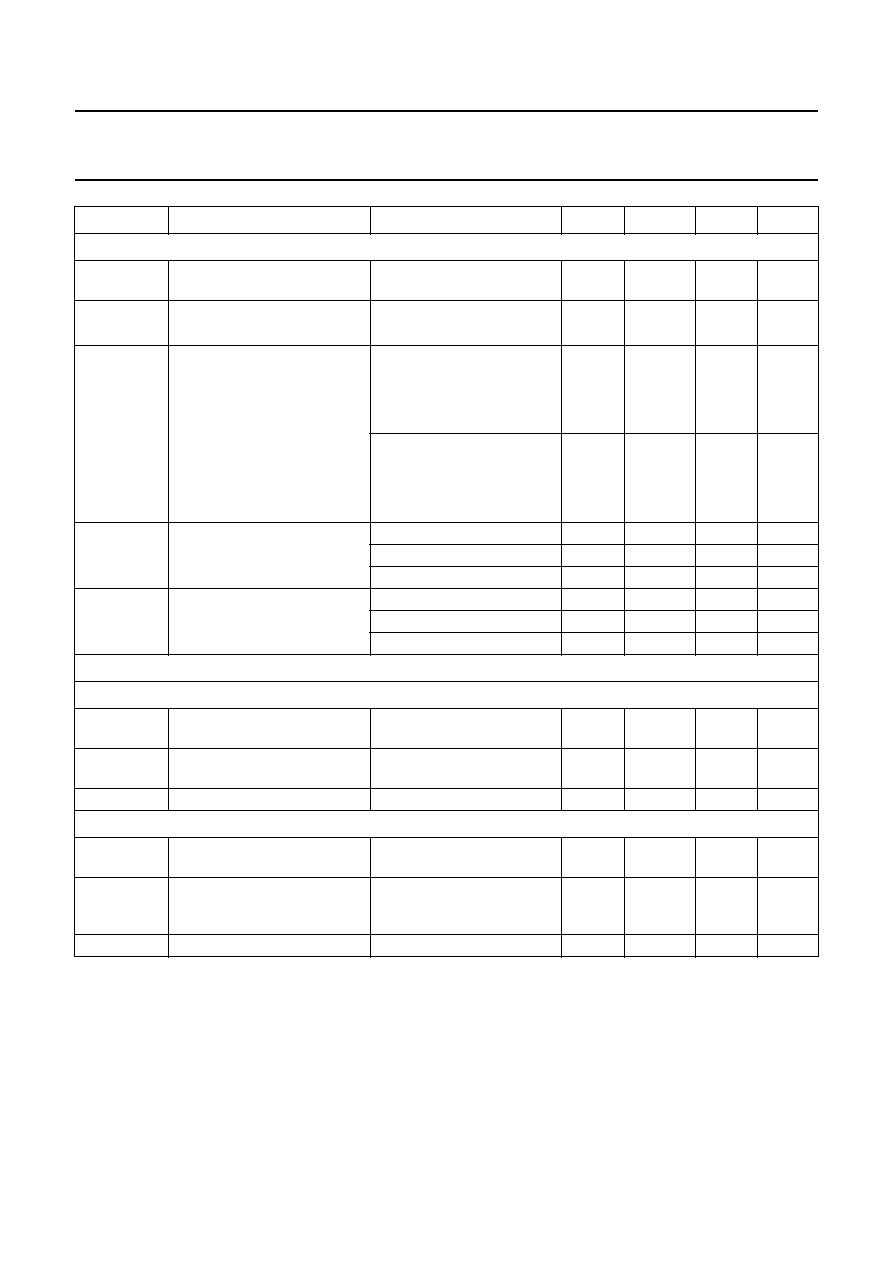
1999 Dec 20
25
Philips Semiconductors
Product specification
Digital TV Sound Processor (DTVSP)
TDA9870A
I
DENTIFICATION FOR
FM
SYSTEMS
mod
p
pilot modulation for
identification
25
50
75
%
C/N
p
pilot sideband carrier-to-noise
ratio for identification start
-
27
-
f
ident
identification window
B/G stereo
slow mode
116.85
-
118.12
Hz
medium mode
116.11
-
118.89
Hz
fast mode
114.65
-
120.46
Hz
B/G dual
slow mode
273.44
-
274.81
Hz
medium mode
272.07
-
276.20
Hz
fast mode
270.73
-
277.60
Hz
t
ident(on)
total identification time ON
slow mode
-
-
2
s
medium mode
-
-
1
s
fast mode
-
-
0.5
s
t
ident(off)
total identification time OFF
slow mode
-
-
2
s
medium mode
-
-
1
s
fast mode
-
-
0.5
s
Analog audio inputs
M
ONO INPUT AND EXTERNAL INPUT
V
i(nom)(rms)
nominal level input voltage
(RMS value)
-
500
-
mV
V
i(clip)(rms)
clipping level input voltage
(RMS value)
THD < 3%; note 6
1250
1400
-
mV
R
i
input resistance
note 6
28
35
42
k
SCART
INPUTS
V
i(nom)(rms)
nominal level input voltage at
input pin (RMS value)
-
3 dB divider with external
15 k
resistor; note 7
-
350
-
mV
V
i(clip)(rms)
clipping level input voltage at
input pin (RMS value)
-
3 dB divider with external
15 k
resistor; THD < 3%;
notes 6 and 7
1250
1400
-
mV
R
i
input resistance
note 6
28
35
42
k
SYMBOL
PARAMETER
CONDITIONS
MIN.
TYP.
MAX.
UNIT
dB
Hz
-------

1999 Dec 20
26
Philips Semiconductors
Product specification
Digital TV Sound Processor (DTVSP)
TDA9870A
Analog audio outputs
L
OUDSPEAKER
(M
AIN
)
AND HEADPHONE
(A
UXILIARY
)
OUTPUTS
V
o(clip)(rms)
clipping level output voltage
(RMS value)
THD < 3%
1250
1400
-
mV
R
o
output resistance
150
250
375
R
L(AC)
AC load resistance
10
-
-
k
R
L(DC)
DC load resistance
10
-
-
k
C
L
load capacitance
-
10
12
nF
V
offset(DC)
static DC offset voltage
-
30
70
mV
mute
mute suppression
nominal input signal from
any source; f
i
= 1 kHz
80
-
-
dB
G
ro(main,aux)
roll-off gain at 14.5 kHz for
Main and Auxiliary channels
from any source
-
3
-
2
-
dB
PSRR
main,aux
power supply ripple rejection
for Main and Auxiliary
channels
f
ripple
= 70 Hz;
V
ripple
= 100 mV (peak);
C
Vref
= 47
µ
F;
signal from I
2
S-bus
40
45
-
dB
SCART
OUTPUTS AND LINE OUTPUT
V
o(nom)(rms)
nominal level output voltage
(RMS value)
3 dB amplification
-
500
-
mV
V
o(clip)(rms)
clipping level output voltage
(RMS value)
THD < 3%
1250
1400
-
mV
R
o
output resistance
150
250
375
R
L(AC)
AC load resistance
10
-
-
k
R
L(DC)
DC load resistance
10
-
-
k
C
L
load capacitance
-
-
2.5
nF
V
offset(DC)
static DC offset voltage
output amplifiers at 3 dB
position
-
30
50
mV
mute
mute suppression
nominal input signal from
any source; f
i
= 1 kHz
80
-
-
dB
B
bandwidth
from SCART, external and
mono sources;
-
3 dB bandwidth
20
-
-
kHz
from DSP sources;
-
3 dB bandwidth
14.5
-
-
kHz
PSRR
power supply ripple rejection
f
ripple
= 70 Hz;
V
ripple
= 100 mV (peak);
C
Vref
= 47
µ
F;
signal from I
2
S-bus
40
45
-
dB
SYMBOL
PARAMETER
CONDITIONS
MIN.
TYP.
MAX.
UNIT

1999 Dec 20
27
Philips Semiconductors
Product specification
Digital TV Sound Processor (DTVSP)
TDA9870A
Audio performance
THD + N
total harmonic distortion plus
noise
V
i
= V
o
= 1 V (RMS);
f
i
= 1 kHz; bandwidth
20 Hz to 15 kHz; note 8
from any analog audio
input to I
2
S-bus
-
0.1
0.3
%
from I
2
S-bus to any analog
audio output
-
0.1
0.3
%
SCART-to-SCART copy
-
0.1
0.3
%
SCART-to-Main copy
-
0.2
0.5
%
S/N
signal-to-noise ratio
reference voltage
V
o
= 1.4 V (RMS); f
i
= 1 kHz;
"CCIR468"; quasi peak;
note 8
from any analog audio
input to I
2
S-bus
73
77
-
dB
from I
2
S-bus to any analog
audio output
78
85
-
dB
SCART-to-SCART copy
78
85
-
dB
SCART-to-Main copy
73
77
-
dB
ct
crosstalk attenuation
between any analog input
pairs; f
i
= 1 kHz
70
-
-
dB
between any analog output
pairs; f
i
= 10 kHz
65
-
-
dB
cs
channel separation
between left and right of any
input pair
65
-
-
dB
between left and right of any
output pair
60
-
-
dB
G
A
gain from SCART-to-SCART
with
-
3 dB input voltage
divider
output amplifier in 3 dB
position; R
ext
= 15 k
±
10%
-
1.5
0
+1.1
dB
output amplifier in 0 dB
position; R
ext
= 15 k
±
10%
-
4.5
-
3.0
-
1.9
dB
Crystal specification (fundamental mode)
f
xtal
crystal frequency
-
24.576
-
MHz
C
L
load capacitance
-
20
-
pF
C
1
series capacitance
-
20
-
fF
C
0
parallel capacitance
-
-
7
pF
pull
pulling sensitivity
C
L
changed from
18 to 16 pF
-
25
-
R
R
equivalent series resistance
at nominal frequency
-
-
30
R
N
equivalent series resistance of
unwanted mode
2R
R
-
-
T
temperature range
-
20
+25
+70
∞
C
SYMBOL
PARAMETER
CONDITIONS
MIN.
TYP.
MAX.
UNIT
10
6
≠
pF
-----------

1999 Dec 20
28
Philips Semiconductors
Product specification
Digital TV Sound Processor (DTVSP)
TDA9870A
Notes
1. Definitions of levels and level setting:
a) The full-scale level for analog audio signals is 1.4 V (RMS).
b) The nominal level at the digital crossbar switch is defined at
-
15 dB (full-scale).
c) Nominal audio input levels for external and mono: 500 mV (RMS) at
-
9 dB (full-scale).
d) See also Tables 6 and 7.
2. All analog and digital supply ground pins are connected internally.
3. Set demodulator to AM mode. Apply an AM carrier (with 1 kHz and 100%) to one channel. Check AGC step. Switch
AGC off and set AGC to the gain step found. Measure the 1 kHz signal level of this channel and take it as a reference.
Switch to the other SIF input to which no signal is connected and which is terminated with 50
. Now measure the
1 kHz crosstalk signal level. The SIF source resistance should be low (50
).
4. FM source; in dual mode only A (respectively B) signal modulated; measured at B (respectively A) channel output;
V
o
= 1 V (RMS) of modulated channel.
5. FM source; in stereo mode only L (respectively R) signal modulated; measured at R (respectively L) channel output;
V
o
= 1 V (RMS) of modulated channel. The stereo channel separation may be limited by adjustment tolerances of
the transmitter.
6. If the supply voltage for the TDA9870A is switched off, because of the ESD protection circuitry, all audio input pins
are short-circuited. To avoid a short-circuit at the SCART inputs a 15 k
resistor (
-
3 dB divider) has to be used.
7. The SCART specification allows a signal level of up to 2 V (RMS). Because of signal handling limitations due to the
5 V supply voltage for the TDA9870A, there is a need for fixed 3 dB attenuators at the SCART inputs. To achieve
SCART-to-SCART copies with 0 dB gain, there are 3 and 0 dB amplifiers at the outputs of SCART 1 and SCART 2
and at the line output. The attenuator is realized by an internal resistor that works together with an external series
resistor as a voltage divider. With this voltage divider the maximum SCART input signal level of 2 V (RMS) is scaled
down to 1.4 V (RMS) at the input pin. To avoid clipping, the 3 dB gain must not be used if the SCART input signal is
larger than 1.4 V (RMS).
8. ADC level adjust is 6 dB, all other level adjusts are 0 dB. If an external
-
3 dB divider is used set output buffer gain
to 3 dB, tone control to 0 dB, AVL off and volume control to 0 dB.
X
J
adjustment tolerance
-
-
±
30
10
-
6
X
D
drift
across temperature range
-
-
±
30
10
-
6
X
A
ageing
-
-
±
5
SYMBOL
PARAMETER
CONDITIONS
MIN.
TYP.
MAX.
UNIT
10
6
≠
year
-----------
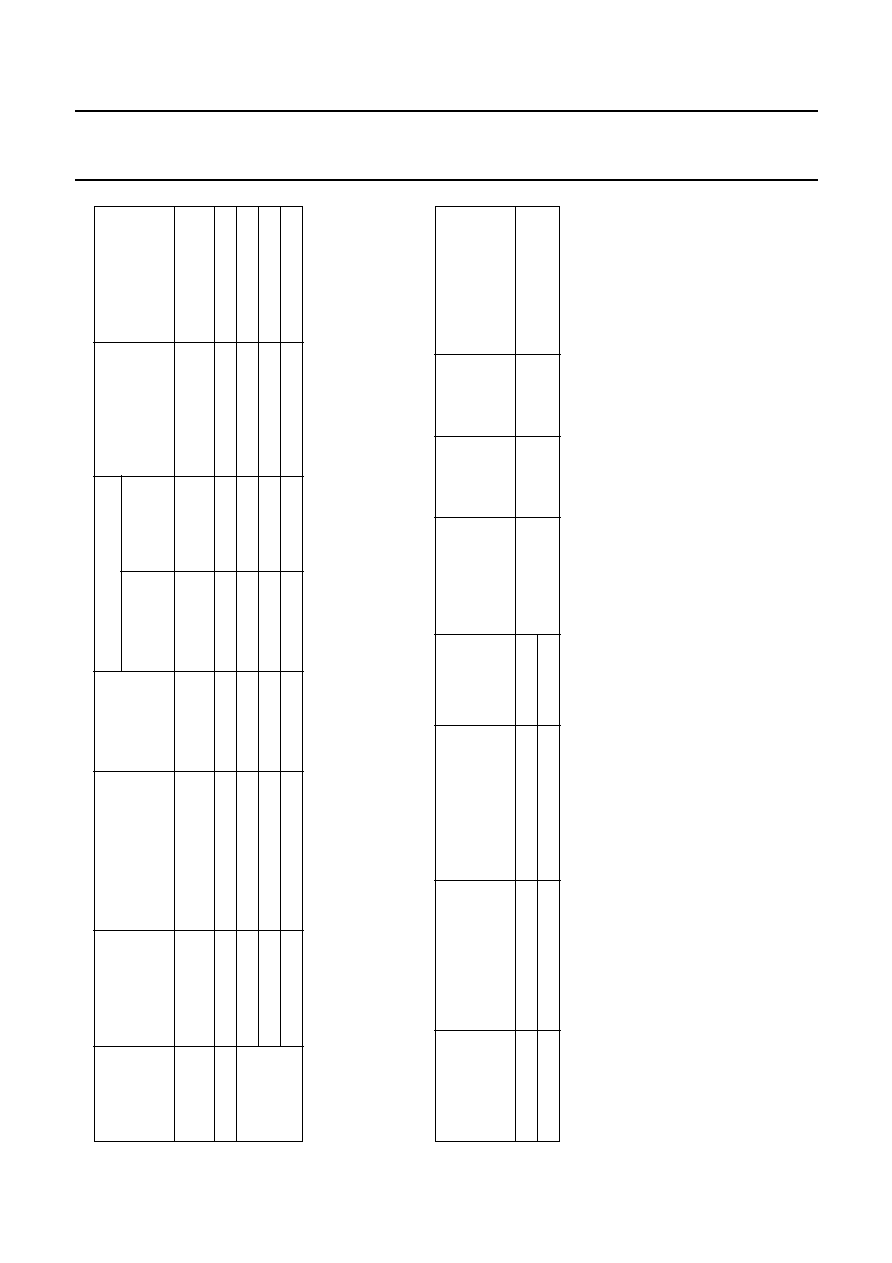
1999
Dec
20
29
Philips Semiconductors
Product specification
Digital TV Sound Processor (DTVSP)
TD
A9870A
This text is here in white to force landscape pages to be rotated correctly when browsing through the pdf in the Acrobat reader.This text is here in
_
white to force landscape pages to be rotated correctly when browsing through the pdf in the Acrobat reader.This text is here inThis text is here in
white to force landscape pages to be rotated correctly when browsing through the pdf in the Acrobat reader. white to force landscape pages to be ...
Table 6
Level setting FM at 0 dB (full-scale) = 1.4 V (RMS); note 1
Notes
1. Nominal level at digital crossbar is defined at
-
15 dB (full-scale). DAC gain setting 6 dB. Output buffer setting 0 dB. Nominal SCART output level
500 mV (RMS).
2. For stereo signals the output level is 6 dB lower. The level adjust has to be increased by 6 dB.
Table 7
Level setting SAT FM at 0 dB (full-scale) = 1.4 V (RMS)
2 CHANNEL
FM
STANDARD
TRANSMITTER
NOMINAL
MODULATION
DEPTH
NOMINAL LEVEL AT
DEMODULATOR
OUTPUT
CARRIER 1
FREQUENCY
CARRIER 2
DE-EMPHASIS OF
CARRIER 1 AND
CARRIER 2
FM LEVEL
ADJUST SETTING
OF CARRIER 1
AND CARRIER 2
FREQUENCY
IDENT
M
15 kHz deviation
-
24 dB (full-scale);
note 2
4.5 MHz
4.724 MHz
on
75
µ
s
+9 dB
B/G
27 kHz deviation
-
19 dB (full-scale)
5.5 MHz
5.742 MHz
on
50
µ
s
+4 dB
D/K
27 kHz deviation
-
19 dB (full-scale)
6.5 MHz
6.742 MHz
on
50
µ
s
+4 dB
27 kHz deviation
-
19 dB (full-scale)
6.5 MHz
6.25 MHz
on
50
µ
s
+4 dB
27 kHz deviation
-
19 dB (full-scale)
6.5 MHz
5.742 MHz
on
50
µ
s
+4 dB
SOURCE
TRANSMITTER
MAXIMUM
MODULATION
DEPTH
NOMINAL LEVEL AT
DEMODULATOR
OUTPUT
FM LEVEL
ADJUST
SETTING
MAXIMUM
LEVEL AT
CROSSBAR
DAC GAIN
SETTING
OUTPUT
BUFFER
NOMINAL SCART
OUTPUT VOLTAGE
SAT FM, stereo
50 kHz deviation
-
13 dB (full-scale)
+4 dB
-
9 dB (full-scale) +6 dB
0 dB
1 V (RMS)
SAT FM, mono
85 kHz deviation
-
9 dB (full-scale)
0 dB
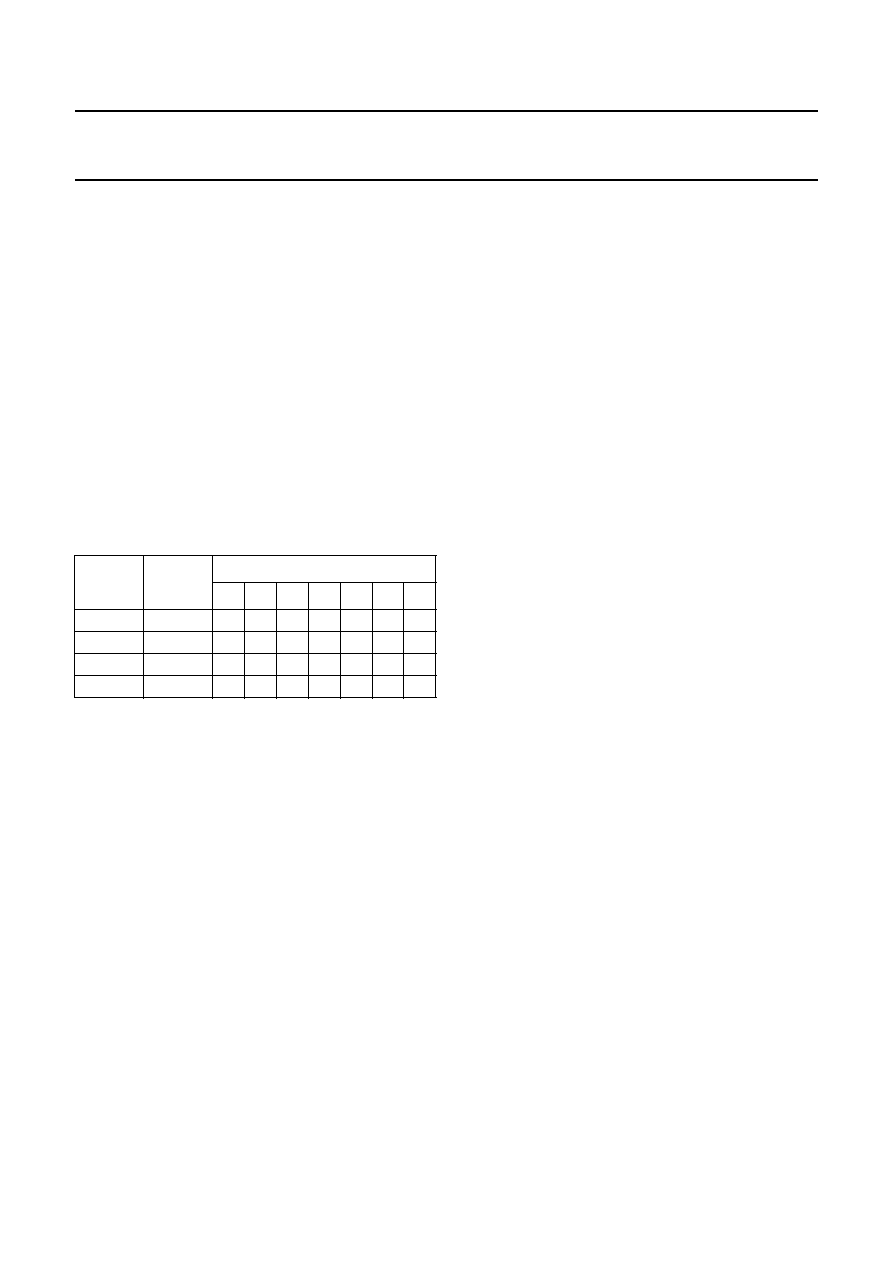
1999 Dec 20
30
Philips Semiconductors
Product specification
Digital TV Sound Processor (DTVSP)
TDA9870A
10 I
2
C-BUS CONTROL
10.1
Introduction
The TDA9870A is fully controlled via the I
2
C-bus. Control
is exercised by writing data to one or more internal
registers. Status information can be read from an array of
registers to enable the controlling microcontroller to
determine whether any action is required.
The device has an I
2
C-bus slave transceiver, in
accordance with the fast-mode specification, with a
maximum speed of 400 kbits/s. Information concerning the
I
2
C-bus can be found in brochure
"I
2
C-bus and how to use
it" (order number 9398 393 40011). To avoid conflicts in a
real application with other ICs providing similar or
complementary functions, there are four possible slave
addresses available which can be selected by
pins ADDR1 and ADDR2 (see Table 8).
Table 8
Possible slave addresses
The I
2
C-bus interface remains operational in the standby
mode of the TDA9870A to allow control of the analog
source selectors with regard to SCART-to-SCART
copying.
The device will not respond to a `general call' on the
I
2
C-bus, i.e. when a slave address of 0000000 is sent by a
master.
The data transmission between the microcontroller and
the other I
2
C-bus controlled ICs is not disturbed when the
supply voltage of the TDA9870A is not connected.
10.2
Power-up state
At power-up the device is in the following state:
∑
All outputs muted
∑
No sound carrier frequency loaded
∑
General purpose I/O pins ready for input (HIGH)
∑
Input SIF1 selected with:
≠ AGC on
≠ Small hysteresis
≠ SIF input level shift 0 dB.
∑
Demodulators for both sound carriers set to FM with:
≠ Identification for B/G, D/K, response time 1 s
≠ Level adjust set to 0 dB
≠ De-emphasis 50
µ
s
≠ Matrix set to mono.
∑
Main channel set to FM input with:
≠ Spatial off
≠ Pseudo off
≠ AVL off
≠ Volume mute
≠ Bass flat
≠ Treble flat
≠ Contour off
≠ Bass boost flat.
∑
Auxiliary channel set to FM input with:
≠ Volume mute
≠ Bass flat
≠ Treble flat.
∑
Feature interface all outputs off
∑
Beeper off
∑
Monitoring of carrier 1 FM demodulator DC output.
After power-up a device initialization has to be performed
via the I
2
C-bus to put the TDA9870A into the proper mode
of operation, in accordance with the desired TV standard,
audio control settings, etc.
ADDR2
ADDR1
SLAVE ADDRESS
A6
A5
A4
A3
A2
A1
A0
LOW
LOW
1
0
1
1
0
0
0
LOW
HIGH
1
0
1
1
0
0
1
HIGH
LOW
1
0
1
1
0
1
0
HIGH
HIGH
1
0
1
1
0
1
1
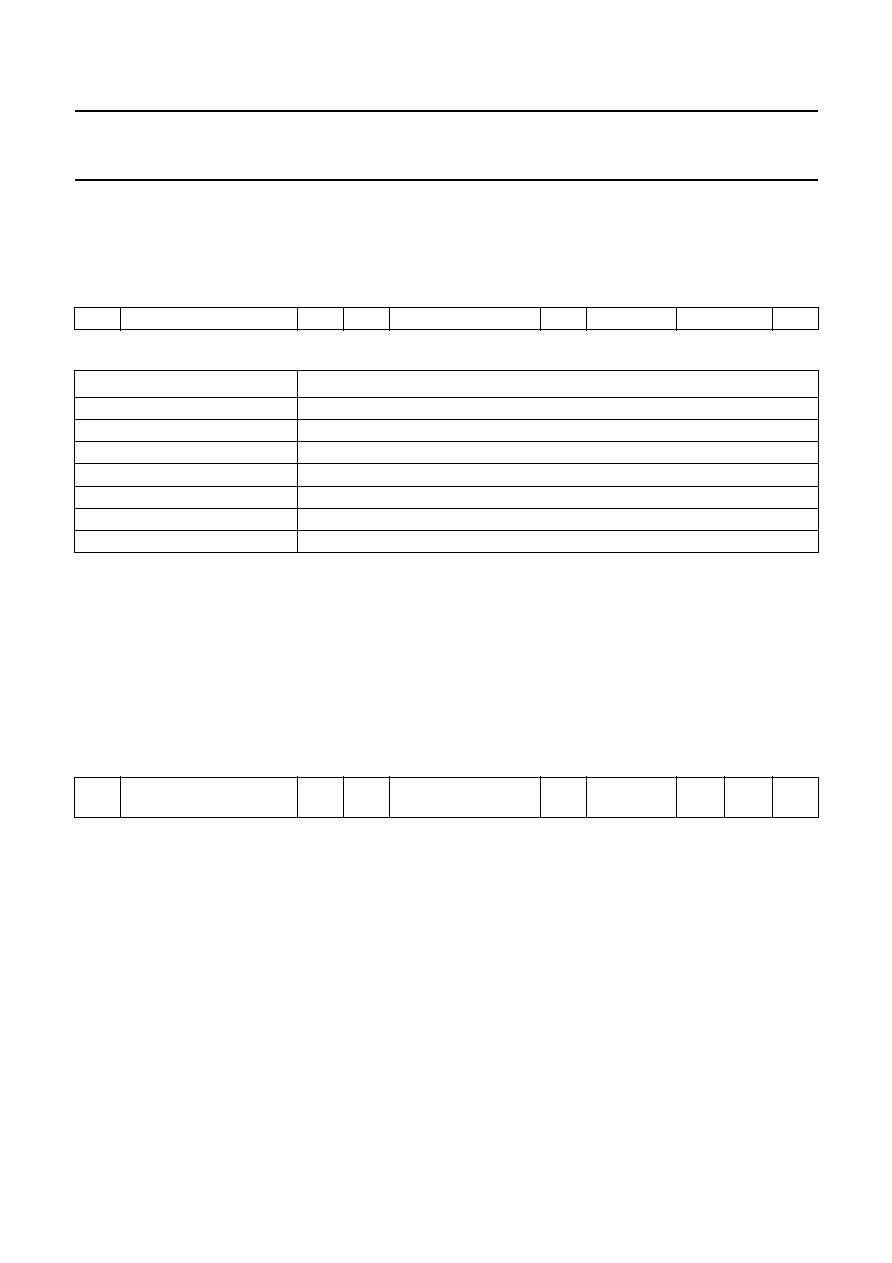
1999 Dec 20
31
Philips Semiconductors
Product specification
Digital TV Sound Processor (DTVSP)
TDA9870A
10.3
Slave receiver mode
As a slave receiver, the TDA9870A provides 46 registers for storing commands and data. These registers are accessed
via so-called subaddresses. A subaddress can be thought of as a pointer to an internal memory location.
Table 9
I
2
C-bus; slave address, subaddress and data format
Table 10 Explanation of Table 9
It is allowed to send more than one data byte per transmission to the TDA9870A. In this event, the subaddress is
automatically incremented after each data byte, resulting in storing the sequence of data bytes at successive register
locations, starting at SUBADDRESS. A transmission can start at any valid subaddress. Each byte is acknowledged with
ACK (acknowledge).
There is no `wrap-around' of subaddresses.
Commands and data are processed as soon as they have been completely received. Functions requiring more than one
byte will, thus, be executed only after all bytes for that function have been received. If the transmission is terminated
(STOP condition) before all bytes have been received, the incomplete data for that function are ignored.
Table 11 Format for a transmission employing auto-increment of subaddresses
Note
1. n data bytes with auto-increment of subaddresses.
Data patterns sent to the various subaddresses are not checked for being illegal or not at that address, except for the
functions of volume, bass and treble control, bass boost and level adjust.
Detection of a STOP condition without a preceding acknowledge bit is regarded as a bus error. The last operation will
then not be executed.
S
SLAVE ADDRESS
0
ACK
SUBADDRESS
ACK
DATA
ACK
P
BIT
FUNCTION
S
START condition
SLAVE ADDRESS
7-bit device address
0
data direction bit (write to device)
ACK
acknowledge by slave
SUBADDRESS
address of register to write to
DATA
data byte to be written into register
P
STOP condition
S
SLAVE ADDRESS
0
ACK
SUBADDRESS
ACK
DATA
BYTE A
(1)
DATA
ACK
P

1999 Dec 20
32
Philips Semiconductors
Product specification
Digital TV Sound Processor (DTVSP)
TDA9870A
Table 12 Overview of the slave receiver registers
SUBADDRESS
(DECIMAL)
DATA
FUNCTION
MSB
LSB
0
0
0
s
g
g
g
g
g
AGC level shift, AGC gain selection
1
c
c
c
c
c
c
c
c
general configuration
2
p
0
0
m
m
s
s
s
monitor select, peak detector on/off
3
f
f
f
f
f
f
f
f
carrier 1 frequency; most significant part
4
f
f
f
f
f
f
f
f
carrier 1 frequency
5
f
f
f
f
f
f
f
f
carrier 1 frequency; least significant part
6
f
f
f
f
f
f
f
f
carrier 2 frequency; most significant part
7
f
f
f
f
f
f
f
f
carrier 2 frequency
8
f
f
f
f
f
f
f
f
carrier 2 frequency; least significant part
9
c
c
c
c
c
c
c
c
demodulator configuration
10
d
d
d
d
d
d
d
d
FM de-emphasis
11
0
0
0
0
0
m
m
m
FM matrix
12
0
0
0
l
l
l
l
l
channel 1 output level adjust
13
0
0
0
l
l
l
l
l
channel 2 output level adjust
14
0
0
0
0
0
0
0
0
set to logic 0; note 1
15
0
0
0
0
0
0
0
0
set to logic 0; note 1
16
0
0
0
0
0
0
0
0
set to logic 0; note 1
17
0
0
0
0
0
0
0
0
set to logic 0; note 1
18
m
m
m
m
m
m
m
m
audio mute control
19
g
m
m
m
g
s
s
s
DAC output select
20
0
g
m
m
0
s
s
s
SCART 1 output select
21
0
g
m
m
0
s
s
s
SCART 2 output select
22
0
g
m
m
0
0
0
s
line output select
23
s
s
s
l
l
l
l
l
ADC output select
24
0
m
m
m
0
s
s
s
Main channel select
25
0
0
s
s
p
p
a
a
audio effects (AVL, pseudo and spatial)
26
v
v
v
v
v
v
v
v
volume control, Main left
27
v
v
v
v
v
v
v
v
volume control, Main right
28
0
0
0
c
c
c
c
c
contour control, Main
29
0
0
0
b
b
b
b
b
bass control, Main
30
0
0
0
t
t
t
t
t
treble control, Main
31
0
m
m
m
0
s
s
s
Auxiliary channel select
32
v
v
v
v
v
v
v
v
volume control, Auxiliary left
33
v
v
v
v
v
v
v
v
volume control, Auxiliary right
34
0
0
0
b
b
b
b
b
bass control, Auxiliary
35
0
0
0
t
t
t
t
t
treble control, Auxiliary
36
0
0
0
c
c
c
c
c
feature interface configuration
37
0
m
m
m
0
s
s
s
I
2
S1 output select
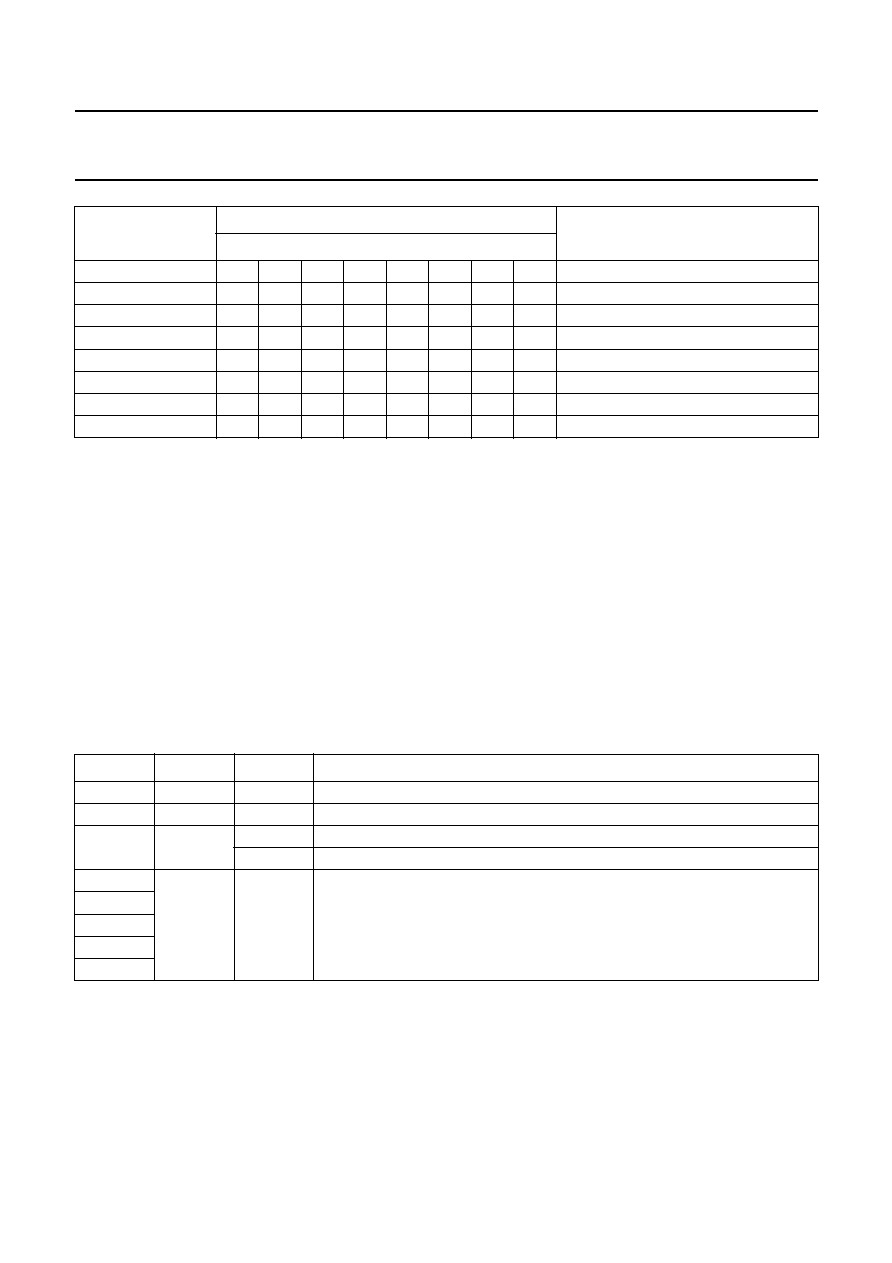
1999 Dec 20
33
Philips Semiconductors
Product specification
Digital TV Sound Processor (DTVSP)
TDA9870A
Note
1. These bits have not been assigned to a function.
The following sub-sections provide a detailed description of the slave receiver registers.
10.3.1
AGC
GAIN REGISTER
If the automatic gain control function is switched off in the general configuration register, the contents of this register will
define a fixed gain of the AGC stage. The input voltages given are meant to generate a full-scale output from the SIF
ADC. If automatic gain control is on, the AGCGAIN setting is ignored. After switching off the automatic gain control
function, the latest gain control setting is copied to the AGC gain register.
If the AGC input level shift bit AGCLEV is set to logic 1 the input signal is scaled with
-
10 dB. The AGCLEV bit is also
active if the automatic gain function is enabled.
It should be noted that the input voltages should be considered as approximate target values.
Table 13 Subaddress 0 (note 1)
Note
1. The default setting at power-up is 00000000.
38
0
0
0
i
i
i
i
i
I
2
S1 input level adjust
39
0
0
0
o
o
o
o
o
I
2
S1 output level adjust
40
0
m
m
m
0
s
s
s
I
2
S2 output select
41
0
0
0
i
i
i
i
i
I
2
S2 input level adjust
42
0
0
0
o
o
o
o
o
I
2
S2 output level adjust
43
0
0
0
0
0
f
f
f
beeper frequency
44
0
0
v
v
v
v
v
v
beeper volume, Main and Auxiliary
45
b
b
b
b
b
b
b
b
bass boost, Main left and right
BIT
NAME
VALUE
DESCRIPTION
7 (MSB)
B7
0
set to logic 0
6
B6
0
set to logic 0
5
AGCLEV
1
input signal scaled with
-
10 dB
0
input signal not scaled
4
AGCGAIN
-
gain control bits (see Table 14).
3
2
1
0 (LSB)
SUBADDRESS
(DECIMAL)
DATA
FUNCTION
MSB
LSB

1999 Dec 20
34
Philips Semiconductors
Product specification
Digital TV Sound Processor (DTVSP)
TDA9870A
Table 14 Gain control bits
Note
1. The default setting at power-up is 00000000.
MSB
LSB
AGC GAIN
(dB)
SIF INPUT VOLTAGE
[mV (p-p)]
B7
B6
B5
B4
B3
B2
B1
B0
0
0
0/1
1
1
1
1
1
0.0
941/2976
0
0
0/1
1
1
1
1
0
0.8
861/2723
0
0
0/1
1
1
1
0
1
1.5
788/2490
0
0
0/1
1
1
1
0
0
2.3
720/2278
0
0
0/1
1
1
0
1
1
3.1
659/2084
0
0
0/1
1
1
0
1
0
3.9
603/1906
0
0
0/1
1
1
0
0
1
4.6
551/1744
0
0
0/1
1
1
0
0
0
5.4
504/1595
0
0
0/1
1
0
1
1
1
6.2
461/1459
0
0
0/1
1
0
1
1
0
7.0
422/1334
0
0
0/1
1
0
1
0
1
7.7
386/1221
0
0
0/1
1
0
1
0
0
8.5
353/1117
0
0
0/1
1
0
0
1
1
9.3
323/1021
0
0
0/1
1
0
0
1
0
10.1
295/934
0
0
0/1
1
0
0
0
1
10.8
270/855
0
0
0/1
1
0
0
0
0
11.6
247/782
0
0
0/1
0
1
1
1
1
12.4
226/715
0
0
0/1
0
1
1
1
0
13.2
207/654
0
0
0/1
0
1
1
0
1
13.9
189/598
0
0
0/1
0
1
1
0
0
14.7
173/547
0
0
0/1
0
1
0
1
1
15.5
158/501
0
0
0/1
0
1
0
1
0
16.3
145/458
0
0
0/1
0
1
0
0
1
17.0
132/419
0
0
0/1
0
1
0
0
0
17.8
121/383
0
0
0/1
0
0
1
1
1
18.6
111/350
0
0
0/1
0
0
1
1
0
19.4
101/321
0
0
0/1
0
0
1
0
1
20.1
93/293
0
0
0/1
0
0
1
0
0
20.9
85/268
0
0
0/1
0
0
0
1
1
21.7
78/245
0
0
0/1
0
0
0
1
0
22.5
71/224
0
0
0/1
0
0
0
0
1
23.2
65/205
0
0
0/1
0
0
0
0
0
24.0
59/188 (note 1)

1999 Dec 20
35
Philips Semiconductors
Product specification
Digital TV Sound Processor (DTVSP)
TDA9870A
10.3.2
G
ENERAL CONFIGURATION REGISTER
Table 15 Subaddress 1 (note 1)
Note
1. The default setting at power-up is 11000000.
BIT
NAME
VALUE
DESCRIPTION
7 (MSB)
P2OUT
-
This bit controls the general purpose input/output pin P2. The contents of this bit
is written directly to the corresponding pin. If input is desired, the bit must be set to
logic 1 to allow the pin to be pulled LOW externally. Input from the pin is reflected
in the device status register (see Section 10.4.1, subaddress 0).
6
P1OUT
-
This bit controls the general purpose input/output pin P1. The contents of this bit
is written directly to the corresponding pin. If input is desired, the bit must be set to
logic 1 to allow the pin to be pulled LOW externally. Input from the pin is reflected
in the device status register (see Section 10.4.1, subaddress 0). P1OUT is
recommended to be used for switching an SIF trap for the adjacent picture carrier
in designs that employ such a trap.
5
STDBY
1
The TDA9870A is in the standby mode. Most functions are disabled and power
dissipation is somewhat reduced, but the analog selectors/matrices remain
operational to support analog copying from SCART-to-SCART.
0
The TDA9870A is in normal operating mode. On return from standby mode, the
device is in its Power-on reset mode and needs to be re-initialized.
4
INIT
1
Causes initialization of the TDA9870A to its default settings. This has the same
effect as a Power-on reset. If there is a conflict between the default settings and
any bit set to logic 1 in this register, the bits of this register have priority over the
corresponding default setting.
0
Automatically reset to logic 0 after initialization. When set to logic 0, the
TDA9870A is in normal operating mode.
3
CLRPOR
1
Resets the power fail detector to LOW.
0
This bit is automatically reset to logic 0 after bit POR in the device status register
has been reset.
2
AGCSLOW
1
A longer decay time is selected for input signals with strong video modulation
(intercarrier). This bit only has an effect when bit AGCOFF = 0.
0
Selects normal attack and decay times for the AGC.
1
AGCOFF
1
Forces the AGC block to a fixed gain as defined in the AGC gain register.
0
The automatic gain control function is enabled and the contents of the AGC gain
register is ignored.
0 (LSB)
SIFSEL
1
Selects pin SIF2 for input (recommended for satellite tuner).
0
Selects pin SIF1 for input (terrestrial TV).

1999 Dec 20
36
Philips Semiconductors
Product specification
Digital TV Sound Processor (DTVSP)
TDA9870A
10.3.3
M
ONITOR SELECT REGISTER
This register is used to define the signal source, the level of which is to be monitored, and if the peak level is to be
monitored. Peak level refers to the magnitude of the maximum excursion of a signal.
Audio magnitude/phase is related to the FM demodulator output. Phase information is provided, when it operates in
FM mode, while magnitude is supplied in AM mode.
Data can be read-out in the I
2
C-bus slave transmitter mode. By reading out level read-out registers
(subaddresses 5 and 6, see Section 10.4), the current peak level will be reset.
Table 16 Subaddress 2 (note 1)
Note
1. The default setting at power-up is 00000000.
Table 17 Monitor output
Table 18 Signal source (note 1)
Note
1. The term `crossbar' refers to the digital selector, where level-adjusted signals from various sources are available.
BIT
NAME
VALUE
DESCRIPTION
7 (MSB)
PEAKMON
1
selects the peak level of a source to be monitored
0
the last sample will be supplied
6
B6
0
default value
5
B5
0
default value
4
B4
-
monitor output (see Table 17)
3
B3
2
B2
-
signal source (see Table 18)
1
B1
0 (LSB)
B0
B4
B3
MONITOR OUTPUT
0
0
0
1
L input (channel 1, respectively)
1
0
R input (channel 2, respectively)
B2
B1
B0
SIGNAL SOURCE
0
0
0
DC output of FM demodulator
0
0
1
audio magnitude/phase, FM demodulator output
0
1
0
crossbar input from FM/AM channel
0
1
1
don't care
1
0
0
crossbar input from I
2
S1 channel
1
0
1
crossbar input from I
2
S2 channel
1
1
0
crossbar input from audio ADC channel
1
1
1
input to Main channel DAC (without beeper)
L input
R input
+
2
-------------------------------------------
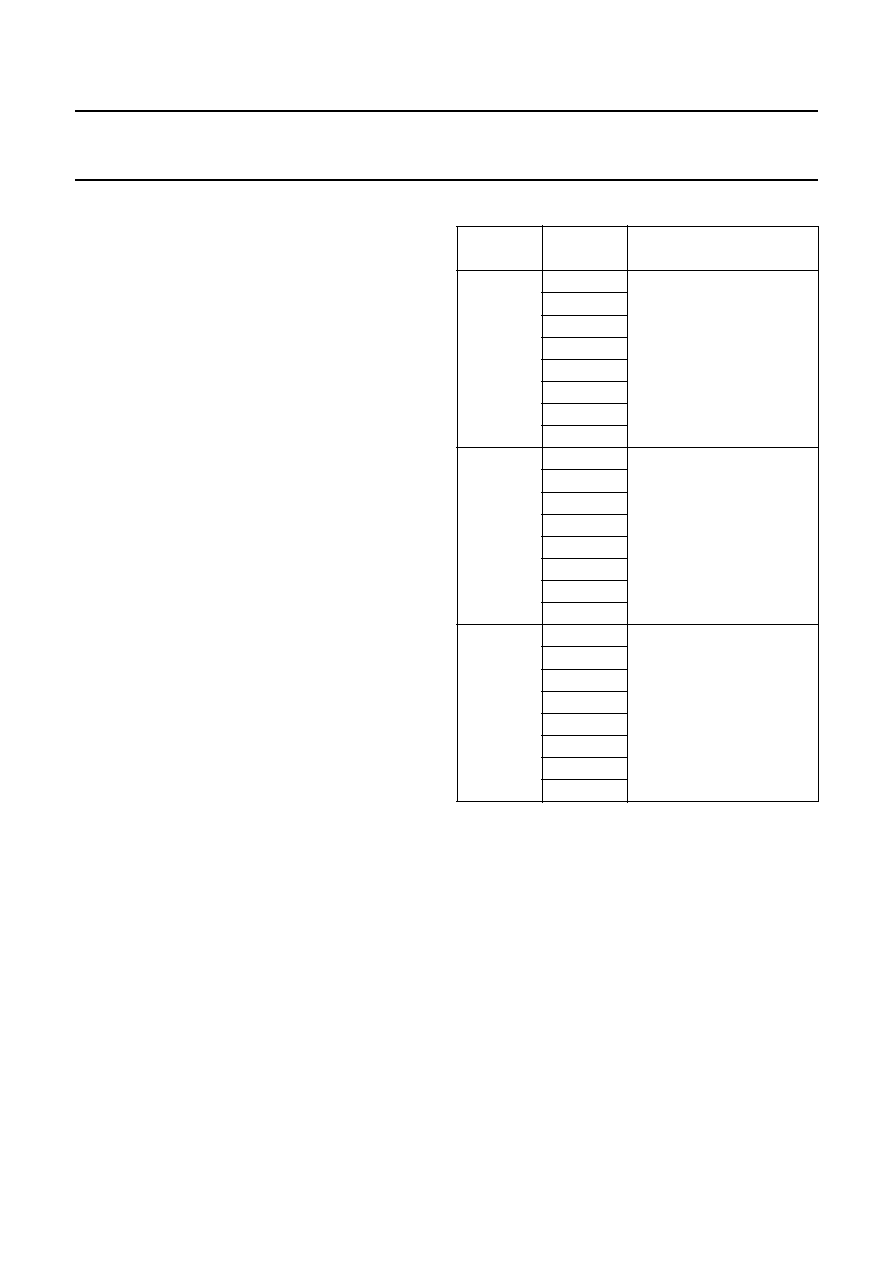
1999 Dec 20
37
Philips Semiconductors
Product specification
Digital TV Sound Processor (DTVSP)
TDA9870A
10.3.4
C
ARRIER
1
FREQUENCY REGISTER
The three bytes together constitute a 24-bit frequency
control word to represent the sound carrier (i.e. mixer)
frequency in accordance with the following formula:
Where:
data = 24-bit frequency control word
f
mix
= desired sound carrier frequency
f
clk
= 12.288 MHz (clock frequency of mixer)
2
24
= 16777216 (number of steps in a 24-bit word size).
Example: A 5.5 MHz sound carrier frequency will be
generated by sending the following sequence of data
bytes to the TDA9870A (data = 7509333 in decimal
notation or 729555 in hexadecimal):
01110010 10010101 01010101.
As three bytes are required to define a carrier frequency,
execution of this command starts only after all bytes have
been received. If an error occurs, e.g. a premature STOP
condition, partial data for this function is ignored.
The default setting at power-up is 00000000 for all three
bytes.
Most significant part at subaddress 3 and least significant
part at subaddress 5 (see Table 19).
Table 19 Subaddresses 3 to 5
data
f
mix
f
clk
---------
2
24
◊
=
SUB-
ADDRESS
BIT
DESCRIPTION
3
7 (MSB)
carrier 1 frequency;
most significant part
6
5
4
3
2
1
0
4
7
carrier 1 frequency
6
5
4
3
2
1
0
5
7
carrier 1 frequency;
least significant part
6
5
4
3
2
1
0 (LSB)

1999 Dec 20
38
Philips Semiconductors
Product specification
Digital TV Sound Processor (DTVSP)
TDA9870A
10.3.5
C
ARRIER
2
FREQUENCY REGISTER
Same as for sound carrier 1, except for subaddresses (subaddresses 6 to 8). If the carrier 2 frequency register is used,
it will be for the second FM sound carrier of a terrestrial or satellite FM program.
10.3.6
D
EMODULATOR CONFIGURATION REGISTER
It is recommended to switch the FM sound mode identification off whenever the received program is not a terrestrial
2-carrier sound. Switching the identification off will reset the associated hardware to a defined state.
Table 20 Subaddress 9 (note 1)
Note
1. The default setting at power-up is 00000000.
Table 21 Identification mode
Table 22 Filter bandwidth channel 1 and channel 2
BIT
NAME
VALUE
DESCRIPTION
7 (MSB)
IDMOD1
-
these bits define the response time after which a FM sound mode identification
result may be expected; the longer the time, the more reliable the identification
(see Table 21)
6
IDMOD0
5
IDAREA
1
selects FM identification frequencies in accordance with the specification for
Korea
0
selects frequencies for Europe (B/G and D/K standard)
4
FILTBW1
-
selects filter bandwidth (see Table 22)
3
CH2MOD1
-
channel 2 receive mode: these bits control the hardware for the second sound
carrier (see Table 23)
2
CH2MOD0
1
FILTBW0
-
selects filter bandwidth (see Table 22)
0 (LSB)
CH1MODE
1
selects the hardware for the first sound carrier to operate in AM mode
0
FM mode is assumed; this applies to both terrestrial and satellite FM reception
B7
B6
IDENT MODE
0
0
slow
0
1
medium
1
0
fast
1
1
off/reset
B4
B1
FILTER
BANDWIDTH
FILTER MODES
CH1
CH2
0
0
narrow
narrow
recommended for nominal terrestrial broadcast conditions and
SAT with 2 carriers
0
1
extra wide
narrow
recommended only for high-deviation SAT mono carriers
(e.g. obsolete Main channel on Astra)
1
0
medium
medium
recommended for moderately overmodulated broadcast conditions
1
1
wide
wide
recommended for strongly overmodulated broadcast conditions
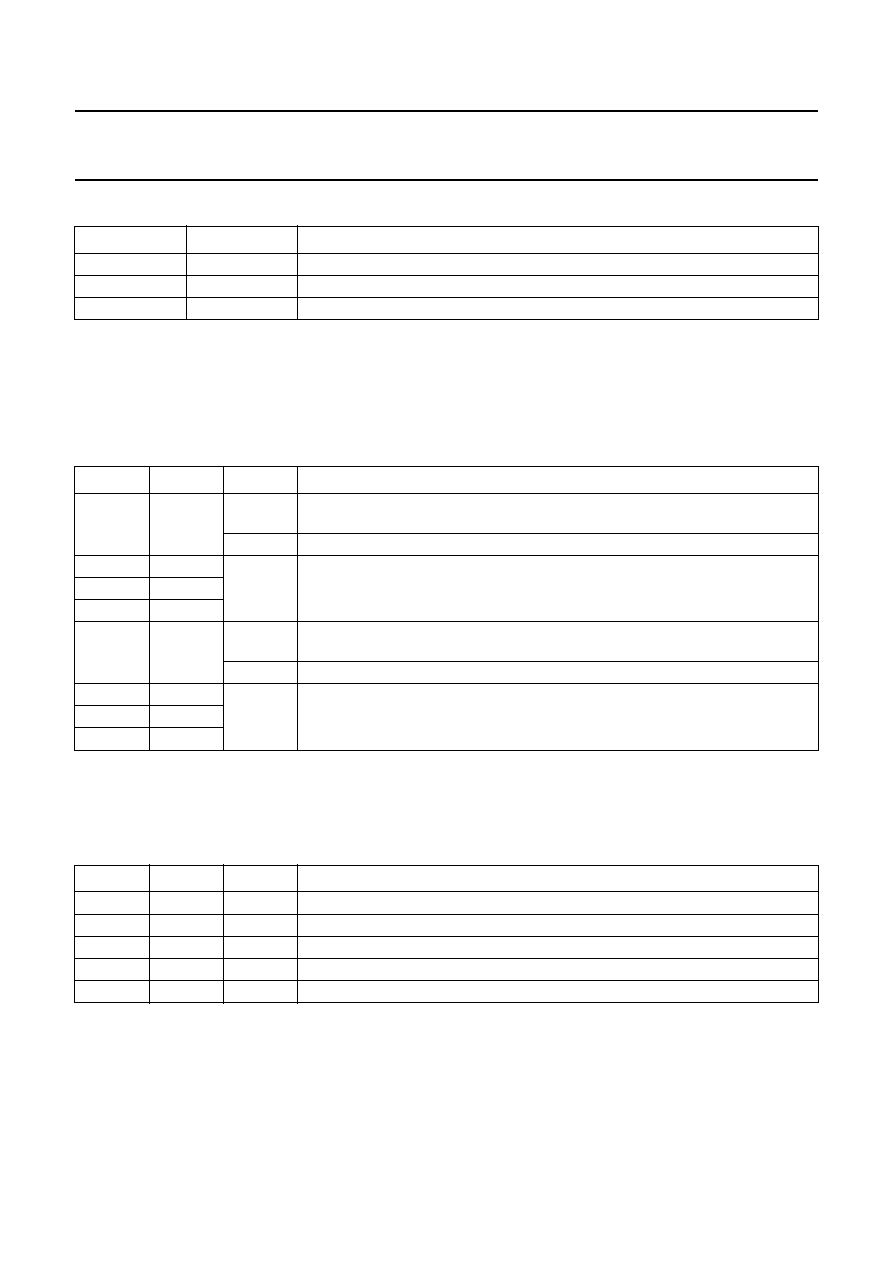
1999 Dec 20
39
Philips Semiconductors
Product specification
Digital TV Sound Processor (DTVSP)
TDA9870A
Table 23 Channel 2 receive mode
10.3.7
FM
DE
-
EMPHASIS REGISTER
This register is used to select the proper de-emphasis characteristics as appropriate for the standard of the received
carrier. Bits B3 to B0 apply to sound carrier 1, bits B7 to B4 apply to sound carrier 2.
In the event of A2 reception, both groups must be set to the same characteristics.
Table 24 Subaddress 10 (note 1)
Notes
1. The default setting at power-up is 00000000.
2. The FM de-emphasis gain is 0 dB at 40 Hz.
Table 25 De-emphasis sound carrier 2
B3
B2
CHANNEL 2
0
0
FM
0
1
AM
1
0
don't care
BIT
NAME
VALUE
DESCRIPTION
7 (MSB)
ADEEM2
1
Activates the adaptive de-emphasis function, which is required for certain satellite
FM channels. The standard FM de-emphasis must then be set to 75
µ
s (note 2).
0
The adaptive de-emphasis is off.
6
B6
-
Time constant selection for FM de-emphasis (see Table 25).
5
B5
4
B4
3
ADEEM1
1
Activates the adaptive de-emphasis function, which is required for certain satellite
FM channels. The standard FM de-emphasis must then be set to 75
µ
s (note 2).
0
The adaptive de-emphasis is off.
2
B2
-
Time constant selection for FM de-emphasis (see Table 26).
1
B1
0 (LSB)
B0
B6
B5
B4
DE-EMPHASIS
0
0
0
50
µ
s (Europe)
0
0
1
60
µ
s
0
1
0
75
µ
s (M standard)
0
1
1
J17
1
0
0
off

1999 Dec 20
40
Philips Semiconductors
Product specification
Digital TV Sound Processor (DTVSP)
TDA9870A
Table 26 De-emphasis sound carrier 1
10.3.8
FM
MATRIX REGISTER
This register is used to select the proper dematrixing characteristics as appropriate for the standard of the received
carrier and the related sound mode identification.
Table 27 Subaddress 11 (note 1)
Note
1. The default setting at power-up is 00000000.
Table 28 Dematrixing characteristics
Notes
1. CH1 input: audio signal from FM channel 1.
2. CH2 input: audio signal from FM channel 2.
3. For stereo Korea the dematrix applies 6 dB attenuation (see Table 6).
B2
B1
B0
DE-EMPHASIS
0
0
0
50
µ
s (Europe)
0
0
1
60
µ
s
0
1
0
75
µ
s (M standard)
0
1
1
J17
1
0
0
off
BIT
NAME
VALUE
DESCRIPTION
7 (MSB)
B7
0
default value
6
B6
0
default value
5
B5
0
default value
4
B4
0
default value
3
B3
0
default value
2
B2
-
dematrixing characteristics (see Table 28)
1
B1
0 (LSB)
B0
B2
B1
B0
L OUTPUT
R OUTPUT
MODE
0
0
0
CH1 input; note 1
CH1 input; note 1
mono 1
0
0
1
CH2 input; note 2
CH2 input; note 2
mono 2
0
1
0
CH1 input; note 1
CH2 input; note 2
dual
0
1
1
CH2 input; note 2
CH1 input; note 1
dual swapped
1
0
0
2CH1 input
-
CH2 input
CH2 input; note 2
stereo Europe
1
0
1
stereo Korea; note 3
CH1 input
CH2 input
+
2
-----------------------------------------------------------
CH1 input
CH2 input
≠
2
-----------------------------------------------------------

1999 Dec 20
41
Philips Semiconductors
Product specification
Digital TV Sound Processor (DTVSP)
TDA9870A
10.3.9
FM
CHANNEL
1
LEVEL ADJUST REGISTER
This register is used to correct for standard and station-dependent differences of signal levels.
Table 29 applies to sound carrier 1.
Table 29 Subaddress 12
Note
1. The default setting at power-up is 00000000.
MSB
LSB
GAIN SETTING (dB)
B7
B6
B5
B4
B3
B2
B1
B0
0
0
0
0
1
1
1
1
+15
0
0
0
0
1
1
1
0
+14
0
0
0
0
1
1
0
1
+13
0
0
0
0
1
1
0
0
+12
0
0
0
0
1
0
1
1
+11
0
0
0
0
1
0
1
0
+10
0
0
0
0
1
0
0
1
+9
0
0
0
0
1
0
0
0
+8
0
0
0
0
0
1
1
1
+7
0
0
0
0
0
1
1
0
+6
0
0
0
0
0
1
0
1
+5
0
0
0
0
0
1
0
0
+4
0
0
0
0
0
0
1
1
+3
0
0
0
0
0
0
1
0
+2
0
0
0
0
0
0
0
1
+1
0
0
0
0
0
0
0
0
0 (note 1)
0
0
0
1
1
1
1
1
-
1
0
0
0
1
1
1
1
0
-
2
0
0
0
1
1
1
0
1
-
3
0
0
0
1
1
1
0
0
-
4
0
0
0
1
1
0
1
1
-
5
0
0
0
1
1
0
1
0
-
6
0
0
0
1
1
0
0
1
-
7
0
0
0
1
1
0
0
0
-
8
0
0
0
1
0
1
1
1
-
9
0
0
0
1
0
1
1
0
-
10
0
0
0
1
0
1
0
1
-
11
0
0
0
1
0
1
0
0
-
12
0
0
0
1
0
0
1
1
-
13
0
0
0
1
0
0
1
0
-
14
0
0
0
1
0
0
0
1
-
15
0
0
0
1
0
0
0
0
mute

1999 Dec 20
42
Philips Semiconductors
Product specification
Digital TV Sound Processor (DTVSP)
TDA9870A
10.3.10 FM
CHANNEL
2
LEVEL ADJUST REGISTER
This register is used to correct for standard and station-dependent differences of signal levels. Table 30 applies to sound
carrier 2 in its FM and AM modes. In the event of A2, channels 1 and 2 should be adjusted to the same level.
Table 30 Subaddress 13
Note
1. The default setting at power-up is 00000000.
MSB
LSB
GAIN SETTING (dB)
B7
B6
B5
B4
B3
B2
B1
B0
0
0
0
0
1
1
1
1
+15
0
0
0
0
1
1
1
0
+14
0
0
0
0
1
1
0
1
+13
0
0
0
0
1
1
0
0
+12
0
0
0
0
1
0
1
1
+11
0
0
0
0
1
0
1
0
+10
0
0
0
0
1
0
0
1
+9
0
0
0
0
1
0
0
0
+8
0
0
0
0
0
1
1
1
+7
0
0
0
0
0
1
1
0
+6
0
0
0
0
0
1
0
1
+5
0
0
0
0
0
1
0
0
+4
0
0
0
0
0
0
1
1
+3
0
0
0
0
0
0
1
0
+2
0
0
0
0
0
0
0
1
+1
0
0
0
0
0
0
0
0
0 (note 1)
0
0
0
1
1
1
1
1
-
1
0
0
0
1
1
1
1
0
-
2
0
0
0
1
1
1
0
1
-
3
0
0
0
1
1
1
0
0
-
4
0
0
0
1
1
0
1
1
-
5
0
0
0
1
1
0
1
0
-
6
0
0
0
1
1
0
0
1
-
7
0
0
0
1
1
0
0
0
-
8
0
0
0
1
0
1
1
1
-
9
0
0
0
1
0
1
1
0
-
10
0
0
0
1
0
1
0
1
-
11
0
0
0
1
0
1
0
0
-
12
0
0
0
1
0
0
1
1
-
13
0
0
0
1
0
0
1
0
-
14
0
0
0
1
0
0
0
1
-
15
0
0
0
1
0
0
0
0
mute

1999 Dec 20
43
Philips Semiconductors
Product specification
Digital TV Sound Processor (DTVSP)
TDA9870A
10.3.11 R
EGISTER
14
Set to logic 0. These bits have not been assigned to a function.
10.3.12 R
EGISTER
15
Set to logic 0. These bits have not been assigned to a function.
10.3.13 R
EGISTER
16
Set to logic 0. These bits have not been assigned to a function.
10.3.14 R
EGISTER
17
Set to logic 0. These bits have not been assigned to a function.
10.3.15 A
UDIO MUTE CONTROL REGISTER
When any of these bits are set to logic 1, the corresponding pair of output channels will be muted. A bit set to logic 0
allows normal signal output.
There is a soft-mute facility for the Main and Auxiliary output channels to provide click-free muting independent of the
volume control. This is switched on/off by bits MUTMAIN and MUTAUX.
Table 31 Subaddress 18 (note 1)
Note
1. The default setting at power-up is 11111111.
BIT
NAME
VALUE
DESCRIPTION
7 (MSB)
MUTI
2
S2
1
mute I
2
S2 outputs
0
normal I
2
S2 outputs
6
MUTI
2
S1
1
mute I
2
S1 outputs
0
normal I
2
S1 outputs
5
MUTDAC
1
mute internal DAC
0
normal internal DAC
4
MUTLINE
1
mute line outputs
0
normal line outputs
3
MUTSC2
1
mute SCART 2 outputs
0
normal SCART 2 outputs
2
MUTSC1
1
mute SCART 1 outputs
0
normal SCART 1 outputs
1
MUTAUX
1
mute Auxiliary outputs
0
normal Auxiliary outputs
0 (LSB)
MUTMAIN
1
mute Main outputs
0
normal Main outputs
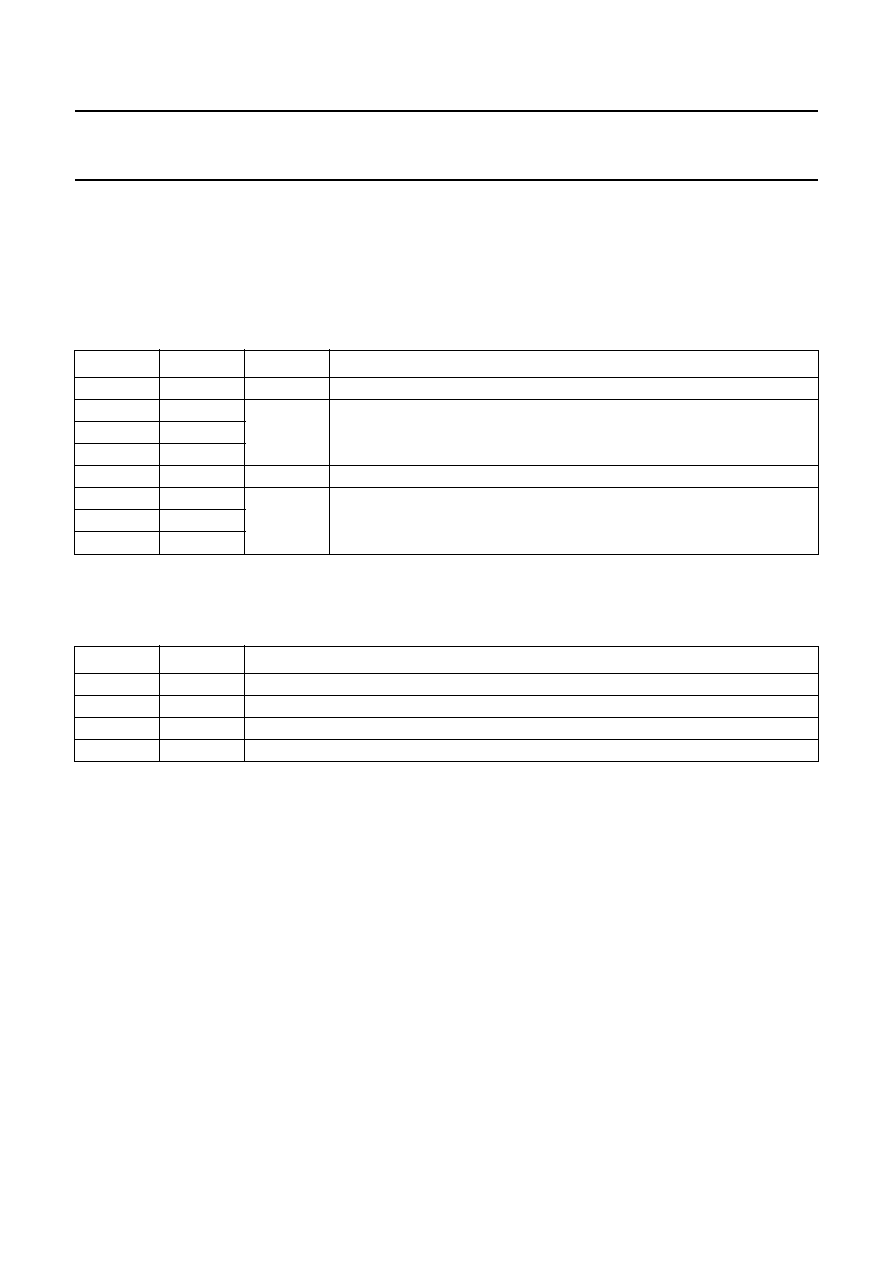
1999 Dec 20
44
Philips Semiconductors
Product specification
Digital TV Sound Processor (DTVSP)
TDA9870A
10.3.16 DAC
OUTPUT SELECT REGISTER
This register is used to define both the signal source to be entered into the DAC and the mode of the digital matrix for
signal selection. The DAC is used for signal output from digital sources at analog outputs.
The bits DACGAIN1 and DACGAIN2 can introduce some extra gain at the input to the DAC. DACGAIN1 adds 3 dB and
DACGAIN2 adds 6 dB of gain, respectively.
Table 32 Subaddress 19 (note 1)
Note
1. The default setting at power-up is 00000000.
Table 33 Extra gain setting
BIT
NAME
VALUE
DESCRIPTION
7 (MSB)
DACGAIN2
-
extra gain setting (see Table 33)
6
B6
-
DAC output selection (see Table 34)
5
B5
4
B4
3
DACGAIN1
-
extra gain setting (see Table 33)
2
B2
-
signal source selection (see Table 35)
1
B1
0 (LSB)
B0
B7
B3
GAIN (dB)
0
0
0
0
1
3
1
0
6
1
1
9

1999 Dec 20
45
Philips Semiconductors
Product specification
Digital TV Sound Processor (DTVSP)
TDA9870A
Table 34 DAC output selection
Table 35 Signal source selection
B6
B5
B4
L OUTPUT
R OUTPUT
0
0
0
L input
R input
0
0
1
L input
L input
0
1
0
R input
R input
0
1
1
R input
L input
1
0
0
B2
B1
B0
SIGNAL SOURCE
LEFT
RIGHT
0
0
0
FM left
FM right
0
0
1
don't care
0
1
0
I
2
S1 left
I
2
S1 right
0
1
1
I
2
S2 left
I
2
S2 right
1
0
0
ADC left
ADC right
1
0
1
AVL left
AVL right
1
1
0
don't care
1
1
1
don't care
L
R
+
2
--------------
L
R
+
2
--------------
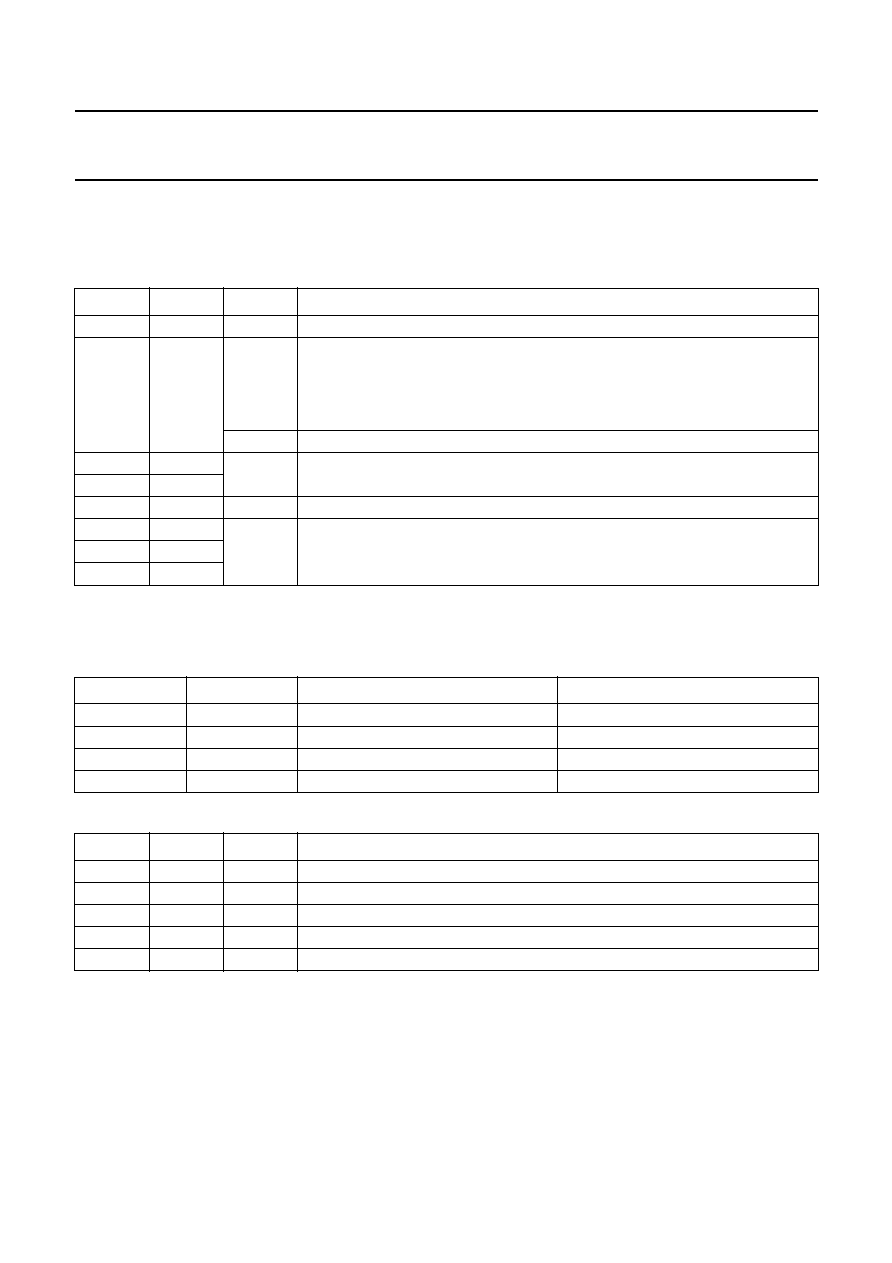
1999 Dec 20
46
Philips Semiconductors
Product specification
Digital TV Sound Processor (DTVSP)
TDA9870A
10.3.17 SCART 1
OUTPUT SELECT REGISTER
This register is used to define both the signal source to be output at SCART 1 and the output channel selector mode.
Table 36 Subaddress 20 (note 1)
Note
1. The default setting at power-up is 00000001.
Table 37 Output channel selection
Table 38 Signal source selection
BIT
NAME
VALUE
DESCRIPTION
7 (MSB)
B7
0
default value
6
SC1GAIN
1
Activates the 3 dB gain stage at the SCART 1 output buffers. As any SCART input
passes a 3 dB attenuator, this gain stage can be used to compensate that
attenuation, resulting in a 0 dB insertion loss when copying from SCART 2 input to
SCART 1 output. However, that gain must be used with great care, as it will cause
signal clipping at high input levels.
0
the audio signal output will be unchanged (0 dB gain)
5
B5
-
output channel selection (see Table 37)
4
B4
3
B3
0
default value
2
B2
-
signal source selection (see Table 38)
1
B1
0 (LSB)
B0
B5
B4
L OUTPUT
R OUTPUT
0
0
L input
R input
0
1
L input
L input
1
0
R input
R input
1
1
R input
L input
B2
B1
B0
SIGNAL SOURCE
0
0
0
SCART 1 input
0
0
1
SCART 2 input
0
1
0
external input
0
1
1
mono input
1
0
0
DAC input
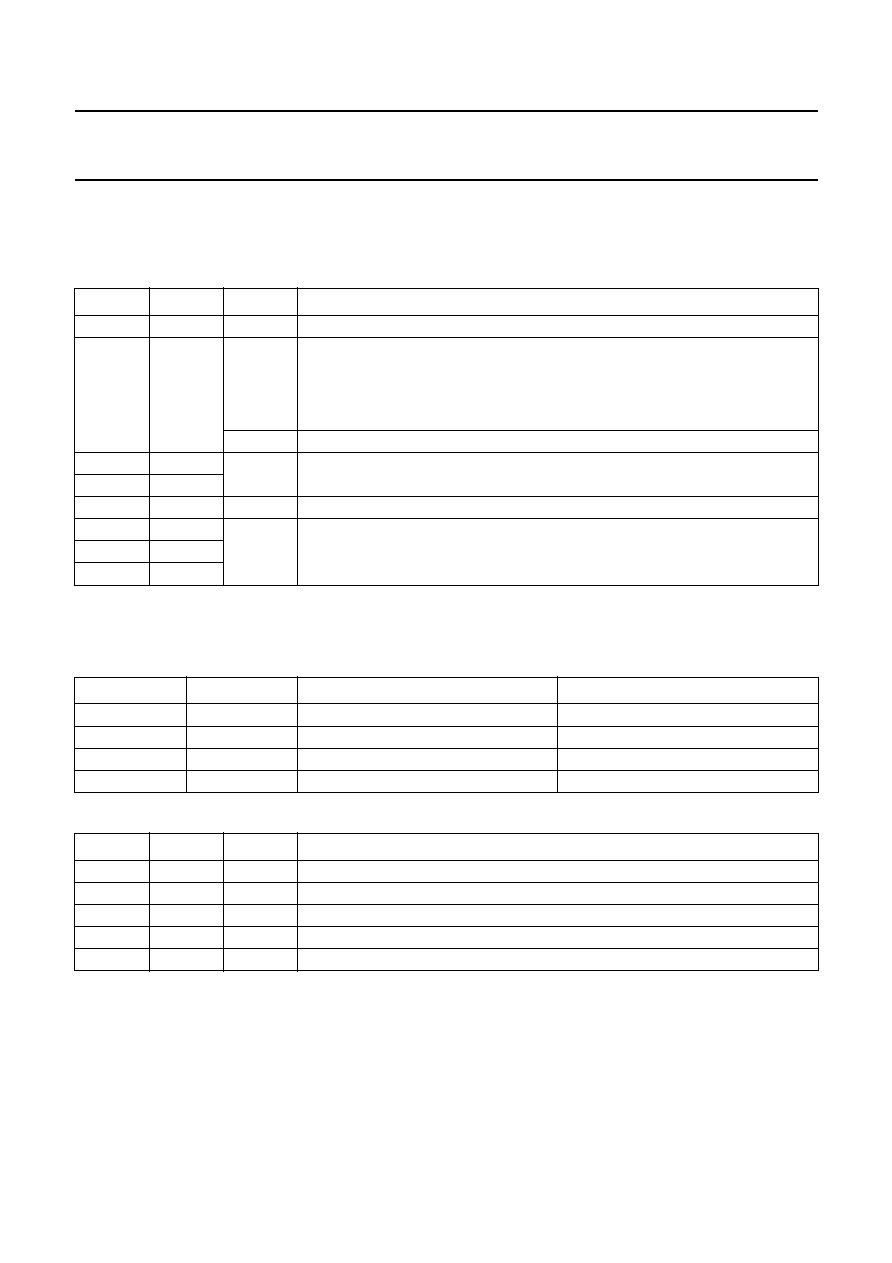
1999 Dec 20
47
Philips Semiconductors
Product specification
Digital TV Sound Processor (DTVSP)
TDA9870A
10.3.18 SCART 2
OUTPUT SELECT REGISTER
This register is used to define both the signal source to be output at SCART 2 and the output channel selector mode.
Table 39 Subaddress 21 (note 1)
Note
1. The default setting at power-up is 00000000.
Table 40 Output channel selection
Table 41 Signal source selection
BIT
NAME
VALUE
DESCRIPTION
7 (MSB)
B7
0
default value
6
SC2GAIN
1
Activates the 3 dB gain stage at the SCART 2 output buffers. As any SCART input
passes a 3 dB attenuator, this gain stage can be used to compensate that
attenuation, resulting in a 0 dB insertion loss when copying from SCART 1 input to
SCART 2 output. However, that gain must be used with great care, as it will cause
signal clipping at high input levels.
0
the audio signal output will be unchanged (0 dB gain)
5
B5
-
output channel selection (see Table 40)
4
B4
3
B3
0
default value
2
B2
-
signal source selection (see Table 41)
1
B1
0 (LSB)
B0
B5
B4
L OUTPUT
R OUTPUT
0
0
L input
R input
0
1
L input
L input
1
0
R input
R input
1
1
R input
L input
B2
B1
B0
SIGNAL SOURCE
0
0
0
SCART 1 input
0
0
1
SCART 2 input
0
1
0
external input
0
1
1
mono input
1
0
0
DAC input
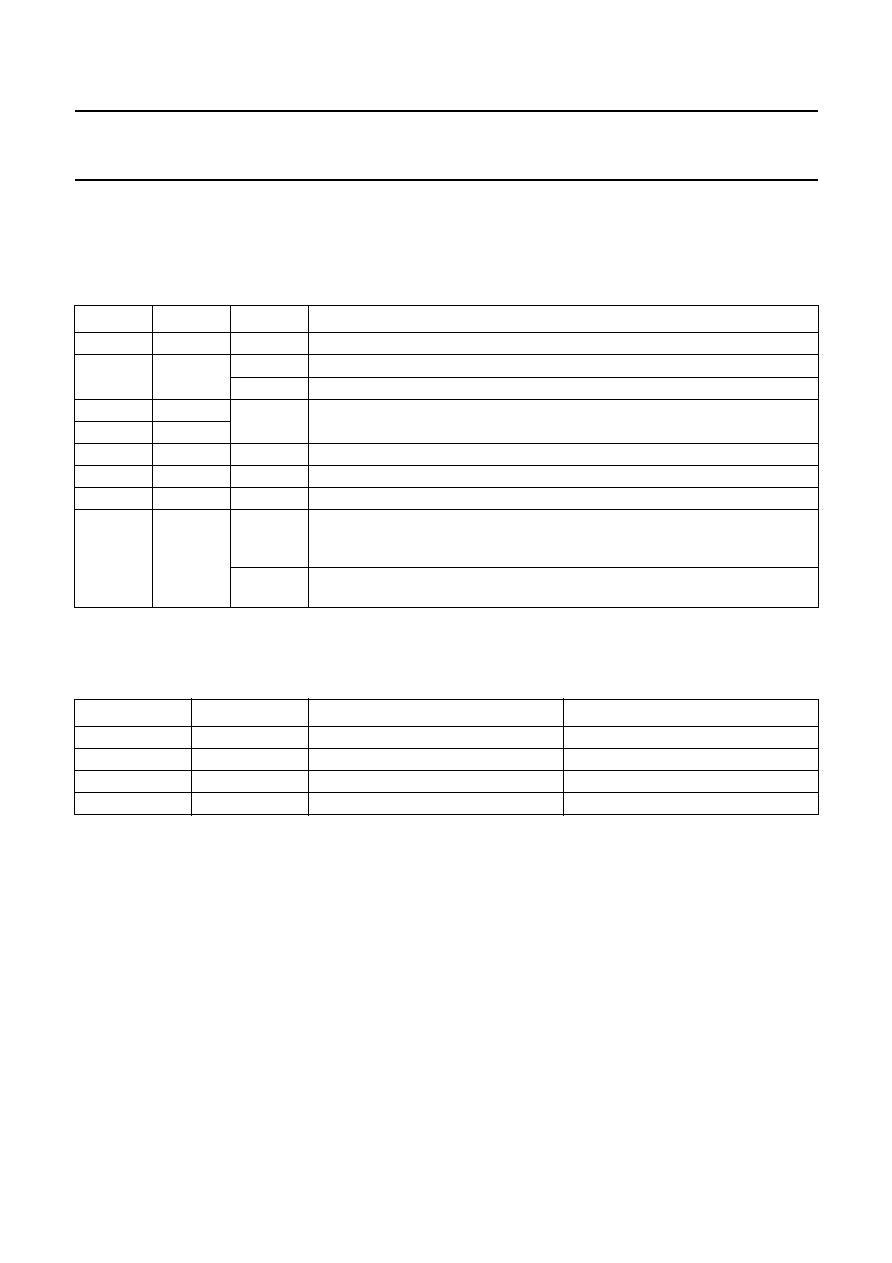
1999 Dec 20
48
Philips Semiconductors
Product specification
Digital TV Sound Processor (DTVSP)
TDA9870A
10.3.19 L
INE OUTPUT SELECT REGISTER
By definition, the line output conveys the same signal as the Main (loudspeaker) channel, but in a non-processed form.
This register is used to characterize the signal to be output at the line output and define the output channel selector mode.
Table 42 Subaddress 22 (note 1)
Note
1. The default setting at power-up is 00000000.
Table 43 Output channel selection
BIT
NAME
VALUE
DESCRIPTION
7 (MSB)
B7
0
set to logic 0
6
LINGAIN
1
activates the 3 dB gain stage at the line output buffers
0
the audio signal output will be unchanged (0 dB gain)
5
B5
-
output channel selection (see Table 43)
4
B4
3
B3
0
set to logic 0
2
B2
0
set to logic 0
1
B1
0
set to logic 0
0 (LSB)
LINSEL
1
A signal from an analog source is being processed in the Main channel for line
output. Analog signal sources comprise SCART 1 input, SCART 2 input,
external input and mono input, i.e. any input to the ADC.
0
A signal from a digital source is being processed in the Main channel for line
output. Digital signal sources comprise FM, I
2
S1 input and I
2
S2 input.
B5
B4
L OUTPUT
R OUTPUT
0
0
L input
R input
0
1
L input
L input
1
0
R input
R input
1
1
R input
L input
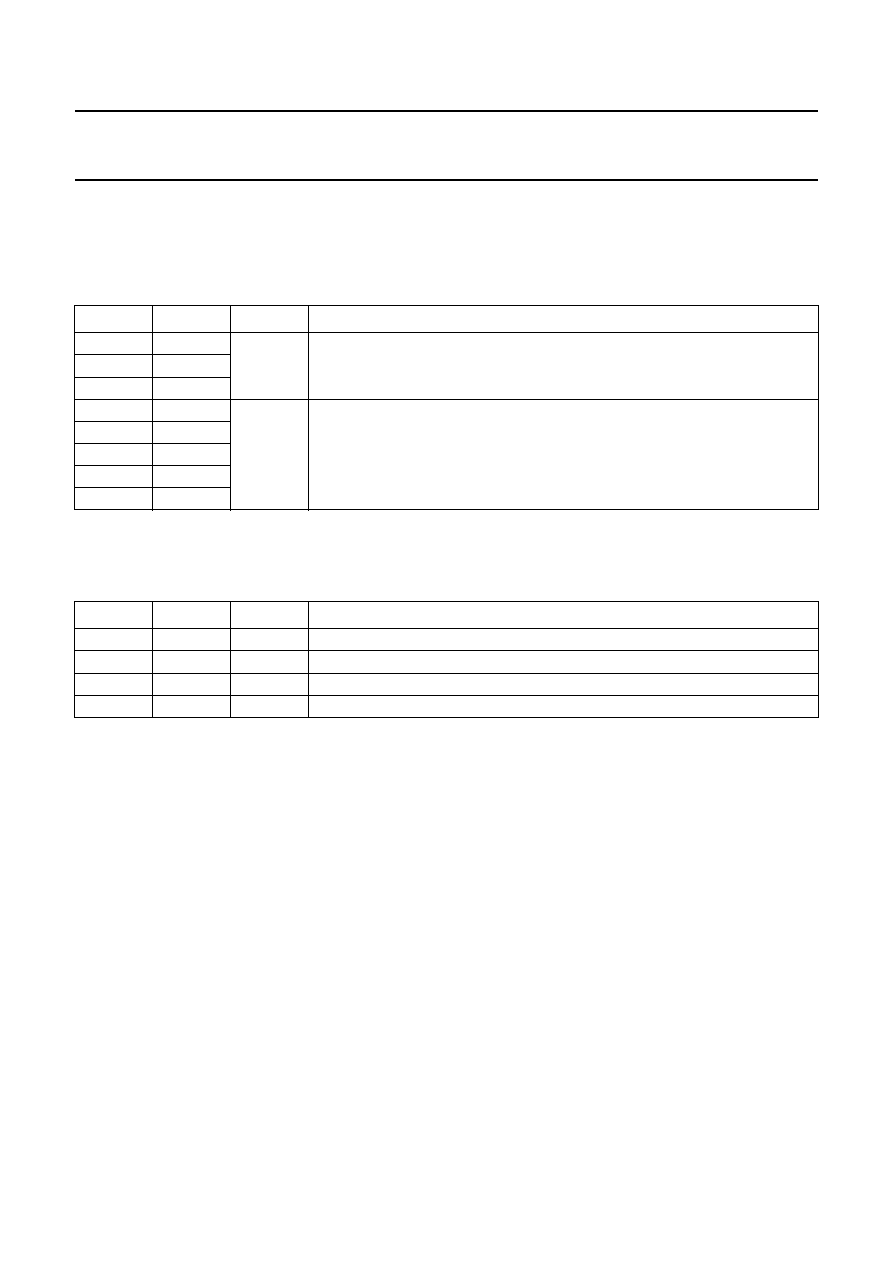
1999 Dec 20
49
Philips Semiconductors
Product specification
Digital TV Sound Processor (DTVSP)
TDA9870A
10.3.20 ADC
OUTPUT SELECT REGISTER
This register is used to define the signal source for the ADC. There is no output channel selector, because all digital
signal sinks of the ADC have their own matrix. Instead, a level adjustment facility for the ADC output is provided.
Table 44 Subaddress 23 (note 1)
Note
1. The default setting at power-up is 00000000.
Table 45 Signal source selection
BIT
NAME
VALUE
DESCRIPTION
7 (MSB)
B7
-
signal source selection (see Table 45)
6
B6
5
B5
4
B4
-
ADC level adjust (see Table 46)
3
B3
2
B2
1
B1
0 (LSB)
B0
B7
B6
B5
SIGNAL SOURCE
0
0
0
SCART 1 input
0
0
1
SCART 2 input
0
1
0
external input
0
1
1
mono input
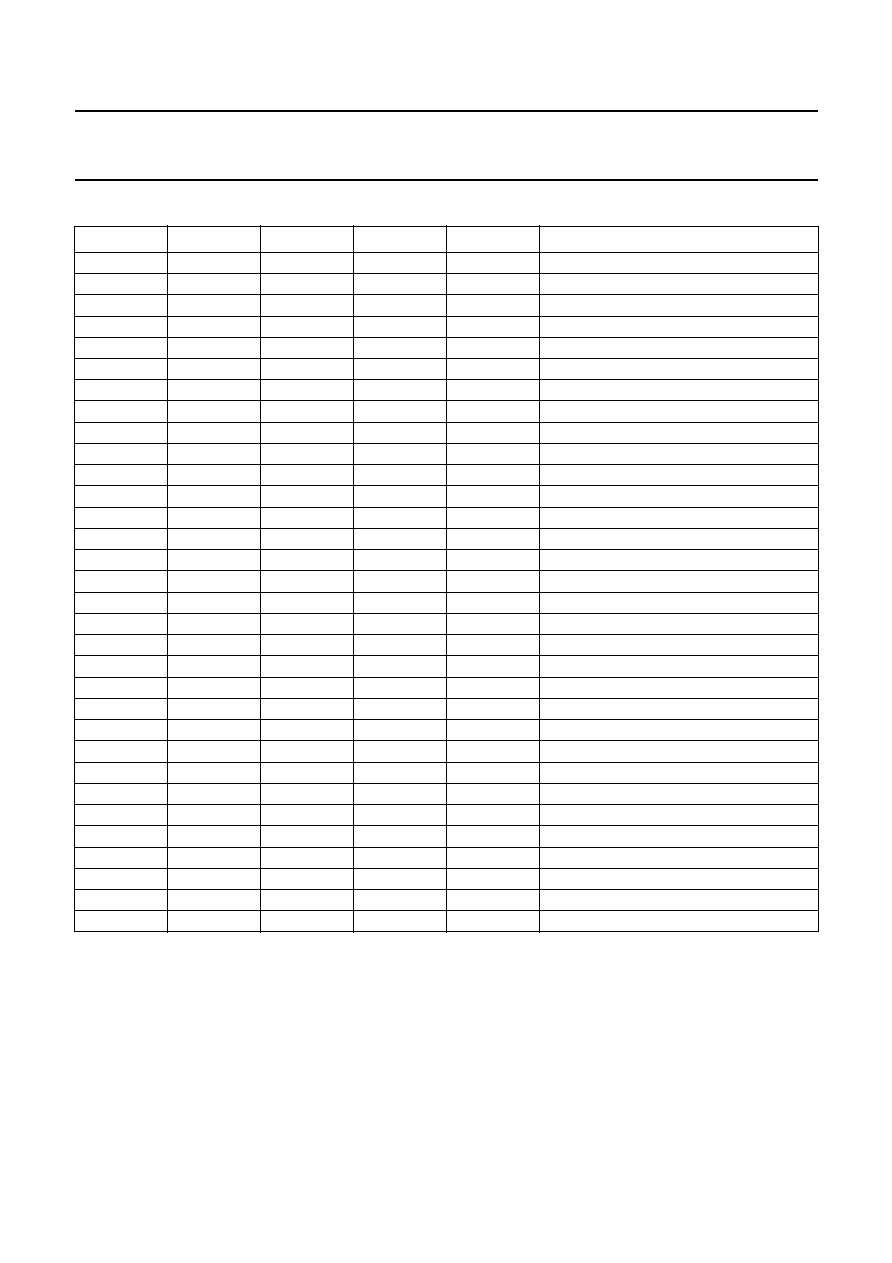
1999 Dec 20
50
Philips Semiconductors
Product specification
Digital TV Sound Processor (DTVSP)
TDA9870A
Table 46 ADC level adjust (note 1)
Note
1. If the ADC level adjust is set to 0 dB a full-scale input signal to the ADC results into a level of
-
6 dB full-scale at the
digital crossbar.
B4
B3
B2
B1
B0
GAIN SETTING (dB)
0
1
1
1
1
+15
0
1
1
1
0
+14
0
1
1
0
1
+13
0
1
1
0
0
+12
0
1
0
1
1
+11
0
1
0
1
0
+10
0
1
0
0
1
+9
0
1
0
0
0
+8
0
0
1
1
1
+7
0
0
1
1
0
+6
0
0
1
0
1
+5
0
0
1
0
0
+4
0
0
0
1
1
+3
0
0
0
1
0
+2
0
0
0
0
1
+1
0
0
0
0
0
0
1
1
1
1
1
-
1
1
1
1
1
0
-
2
1
1
1
0
1
-
3
1
1
1
0
0
-
4
1
1
0
1
1
-
5
1
1
0
1
0
-
6
1
1
0
0
1
-
7
1
1
0
0
0
-
8
1
0
1
1
1
-
9
1
0
1
1
0
-
10
1
0
1
0
1
-
11
1
0
1
0
0
-
12
1
0
0
1
1
-
13
1
0
0
1
0
-
14
1
0
0
0
1
-
15
1
0
0
0
0
mute
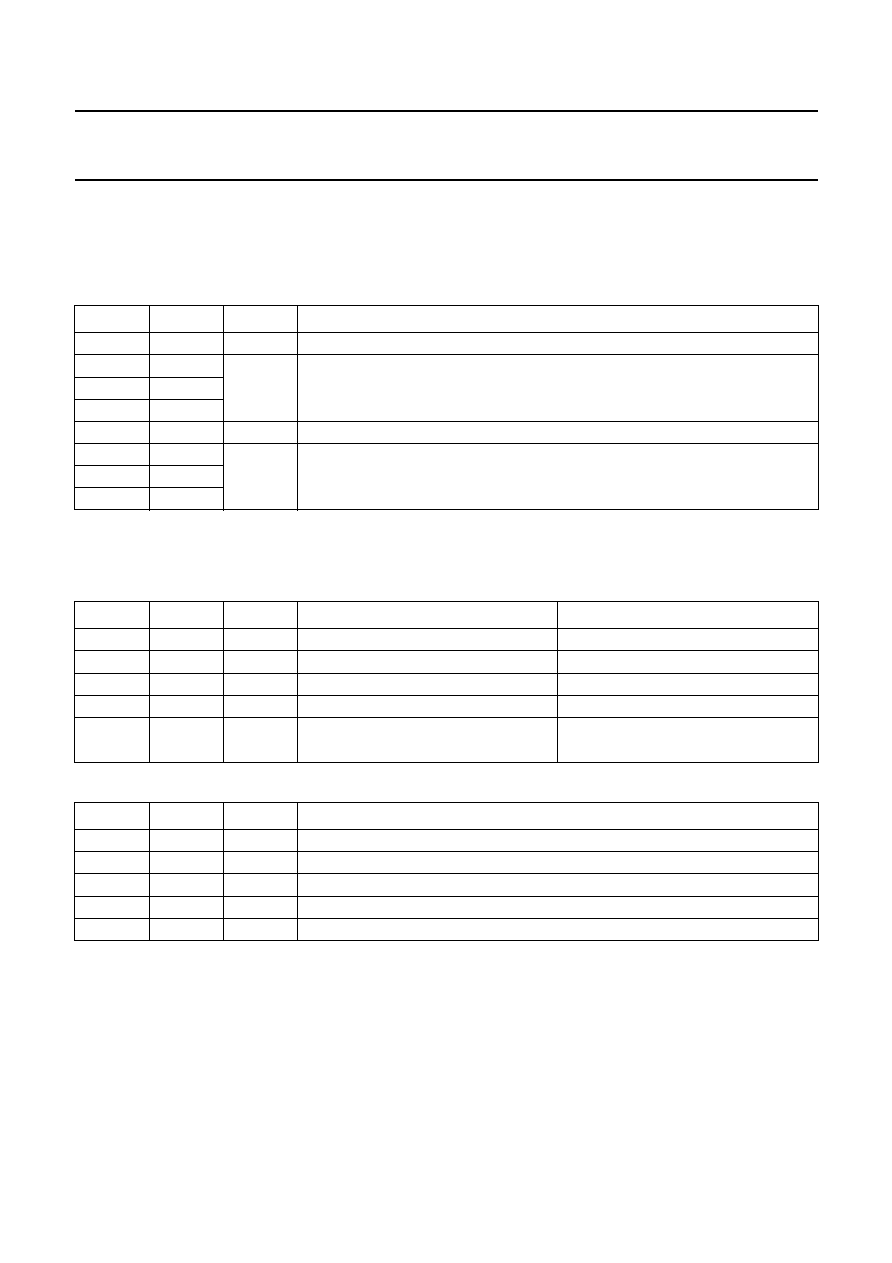
1999 Dec 20
51
Philips Semiconductors
Product specification
Digital TV Sound Processor (DTVSP)
TDA9870A
10.3.21 M
AIN CHANNEL SELECT REGISTER
This register is used to define both the signal source to be processed in the Main (loudspeaker) channel and the mode
of the digital matrix for signal selection.
Table 47 Subaddress 24 (note 1)
Note
1. The default setting at power-up is 00000000.
Table 48 Output channel selection
Table 49 Signal source selection
BIT
NAME
VALUE
DESCRIPTION
7 (MSB)
B7
0
default value
6
B6
-
output channel selection (see Table 48)
5
B5
4
B4
3
B3
0
default value
2
B2
-
signal source selection (see Table 49)
1
B1
0 (LSB)
B0
B6
B5
B4
L OUTPUT
R OUTPUT
0
0
0
L input
R input
0
0
1
L input
L input
0
1
0
R input
R input
0
1
1
R input
L input
1
0
0
B2
B1
B0
SIGNAL SOURCE
0
0
0
FM input
0
0
1
don't care
0
1
0
I
2
S1 input
0
1
1
I
2
S2 input
1
0
0
ADC input
L
R
+
2
--------------
L
R
+
2
--------------

1999 Dec 20
52
Philips Semiconductors
Product specification
Digital TV Sound Processor (DTVSP)
TDA9870A
10.3.22 A
UDIO EFFECTS REGISTER
Switching the AVL off will reset the associated hardware to a defined state.
When the signal source for the Main channel is changed while the AVL is on, the AVL needs to be reset in order to avoid
excessive settling times. This can be achieved by switching the AVL off and on again.
The pseudo stereo function is based on an all-pass filter. A 90 degrees phase shift occurs at the frequencies stated in
Table 52. There is a gain of 3 dB in the left audio channel.
Table 50 Subaddress 25 (note 1)
Note
1. The default setting at power-up is 00000000.
Table 51 Spatial control setting
Table 52 Pseudo control setting
Table 53 AVL control mode
BIT
NAME
VALUE
DESCRIPTION
7 (MSB)
B7
0
Default value.
6
B6
0
Default value.
5
SPATIAL1
-
These bits set the amount of the effect function (stereo base width expansion)
for stereo signals in the Main channel (see Table 51). This function should be
activated only in accordance with the result of the sound mode identification.
4
SPATIAL0
3
PSEUDO1
-
These bits set the amount of the effect function (pseudo stereo) for mono
signals in the Main channel (see Table 52). This function should be activated
only in accordance with the result of the sound mode identification.
2
PSEUDO0
1
AVL1
-
These bits set the mode of operation of the automatic volume level control
function at the entrance to the Main (loudspeaker) channel (see Table 53).
0 (LSB)
AVL0
B5
B4
SPATIAL SETTING (%)
0
0
off
0
1
30
1
0
40
1
1
52
B3
B2
PSEUDO SETTING (Hz)
0
0
off
0
1
300
1
0
200
1
1
150
B1
B0
AVL MODE
0
0
off/reset
0
1
short decay
1
0
medium decay
1
1
long decay

1999 Dec 20
53
Philips Semiconductors
Product specification
Digital TV Sound Processor (DTVSP)
TDA9870A
10.3.23 V
OLUME CONTROL REGISTERS
(M
AIN
)
These two registers control the volume setting of the Main (loudspeaker) channel. The register at subaddress 26 applies
to the left channel signal, while the register at subaddress 27 applies to the right channel signal.
Balance control is exercised by offsetting the left and right channel volume settings.
Table 54 Subaddresses 26 and 27
MSB
LSB
VOLUME SETTING (dB)
B7
B6
B5
B4
B3
B2
B1
B0
0
0
0
1
1
0
0
0
+24
0
0
0
1
0
1
1
1
+23
0
0
0
1
0
1
1
0
+22
0
0
0
1
0
1
0
1
+21
0
0
0
1
0
1
0
0
+20
0
0
0
1
0
0
1
1
+19
0
0
0
1
0
0
1
0
+18
0
0
0
1
0
0
0
1
+17
0
0
0
1
0
0
0
0
+16
0
0
0
0
1
1
1
1
+15
0
0
0
0
1
1
1
0
+14
0
0
0
0
1
1
0
1
+13
0
0
0
0
1
1
0
0
+12
0
0
0
0
1
0
1
1
+11
0
0
0
0
1
0
1
0
+10
0
0
0
0
1
0
0
1
+9
0
0
0
0
1
0
0
0
+8
0
0
0
0
0
1
1
1
+7
0
0
0
0
0
1
1
0
+6
0
0
0
0
0
1
0
1
+5
0
0
0
0
0
1
0
0
+4
0
0
0
0
0
0
1
1
+3
0
0
0
0
0
0
1
0
+2
0
0
0
0
0
0
0
1
+1
0
0
0
0
0
0
0
0
0
1
1
1
1
1
1
1
1
-
1
1
1
1
1
1
1
1
0
-
2
1
1
1
1
1
1
0
1
-
3
1
1
1
1
1
1
0
0
-
4
1
1
1
1
1
0
1
1
-
5
1
1
1
1
1
0
1
0
-
6
1
1
1
1
1
0
0
1
-
7
1
1
1
1
1
0
0
0
-
8
1
1
1
1
0
1
1
1
-
9

1999 Dec 20
54
Philips Semiconductors
Product specification
Digital TV Sound Processor (DTVSP)
TDA9870A
1
1
1
1
0
1
1
0
-
10
1
1
1
1
0
1
0
1
-
11
1
1
1
1
0
1
0
0
-
12
1
1
1
1
0
0
1
1
-
13
1
1
1
1
0
0
1
0
-
14
1
1
1
1
0
0
0
1
-
15
1
1
1
1
0
0
0
0
-
16
1
1
1
0
1
1
1
1
-
17
1
1
1
0
1
1
1
0
-
18
1
1
1
0
1
1
0
1
-
19
1
1
1
0
1
1
0
0
-
20
1
1
1
0
1
0
1
1
-
21
1
1
1
0
1
0
1
0
-
22
1
1
1
0
1
0
0
1
-
23
1
1
1
0
1
0
0
0
-
24
1
1
1
0
0
1
1
1
-
25
1
1
1
0
0
1
1
0
-
26
1
1
1
0
0
1
0
1
-
27
1
1
1
0
0
1
0
0
-
28
1
1
1
0
0
0
1
1
-
29
1
1
1
0
0
0
1
0
-
30
1
1
1
0
0
0
0
1
-
31
1
1
1
0
0
0
0
0
-
32
1
1
0
1
1
1
1
1
-
33
1
1
0
1
1
1
1
0
-
34
1
1
0
1
1
1
0
1
-
35
1
1
0
1
1
1
0
0
-
36
1
1
0
1
1
0
1
1
-
37
1
1
0
1
1
0
1
0
-
38
1
1
0
1
1
0
0
1
-
39
1
1
0
1
1
0
0
0
-
40
1
1
0
1
0
1
1
1
-
41
1
1
0
1
0
1
1
0
-
42
1
1
0
1
0
1
0
1
-
43
1
1
0
1
0
1
0
0
-
44
1
1
0
1
0
0
1
1
-
45
1
1
0
1
0
0
1
0
-
46
1
1
0
1
0
0
0
1
-
47
1
1
0
1
0
0
0
0
-
48
MSB
LSB
VOLUME SETTING (dB)
B7
B6
B5
B4
B3
B2
B1
B0

1999 Dec 20
55
Philips Semiconductors
Product specification
Digital TV Sound Processor (DTVSP)
TDA9870A
Note
1. The default setting at power-up is 10101100.
1
1
0
0
1
1
1
1
-
49
1
1
0
0
1
1
1
0
-
50
1
1
0
0
1
1
0
1
-
51
1
1
0
0
1
1
0
0
-
52
1
1
0
0
1
0
1
1
-
53
1
1
0
0
1
0
1
0
-
54
1
1
0
0
1
0
0
1
-
55
1
1
0
0
1
0
0
0
-
56
1
1
0
0
0
1
1
1
-
57
1
1
0
0
0
1
1
0
-
58
1
1
0
0
0
1
0
1
-
59
1
1
0
0
0
1
0
0
-
60
1
1
0
0
0
0
1
1
-
61
1
1
0
0
0
0
1
0
-
62
1
1
0
0
0
0
0
1
-
63
1
1
0
0
0
0
0
0
-
64
1
0
1
1
1
1
1
1
-
65
1
0
1
1
1
1
1
0
-
66
1
0
1
1
1
1
0
1
-
67
1
0
1
1
1
1
0
0
-
68
1
0
1
1
1
0
1
1
-
69
1
0
1
1
1
0
1
0
-
70
1
0
1
1
1
0
0
1
-
71
1
0
1
1
1
0
0
0
-
72
1
0
1
1
0
1
1
1
-
73
1
0
1
1
0
1
1
0
-
74
1
0
1
1
0
1
0
1
-
75
1
0
1
1
0
1
0
0
-
76
1
0
1
1
0
0
1
1
-
77
1
0
1
1
0
0
1
0
-
78
1
0
1
1
0
0
0
1
-
79
1
0
1
1
0
0
0
0
-
80
1
0
1
0
1
1
1
1
-
81
1
0
1
0
1
1
1
0
-
82
1
0
1
0
1
1
0
1
-
83
1
0
1
0
1
1
0
0
mute (note 1)
MSB
LSB
VOLUME SETTING (dB)
B7
B6
B5
B4
B3
B2
B1
B0

1999 Dec 20
56
Philips Semiconductors
Product specification
Digital TV Sound Processor (DTVSP)
TDA9870A
10.3.24 C
ONTOUR CONTROL REGISTER
This register is used to apply the contour or loudness function (physiological volume control) to the left and right signal
channels of the Main channel by means of an extra bass boost. The gain setting must be chosen in accordance with the
volume control setting for the Main channel. For example, the contour gain could be incremented for every 5 dB, or so,
of decrease of the volume setting. This needs to be done by the microcontroller. The 0 dB contour setting is equal to
contour off.
Table 55 Subaddress 28
Note
1. The default setting at power-up is 00000000.
MSB
LSB
CONTOUR GAIN (dB)
B7
B6
B5
B4
B3
B2
B1
B0
0
0
0
1
0
0
1
0
18
0
0
0
1
0
0
0
1
17
0
0
0
1
0
0
0
0
16
0
0
0
0
1
1
1
1
15
0
0
0
0
1
1
1
0
14
0
0
0
0
1
1
0
1
13
0
0
0
0
1
1
0
0
12
0
0
0
0
1
0
1
1
11
0
0
0
0
1
0
1
0
10
0
0
0
0
1
0
0
1
9
0
0
0
0
1
0
0
0
8
0
0
0
0
0
1
1
1
7
0
0
0
0
0
1
1
0
6
0
0
0
0
0
1
0
1
5
0
0
0
0
0
1
0
0
4
0
0
0
0
0
0
1
1
3
0
0
0
0
0
0
1
0
2
0
0
0
0
0
0
0
1
1
0
0
0
0
0
0
0
0
0 (note 1)

1999 Dec 20
57
Philips Semiconductors
Product specification
Digital TV Sound Processor (DTVSP)
TDA9870A
10.3.25 B
ASS CONTROL REGISTER
(M
AIN
)
This register is used to apply bass control to the left and right signal channels of the Main channel.
Table 56 Subaddress 29
Note
1. The default setting at power-up is 00000000.
MSB
LSB
BASS SETTING (dB)
B7
B6
B5
B4
B3
B2
B1
B0
0
0
0
0
1
1
1
1
+15
0
0
0
0
1
1
1
0
+14
0
0
0
0
1
1
0
1
+13
0
0
0
0
1
1
0
0
+12
0
0
0
0
1
0
1
1
+11
0
0
0
0
1
0
1
0
+10
0
0
0
0
1
0
0
1
+9
0
0
0
0
1
0
0
0
+8
0
0
0
0
0
1
1
1
+7
0
0
0
0
0
1
1
0
+6
0
0
0
0
0
1
0
1
+5
0
0
0
0
0
1
0
0
+4
0
0
0
0
0
0
1
1
+3
0
0
0
0
0
0
1
0
+2
0
0
0
0
0
0
0
1
+1
0
0
0
0
0
0
0
0
0 (note 1)
0
0
0
1
1
1
1
1
-
1
0
0
0
1
1
1
1
0
-
2
0
0
0
1
1
1
0
1
-
3
0
0
0
1
1
1
0
0
-
4
0
0
0
1
1
0
1
1
-
5
0
0
0
1
1
0
1
0
-
6
0
0
0
1
1
0
0
1
-
7
0
0
0
1
1
0
0
0
-
8
0
0
0
1
0
1
1
1
-
9
0
0
0
1
0
1
1
0
-
10
0
0
0
1
0
1
0
1
-
11
0
0
0
1
0
1
0
0
-
12

1999 Dec 20
58
Philips Semiconductors
Product specification
Digital TV Sound Processor (DTVSP)
TDA9870A
10.3.26 T
REBLE CONTROL REGISTER
(M
AIN
)
This register is used to apply treble control to the left and right signal channels of the Main channel.
Table 57 Subaddress 30
Note
1. The default setting at power-up is 00000000.
MSB
LSB
TREBLE SETTING (dB)
B7
B6
B5
B4
B3
B2
B1
B0
0
0
0
0
1
1
0
0
+12
0
0
0
0
1
0
1
1
+11
0
0
0
0
1
0
1
0
+10
0
0
0
0
1
0
0
1
+9
0
0
0
0
1
0
0
0
+8
0
0
0
0
0
1
1
1
+7
0
0
0
0
0
1
1
0
+6
0
0
0
0
0
1
0
1
+5
0
0
0
0
0
1
0
0
+4
0
0
0
0
0
0
1
1
+3
0
0
0
0
0
0
1
0
+2
0
0
0
0
0
0
0
1
+1
0
0
0
0
0
0
0
0
0 (note 1)
0
0
0
1
1
1
1
1
-
1
0
0
0
1
1
1
1
0
-
2
0
0
0
1
1
1
0
1
-
3
0
0
0
1
1
1
0
0
-
4
0
0
0
1
1
0
1
1
-
5
0
0
0
1
1
0
1
0
-
6
0
0
0
1
1
0
0
1
-
7
0
0
0
1
1
0
0
0
-
8
0
0
0
1
0
1
1
1
-
9
0
0
0
1
0
1
1
0
-
10
0
0
0
1
0
1
0
1
-
11
0
0
0
1
0
1
0
0
-
12
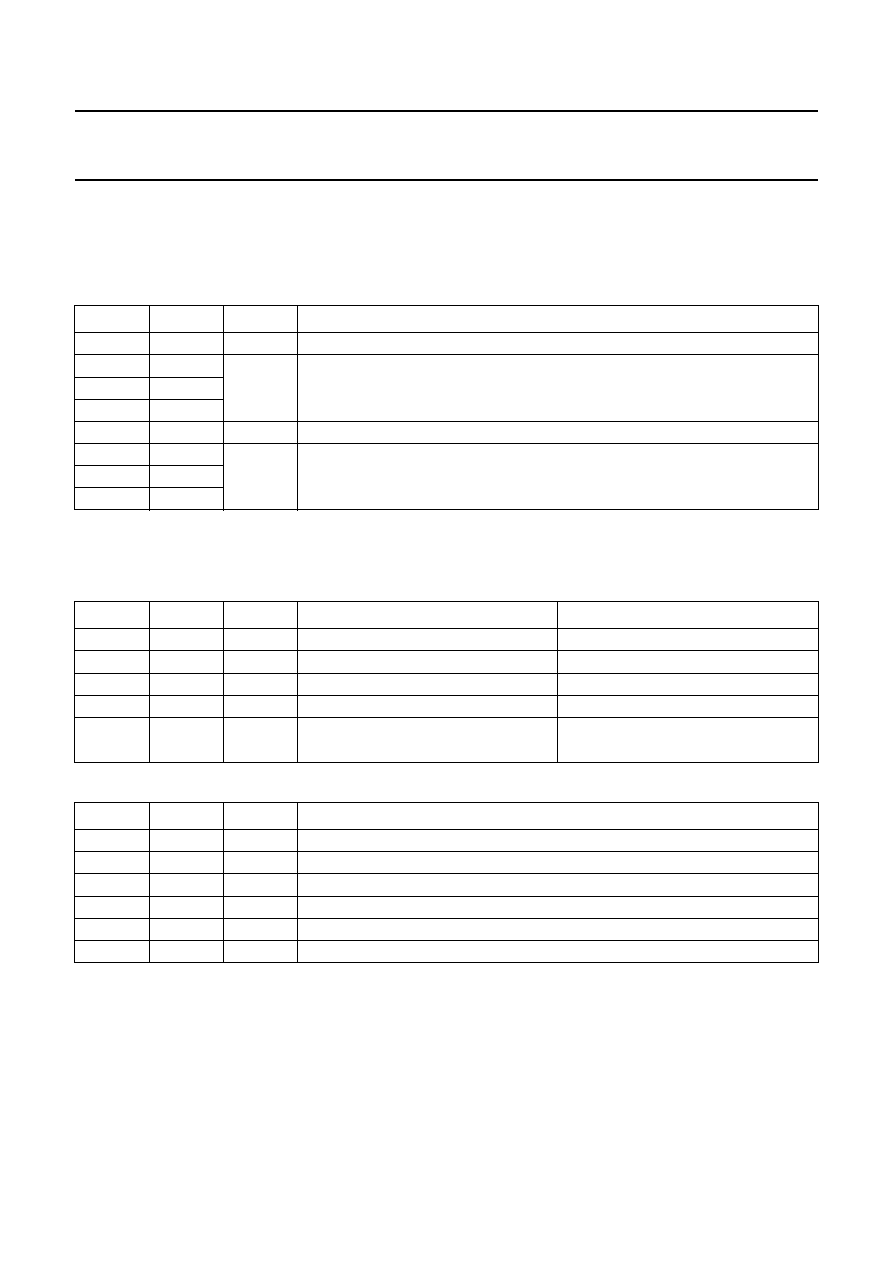
1999 Dec 20
59
Philips Semiconductors
Product specification
Digital TV Sound Processor (DTVSP)
TDA9870A
10.3.27 A
UXILIARY CHANNEL SELECT REGISTER
This register is used to define both the signal source to be processed in the Auxiliary (headphone) channel and the mode
of the digital matrix for signal selection.
Table 58 Subaddress 31 (note 1)
Note
1. The default setting at power-up is 00000000.
Table 59 Output channel selection
Table 60 Signal source selection
BIT
NAME
VALUE
DESCRIPTION
7 (MSB)
B7
0
default value
6
B6
-
output channel selection (see Table 59)
5
B5
4
B4
3
B3
0
default value
2
B2
-
signal source selection (see Table 60)
1
B1
0 (LSB)
B0
B6
B5
B4
L OUTPUT
R OUTPUT
0
0
0
L input
R input
0
0
1
L input
L input
0
1
0
R input
R input
0
1
1
R input
L input
1
0
0
B2
B1
B0
SIGNAL SOURCE
0
0
0
FM input
0
0
1
don't care
0
1
0
I
2
S1 input
0
1
1
I
2
S2 input
1
0
0
ADC input
1
0
1
AVL input
L
R
+
2
--------------
L
R
+
2
--------------
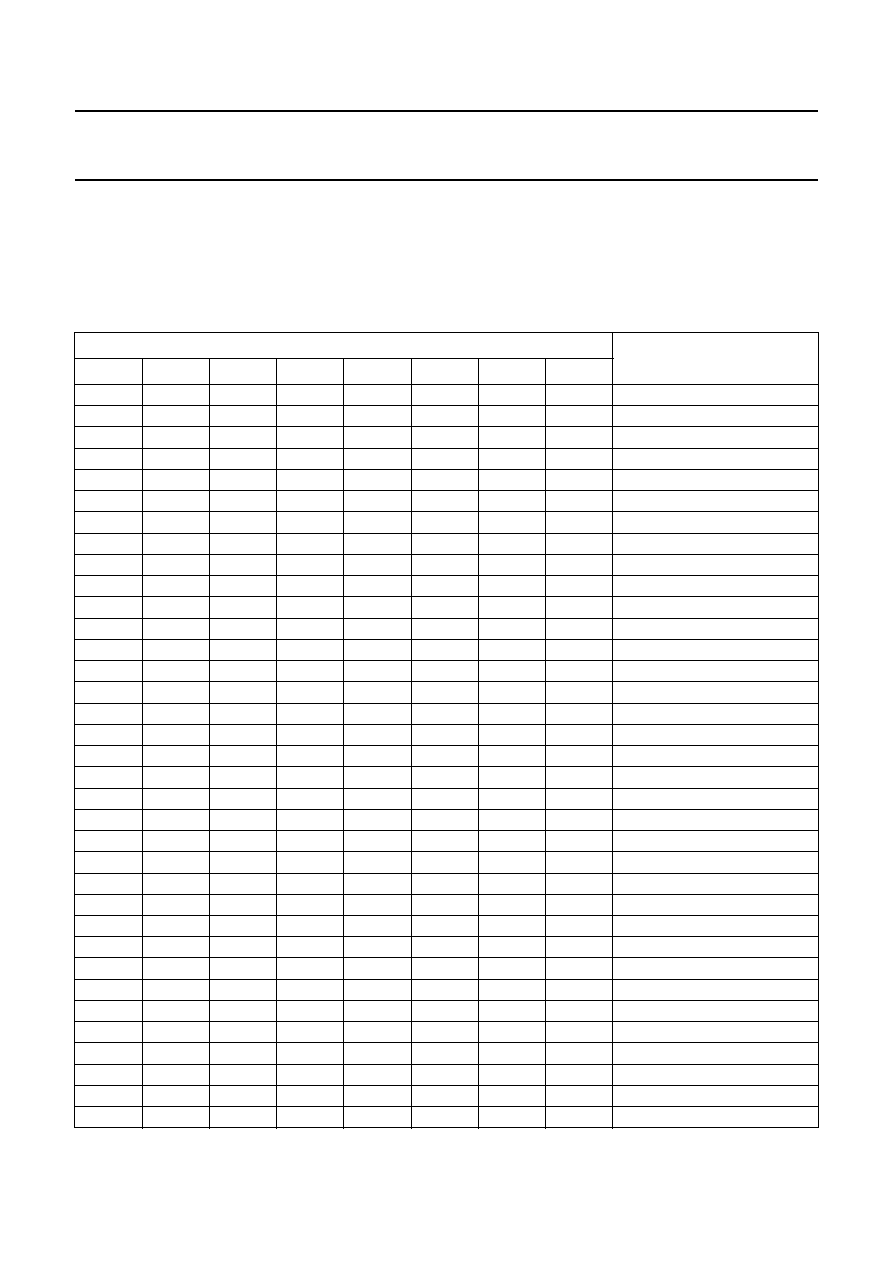
1999 Dec 20
60
Philips Semiconductors
Product specification
Digital TV Sound Processor (DTVSP)
TDA9870A
10.3.28 V
OLUME CONTROL REGISTERS
(A
UXILIARY
)
These two registers control the volume setting of the Auxiliary (headphone) channel. The register at subaddress 32
applies to the left channel signal, while the register at subaddress 33 applies to the right channel signal.
Balance control is exercised by offsetting the left and right channel volume settings.
Table 61 Subaddresses 32 and 33
MSB
LSB
VOLUME SETTING (dB)
B7
B6
B5
B4
B3
B2
B1
B0
0
0
0
1
1
0
0
0
+24
0
0
0
1
0
1
1
1
+23
0
0
0
1
0
1
1
0
+22
0
0
0
1
0
1
0
1
+21
0
0
0
1
0
1
0
0
+20
0
0
0
1
0
0
1
1
+19
0
0
0
1
0
0
1
0
+18
0
0
0
1
0
0
0
1
+17
0
0
0
1
0
0
0
0
+16
0
0
0
0
1
1
1
1
+15
0
0
0
0
1
1
1
0
+14
0
0
0
0
1
1
0
1
+13
0
0
0
0
1
1
0
0
+12
0
0
0
0
1
0
1
1
+11
0
0
0
0
1
0
1
0
+10
0
0
0
0
1
0
0
1
+9
0
0
0
0
1
0
0
0
+8
0
0
0
0
0
1
1
1
+7
0
0
0
0
0
1
1
0
+6
0
0
0
0
0
1
0
1
+5
0
0
0
0
0
1
0
0
+4
0
0
0
0
0
0
1
1
+3
0
0
0
0
0
0
1
0
+2
0
0
0
0
0
0
0
1
+1
0
0
0
0
0
0
0
0
0
1
1
1
1
1
1
1
1
-
1
1
1
1
1
1
1
1
0
-
2
1
1
1
1
1
1
0
1
-
3
1
1
1
1
1
1
0
0
-
4
1
1
1
1
1
0
1
1
-
5
1
1
1
1
1
0
1
0
-
6
1
1
1
1
1
0
0
1
-
7
1
1
1
1
1
0
0
0
-
8
1
1
1
1
0
1
1
1
-
9
1
1
1
1
0
1
1
0
-
10
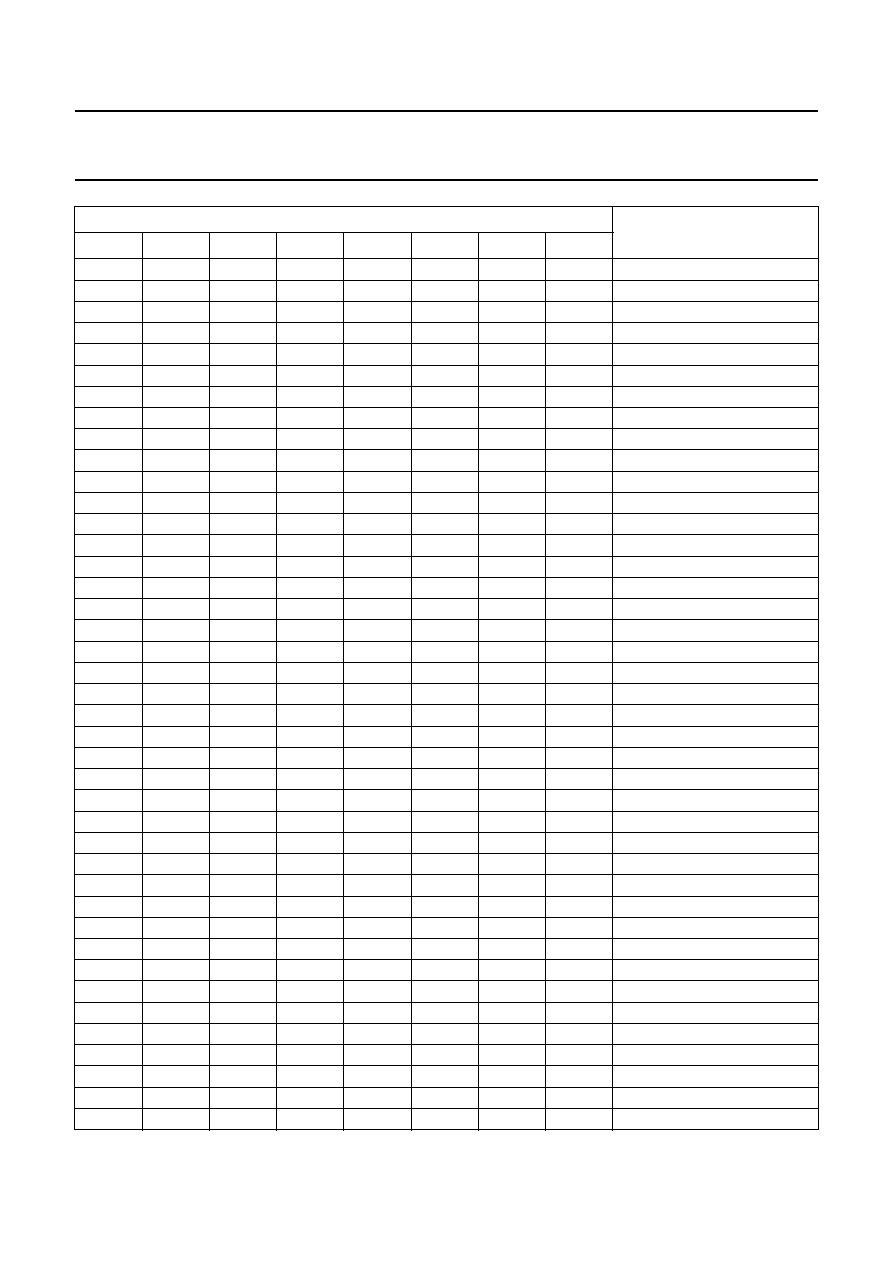
1999 Dec 20
61
Philips Semiconductors
Product specification
Digital TV Sound Processor (DTVSP)
TDA9870A
1
1
1
1
0
1
0
1
-
11
1
1
1
1
0
1
0
0
-
12
1
1
1
1
0
0
1
1
-
13
1
1
1
1
0
0
1
0
-
14
1
1
1
1
0
0
0
1
-
15
1
1
1
1
0
0
0
0
-
16
1
1
1
0
1
1
1
1
-
17
1
1
1
0
1
1
1
0
-
18
1
1
1
0
1
1
0
1
-
19
1
1
1
0
1
1
0
0
-
20
1
1
1
0
1
0
1
1
-
21
1
1
1
0
1
0
1
0
-
22
1
1
1
0
1
0
0
1
-
23
1
1
1
0
1
0
0
0
-
24
1
1
1
0
0
1
1
1
-
25
1
1
1
0
0
1
1
0
-
26
1
1
1
0
0
1
0
1
-
27
1
1
1
0
0
1
0
0
-
28
1
1
1
0
0
0
1
1
-
29
1
1
1
0
0
0
1
0
-
30
1
1
1
0
0
0
0
1
-
31
1
1
1
0
0
0
0
0
-
32
1
1
0
1
1
1
1
1
-
33
1
1
0
1
1
1
1
0
-
34
1
1
0
1
1
1
0
1
-
35
1
1
0
1
1
1
0
0
-
36
1
1
0
1
1
0
1
1
-
37
1
1
0
1
1
0
1
0
-
38
1
1
0
1
1
0
0
1
-
39
1
1
0
1
1
0
0
0
-
40
1
1
0
1
0
1
1
1
-
41
1
1
0
1
0
1
1
0
-
42
1
1
0
1
0
1
0
1
-
43
1
1
0
1
0
1
0
0
-
44
1
1
0
1
0
0
1
1
-
45
1
1
0
1
0
0
1
0
-
46
1
1
0
1
0
0
0
1
-
47
1
1
0
1
0
0
0
0
-
48
1
1
0
0
1
1
1
1
-
49
1
1
0
0
1
1
1
0
-
50
1
1
0
0
1
1
0
1
-
51
MSB
LSB
VOLUME SETTING (dB)
B7
B6
B5
B4
B3
B2
B1
B0
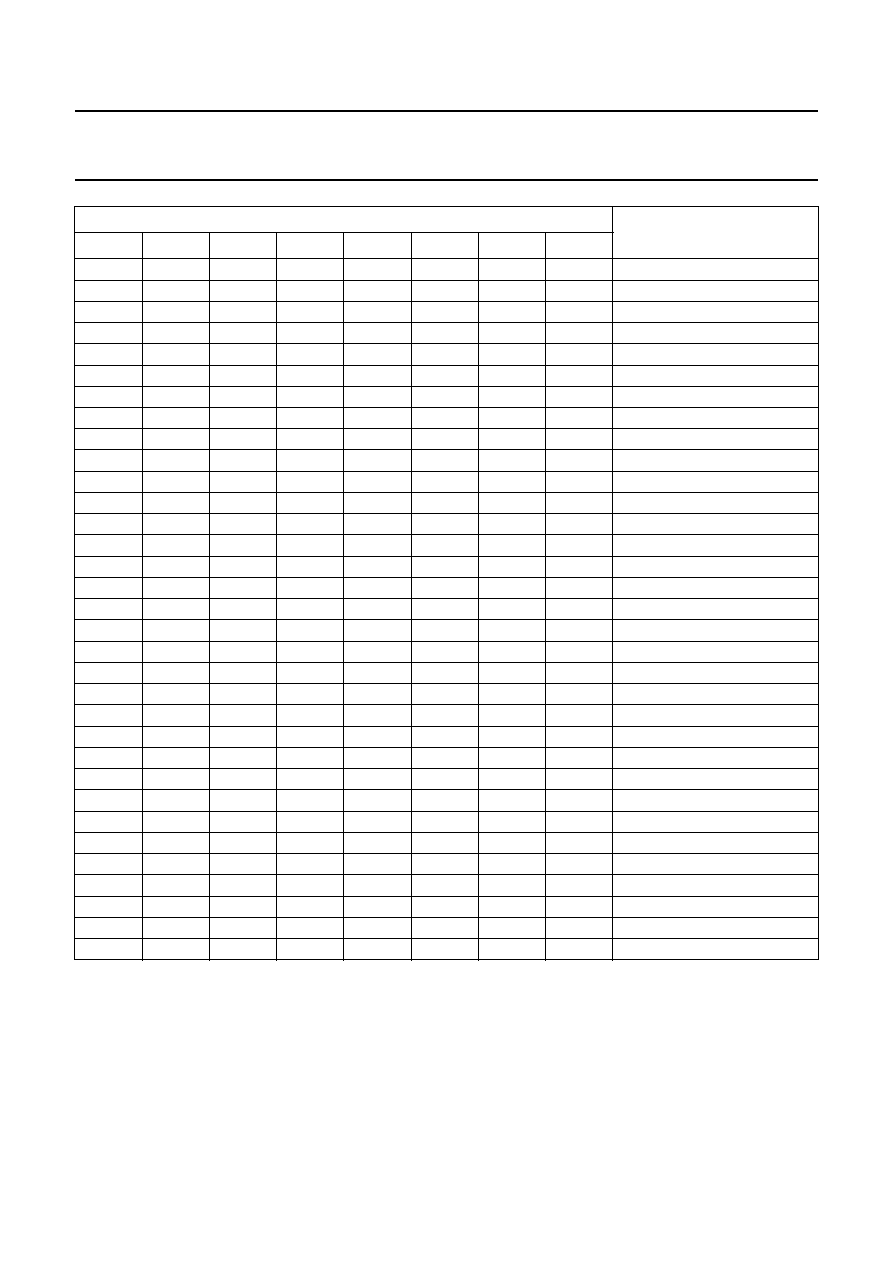
1999 Dec 20
62
Philips Semiconductors
Product specification
Digital TV Sound Processor (DTVSP)
TDA9870A
Note
1. The default setting at power-up is 10101100.
1
1
0
0
1
1
0
0
-
52
1
1
0
0
1
0
1
1
-
53
1
1
0
0
1
0
1
0
-
54
1
1
0
0
1
0
0
1
-
55
1
1
0
0
1
0
0
0
-
56
1
1
0
0
0
1
1
1
-
57
1
1
0
0
0
1
1
0
-
58
1
1
0
0
0
1
0
1
-
59
1
1
0
0
0
1
0
0
-
60
1
1
0
0
0
0
1
1
-
61
1
1
0
0
0
0
1
0
-
62
1
1
0
0
0
0
0
1
-
63
1
1
0
0
0
0
0
0
-
64
1
0
1
1
1
1
1
1
-
65
1
0
1
1
1
1
1
0
-
66
1
0
1
1
1
1
0
1
-
67
1
0
1
1
1
1
0
0
-
68
1
0
1
1
1
0
1
1
-
69
1
0
1
1
1
0
1
0
-
70
1
0
1
1
1
0
0
1
-
71
1
0
1
1
1
0
0
0
-
72
1
0
1
1
0
1
1
1
-
73
1
0
1
1
0
1
1
0
-
74
1
0
1
1
0
1
0
1
-
75
1
0
1
1
0
1
0
0
-
76
1
0
1
1
0
0
1
1
-
77
1
0
1
1
0
0
1
0
-
78
1
0
1
1
0
0
0
1
-
79
1
0
1
1
0
0
0
0
-
80
1
0
1
0
1
1
1
1
-
81
1
0
1
0
1
1
1
0
-
82
1
0
1
0
1
1
0
1
-
83
1
0
1
0
1
1
0
0
mute (note 1)
MSB
LSB
VOLUME SETTING (dB)
B7
B6
B5
B4
B3
B2
B1
B0

1999 Dec 20
63
Philips Semiconductors
Product specification
Digital TV Sound Processor (DTVSP)
TDA9870A
10.3.29 B
ASS CONTROL REGISTER
(A
UXILIARY
)
This register is used to apply bass control to the left and right signal channels of the Auxiliary channel.
Table 62 Subaddress 34
Note
1. The default setting at power-up is 00000000.
MSB
LSB
BASS SETTING (dB)
B7
B6
B5
B4
B3
B2
B1
B0
0
0
0
0
1
1
1
1
+15
0
0
0
0
1
1
1
0
+14
0
0
0
0
1
1
0
1
+13
0
0
0
0
1
1
0
0
+12
0
0
0
0
1
0
1
1
+11
0
0
0
0
1
0
1
0
+10
0
0
0
0
1
0
0
1
+9
0
0
0
0
1
0
0
0
+8
0
0
0
0
0
1
1
1
+7
0
0
0
0
0
1
1
0
+6
0
0
0
0
0
1
0
1
+5
0
0
0
0
0
1
0
0
+4
0
0
0
0
0
0
1
1
+3
0
0
0
0
0
0
1
0
+2
0
0
0
0
0
0
0
1
+1
0
0
0
0
0
0
0
0
0 (note 1)
0
0
0
1
1
1
1
1
-
1
0
0
0
1
1
1
1
0
-
2
0
0
0
1
1
1
0
1
-
3
0
0
0
1
1
1
0
0
-
4
0
0
0
1
1
0
1
1
-
5
0
0
0
1
1
0
1
0
-
6
0
0
0
1
1
0
0
1
-
7
0
0
0
1
1
0
0
0
-
8
0
0
0
1
0
1
1
1
-
9
0
0
0
1
0
1
1
0
-
10
0
0
0
1
0
1
0
1
-
11
0
0
0
1
0
1
0
0
-
12

1999 Dec 20
64
Philips Semiconductors
Product specification
Digital TV Sound Processor (DTVSP)
TDA9870A
10.3.30 T
REBLE CONTROL REGISTER
(A
UXILIARY
)
This register is used to apply treble control to the left and right signal channels of the Auxiliary channel.
Table 63 Subaddress 35
Note
1. The default setting at power-up is 00000000.
MSB
LSB
TREBLE SETTING (dB)
B7
B6
B5
B4
B3
B2
B1
B0
X
X
X
0
1
1
0
0
+12
X
X
X
0
1
0
1
1
+11
X
X
X
0
1
0
1
0
+10
X
X
X
0
1
0
0
1
+9
X
X
X
0
1
0
0
0
+8
X
X
X
0
0
1
1
1
+7
X
X
X
0
0
1
1
0
+6
X
X
X
0
0
1
0
1
+5
X
X
X
0
0
1
0
0
+4
X
X
X
0
0
0
1
1
+3
X
X
X
0
0
0
1
0
+2
X
X
X
0
0
0
0
1
+1
X
X
X
0
0
0
0
0
0 (note 1)
X
X
X
1
1
1
1
1
-
1
X
X
X
1
1
1
1
0
-
2
X
X
X
1
1
1
0
1
-
3
X
X
X
1
1
1
0
0
-
4
X
X
X
1
1
0
1
1
-
5
X
X
X
1
1
0
1
0
-
6
X
X
X
1
1
0
0
1
-
7
X
X
X
1
1
0
0
0
-
8
X
X
X
1
0
1
1
1
-
9
X
X
X
1
0
1
1
0
-
10
X
X
X
1
0
1
0
1
-
11
X
X
X
1
0
1
0
0
-
12
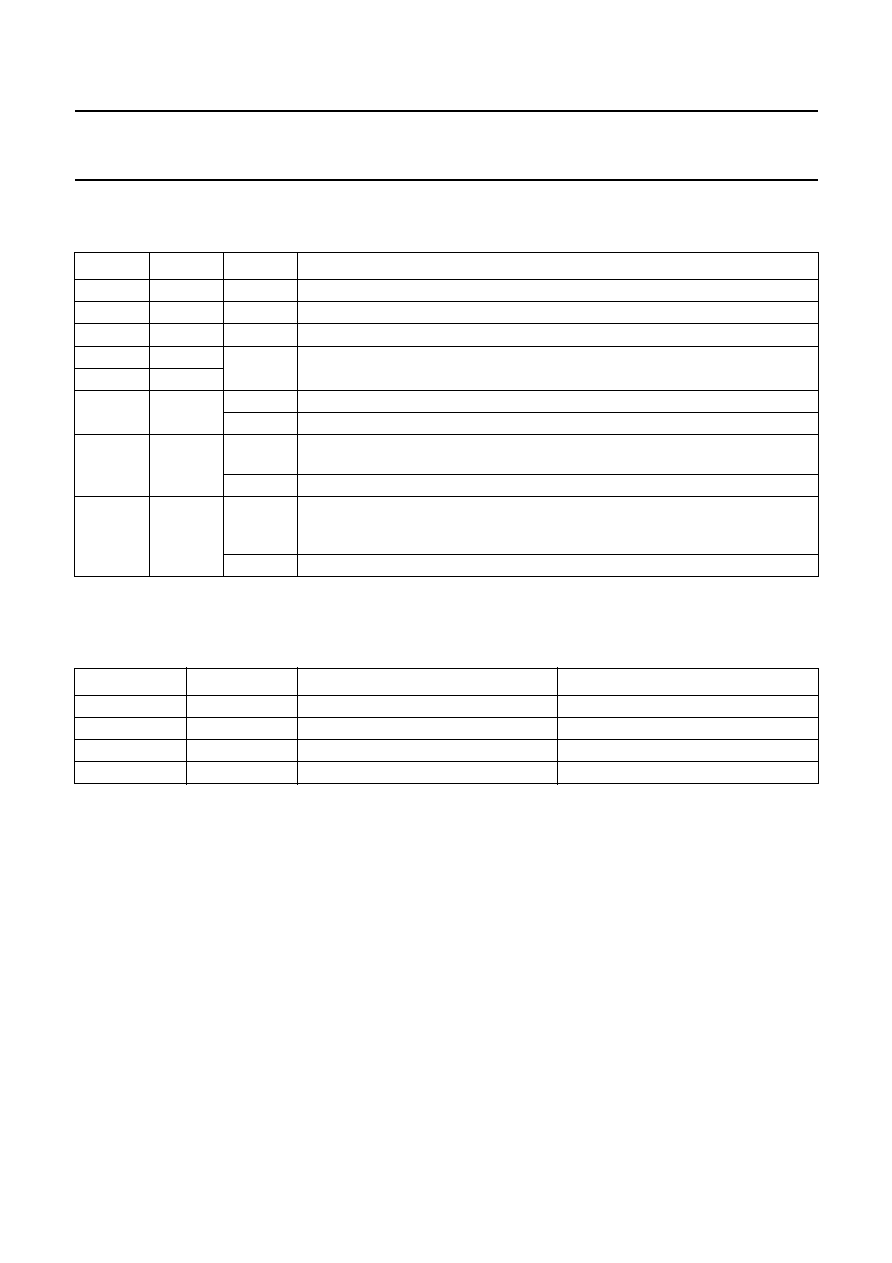
1999 Dec 20
65
Philips Semiconductors
Product specification
Digital TV Sound Processor (DTVSP)
TDA9870A
10.3.31 F
EATURE INTERFACE CONFIGURATION REGISTER
Table 64 Subaddress 36 (note 1)
Note
1. The default setting at power-up is 00000000.
Table 65 System clock frequency selection
Note
1. With 16.384 MHz the duty cycle is 33%.
BIT
NAME
VALUE
DESCRIPTION
7 (MSB)
B7
0
default value
6
B6
0
default value
5
B5
0
default value
4
SYSCL1
-
system clock frequency selection (see Table 65)
3
SYSCL0
2
SYSOUT
1
enables the output of a system (or master) clock signal at pin SYSCLK
0
the output will be off, thereby improving the EMC performance
1
I
2
SFORM
1
an MSB-aligned (MSB-first) serial output format is selected, i.e. a level change at
pin WS indicates the beginning of a new audio sample
0
the standard I
2
S-bus output format is selected
0 (LSB)
I
2
SOUT
1
enables the I
2
S-bus outputs (both serial data outputs plus serial bit clock and word
select) in a format determined by bit I
2
SFORM; the TDA9870A is then an I
2
S-bus
master
0
the outputs mentioned will be 3-stated, thereby improving the EMC performance
B4
B3
SYSCLK OUTPUT
FREQUENCY (MHz)
0
0
256f
s
8.192
0
1
384f
s
12.288
1
0
512f
s
16.384
(1)
1
1
768f
s
24.576
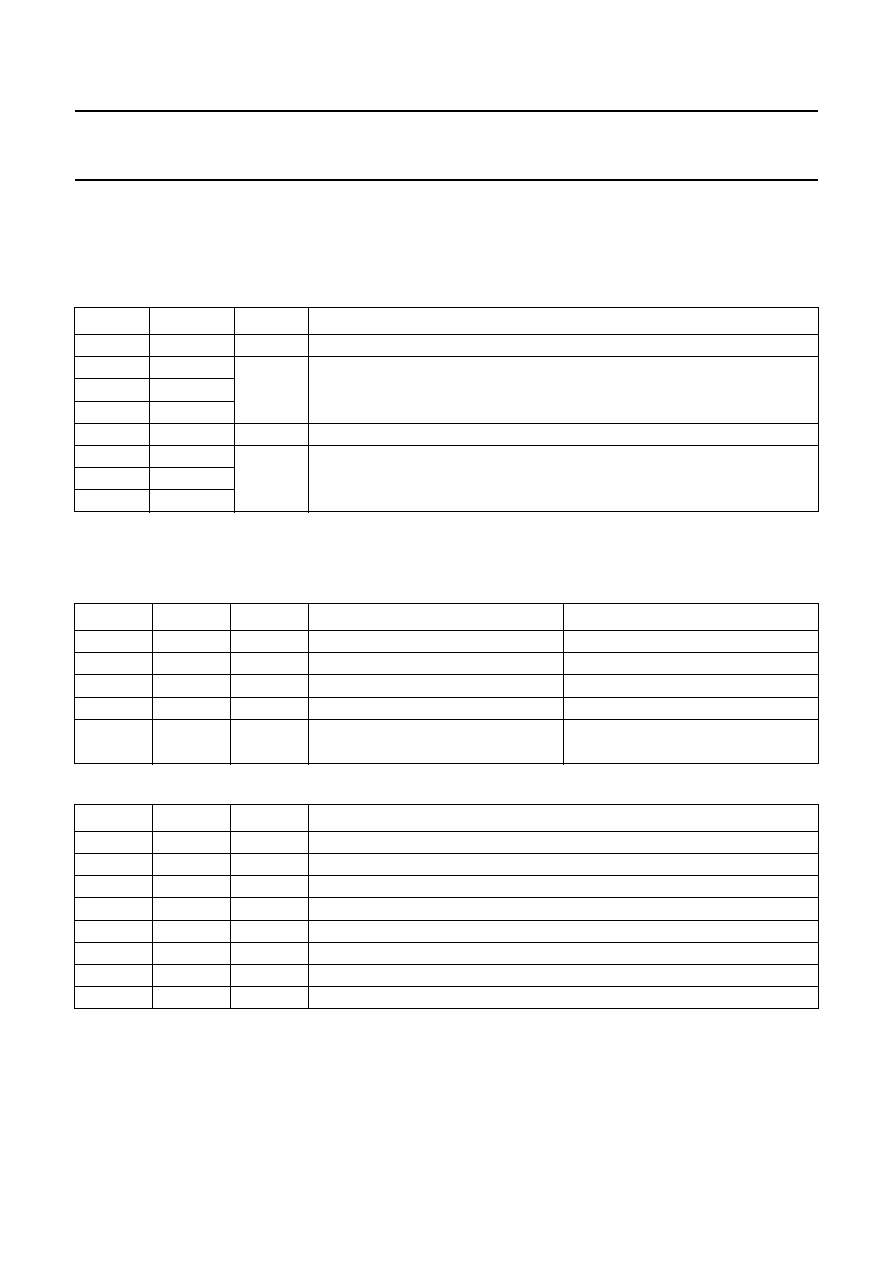
1999 Dec 20
66
Philips Semiconductors
Product specification
Digital TV Sound Processor (DTVSP)
TDA9870A
10.3.32 I
2
S1
OUTPUT SELECT REGISTER
This register is used to define both the signal source to be output at I
2
S1 and the mode of the digital matrix for signal
selection.
Table 66 Subaddress 37 (note 1)
Note
1. The default setting at power-up is 00000000.
Table 67 Output selection
Table 68 Signal source selection (note 1)
Note
1. The Main and Auxiliary channel outputs will not contain the beeper signal.
BIT
NAME
VALUE
DESCRIPTION
7 (MSB)
B7
0
default value
6
B6
-
output selection (see Table 67)
5
B5
4
B4
3
B3
0
default value
2
B2
-
signal source selection (see Table 68)
1
B1
0 (LSB)
B0
B6
B5
B4
L OUTPUT
R OUTPUT
0
0
0
L input
R input
0
0
1
L input
L input
0
1
0
R input
R input
0
1
1
R input
L input
1
0
0
B2
B1
B0
SIGNAL SOURCE
0
0
0
FM output
0
0
1
don't care
0
1
0
I
2
S1 input
0
1
1
I
2
S2 input
1
0
0
ADC output
1
0
1
AVL output
1
1
0
Auxiliary output
1
1
1
Main output
L
R
+
2
--------------
L
R
+
2
--------------
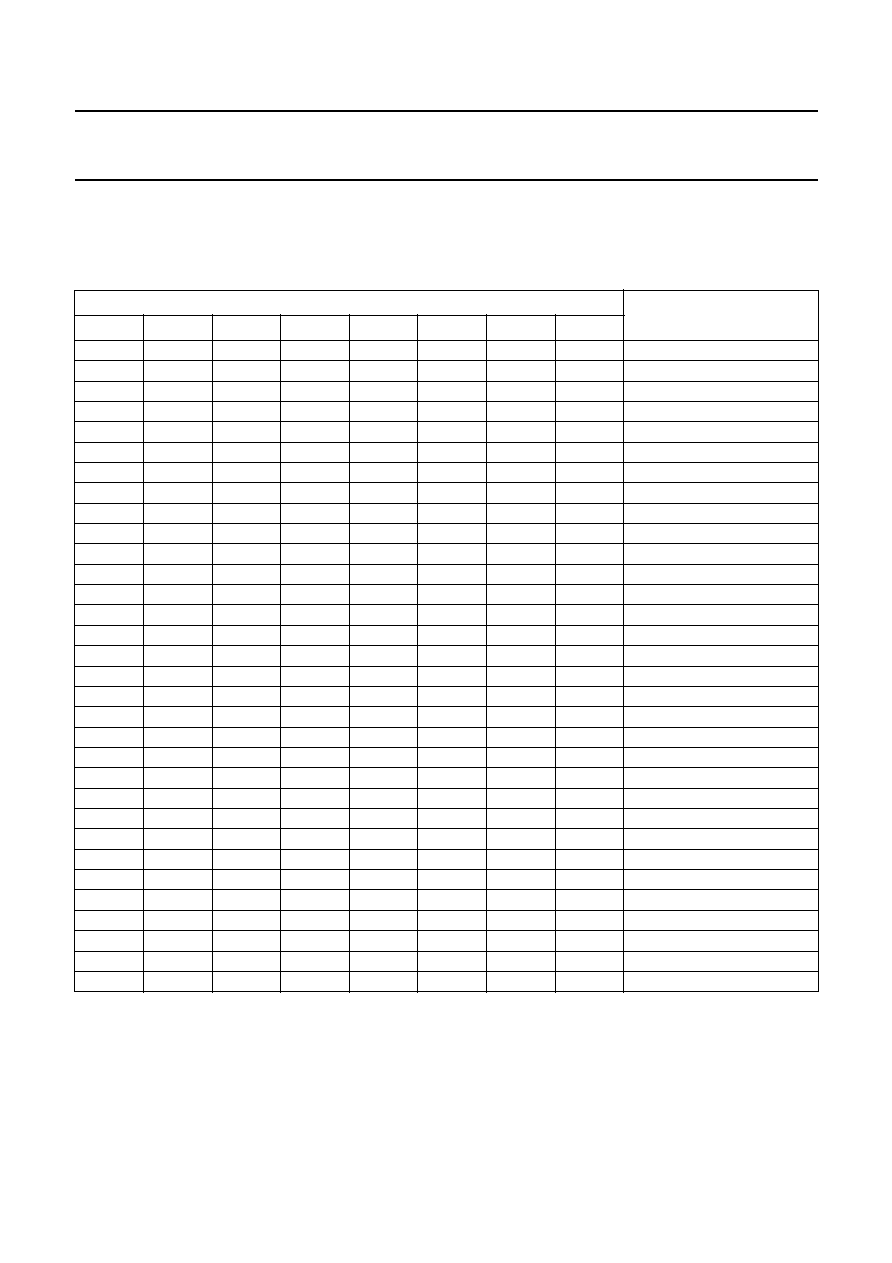
1999 Dec 20
67
Philips Semiconductors
Product specification
Digital TV Sound Processor (DTVSP)
TDA9870A
10.3.33 I
2
S1
INPUT LEVEL ADJUST REGISTER
This register is used to adjust the input level at the I
2
S1 interface. Left and right signal channel are treated identically.
Table 69 Subaddress 38
Note
1. The default setting at power-up is 00000000.
MSB
LSB
GAIN SETTING (dB)
B7
B6
B5
B4
B3
B2
B1
B0
0
0
0
0
1
1
1
1
+15
0
0
0
0
1
1
1
0
+14
0
0
0
0
1
1
0
1
+13
0
0
0
0
1
1
0
0
+12
0
0
0
0
1
0
1
1
+11
0
0
0
0
1
0
1
0
+10
0
0
0
0
1
0
0
1
+9
0
0
0
0
1
0
0
0
+8
0
0
0
0
0
1
1
1
+7
0
0
0
0
0
1
1
0
+6
0
0
0
0
0
1
0
1
+5
0
0
0
0
0
1
0
0
+4
0
0
0
0
0
0
1
1
+3
0
0
0
0
0
0
1
0
+2
0
0
0
0
0
0
0
1
+1
0
0
0
0
0
0
0
0
0 (note 1)
0
0
0
1
1
1
1
1
-
1
0
0
0
1
1
1
1
0
-
2
0
0
0
1
1
1
0
1
-
3
0
0
0
1
1
1
0
0
-
4
0
0
0
1
1
0
1
1
-
5
0
0
0
1
1
0
1
0
-
6
0
0
0
1
1
0
0
1
-
7
0
0
0
1
1
0
0
0
-
8
0
0
0
1
0
1
1
1
-
9
0
0
0
1
0
1
1
0
-
10
0
0
0
1
0
1
0
1
-
11
0
0
0
1
0
1
0
0
-
12
0
0
0
1
0
0
1
1
-
13
0
0
0
1
0
0
1
0
-
14
0
0
0
1
0
0
0
1
-
15
0
0
0
1
0
0
0
0
mute
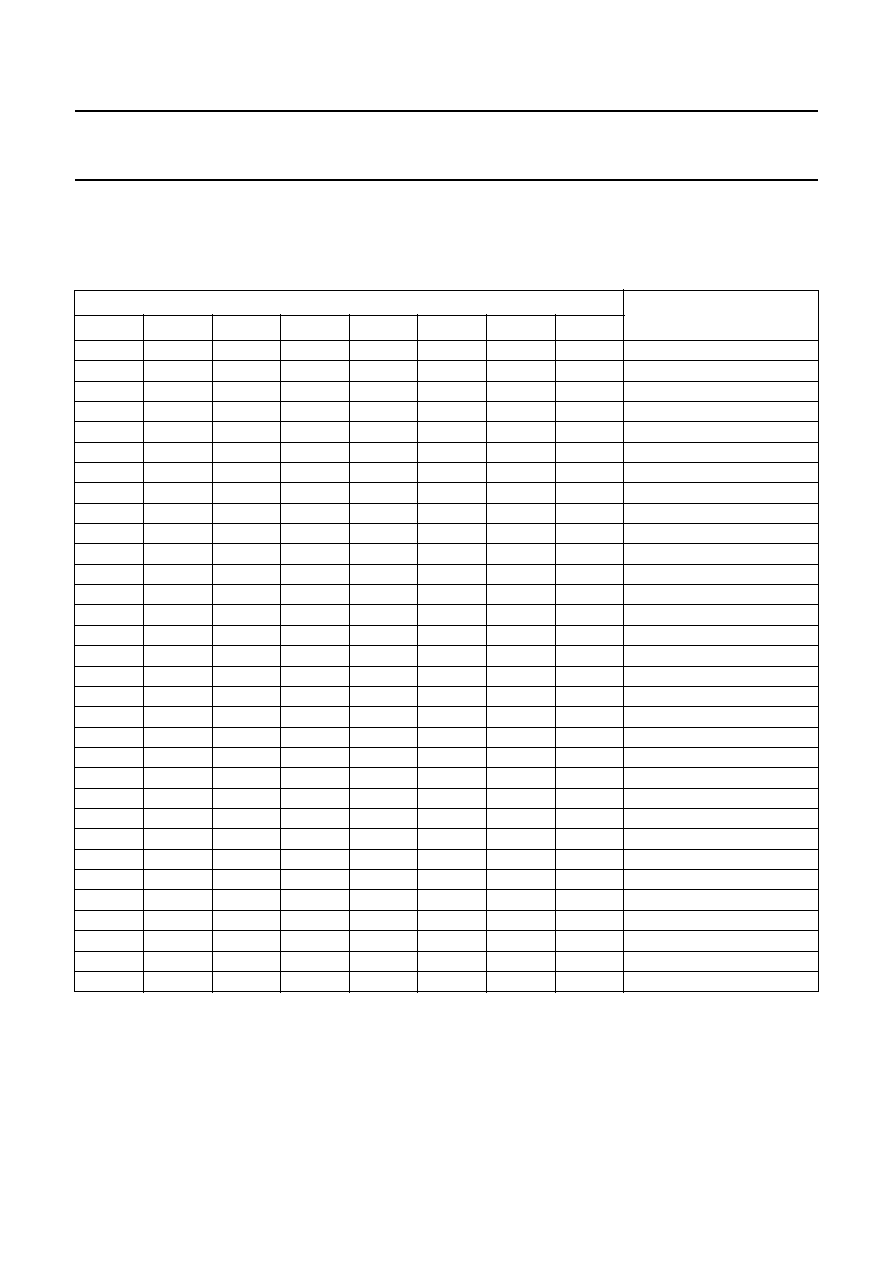
1999 Dec 20
68
Philips Semiconductors
Product specification
Digital TV Sound Processor (DTVSP)
TDA9870A
10.3.34 I
2
S1
OUTPUT LEVEL ADJUST REGISTER
This register is used to adjust the output level at the I
2
S1 interface. Left and right signal channel are treated identically.
Table 70 Subaddress 39
Note
1. The default setting at power-up is 00000000.
MSB
LSB
GAIN SETTING (dB)
B7
B6
B5
B4
B3
B2
B1
B0
0
0
0
0
1
1
1
1
+15
0
0
0
0
1
1
1
0
+14
0
0
0
0
1
1
0
1
+13
0
0
0
0
1
1
0
0
+12
0
0
0
0
1
0
1
1
+11
0
0
0
0
1
0
1
0
+10
0
0
0
0
1
0
0
1
+9
0
0
0
0
1
0
0
0
+8
0
0
0
0
0
1
1
1
+7
0
0
0
0
0
1
1
0
+6
0
0
0
0
0
1
0
1
+5
0
0
0
0
0
1
0
0
+4
0
0
0
0
0
0
1
1
+3
0
0
0
0
0
0
1
0
+2
0
0
0
0
0
0
0
1
+1
0
0
0
0
0
0
0
0
0 (note 1)
0
0
0
1
1
1
1
1
-
1
0
0
0
1
1
1
1
0
-
2
0
0
0
1
1
1
0
1
-
3
0
0
0
1
1
1
0
0
-
4
0
0
0
1
1
0
1
1
-
5
0
0
0
1
1
0
1
0
-
6
0
0
0
1
1
0
0
1
-
7
0
0
0
1
1
0
0
0
-
8
0
0
0
1
0
1
1
1
-
9
0
0
0
1
0
1
1
0
-
10
0
0
0
1
0
1
0
1
-
11
0
0
0
1
0
1
0
0
-
12
0
0
0
1
0
0
1
1
-
13
0
0
0
1
0
0
1
0
-
14
0
0
0
1
0
0
0
1
-
15
0
0
0
1
0
0
0
0
mute
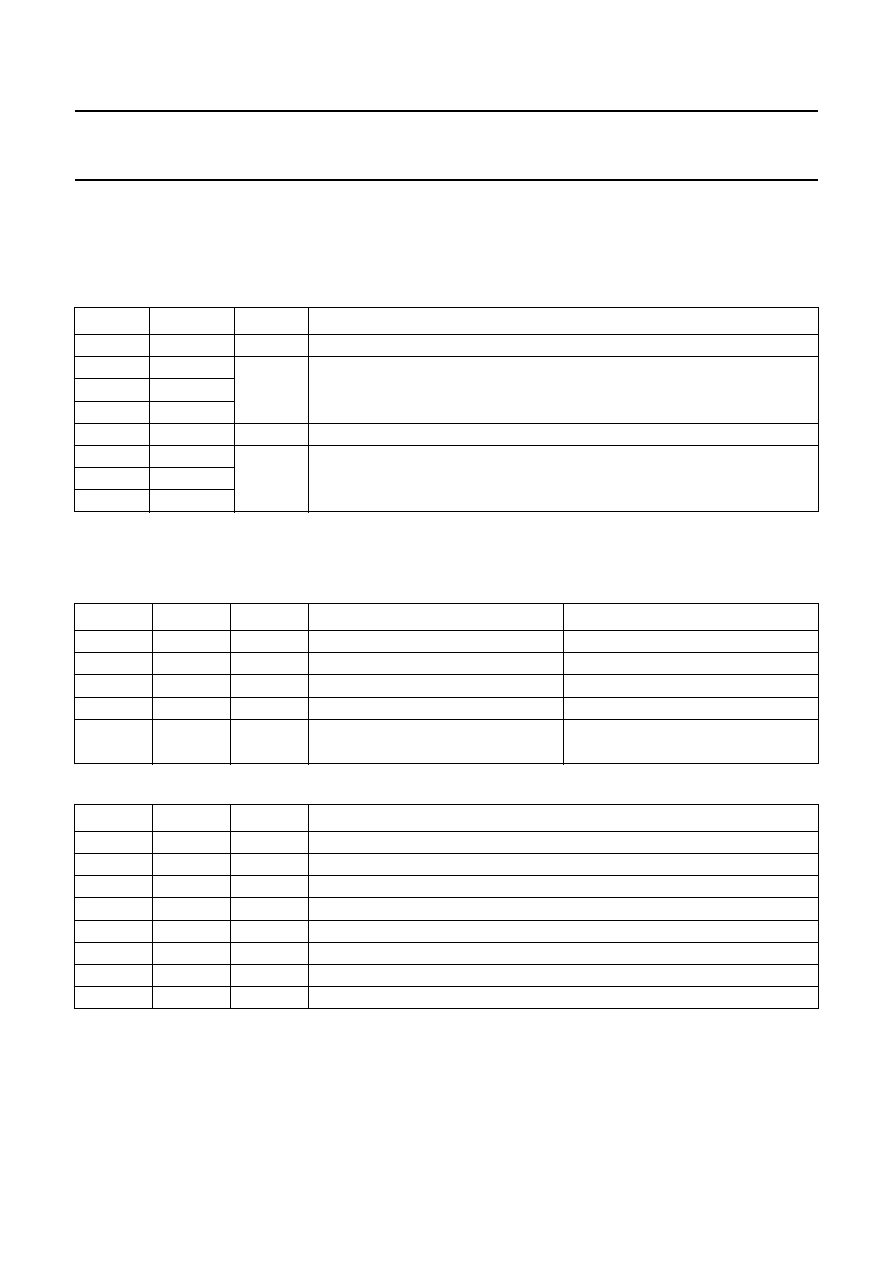
1999 Dec 20
69
Philips Semiconductors
Product specification
Digital TV Sound Processor (DTVSP)
TDA9870A
10.3.35 I
2
S2
OUTPUT SELECT REGISTER
This register is used to define both the signal source to be output at I
2
S2 and the mode of the digital matrix for signal
selection.
Table 71 Subaddress 40 (note 1)
Note
1. The default setting at power-up is 00000000.
Table 72 Output selection
Table 73 Signal source selection (note 1)
Note
1. The Main and Auxiliary channel outputs will not contain the beeper signal.
BIT
NAME
VALUE
DESCRIPTION
7 (MSB)
B7
0
default value
6
B6
-
output selection (see Table 72)
5
B5
4
B4
3
B3
0
default value
2
B2
-
signal source selection (see Table 73)
1
B1
0 (LSB)
B0
B6
B5
B4
L OUTPUT
R OUTPUT
0
0
0
L input
R input
0
0
1
L input
L input
0
1
0
R input
R input
0
1
1
R input
L input
1
0
0
B2
B1
B0
SIGNAL SOURCE
0
0
0
FM output
0
0
1
don't care
0
1
0
I
2
S1 input
0
1
1
I
2
S2 input
1
0
0
ADC output
1
0
1
AVL output
1
1
0
Auxiliary output
1
1
1
Main output
L
R
+
2
--------------
L
R
+
2
--------------
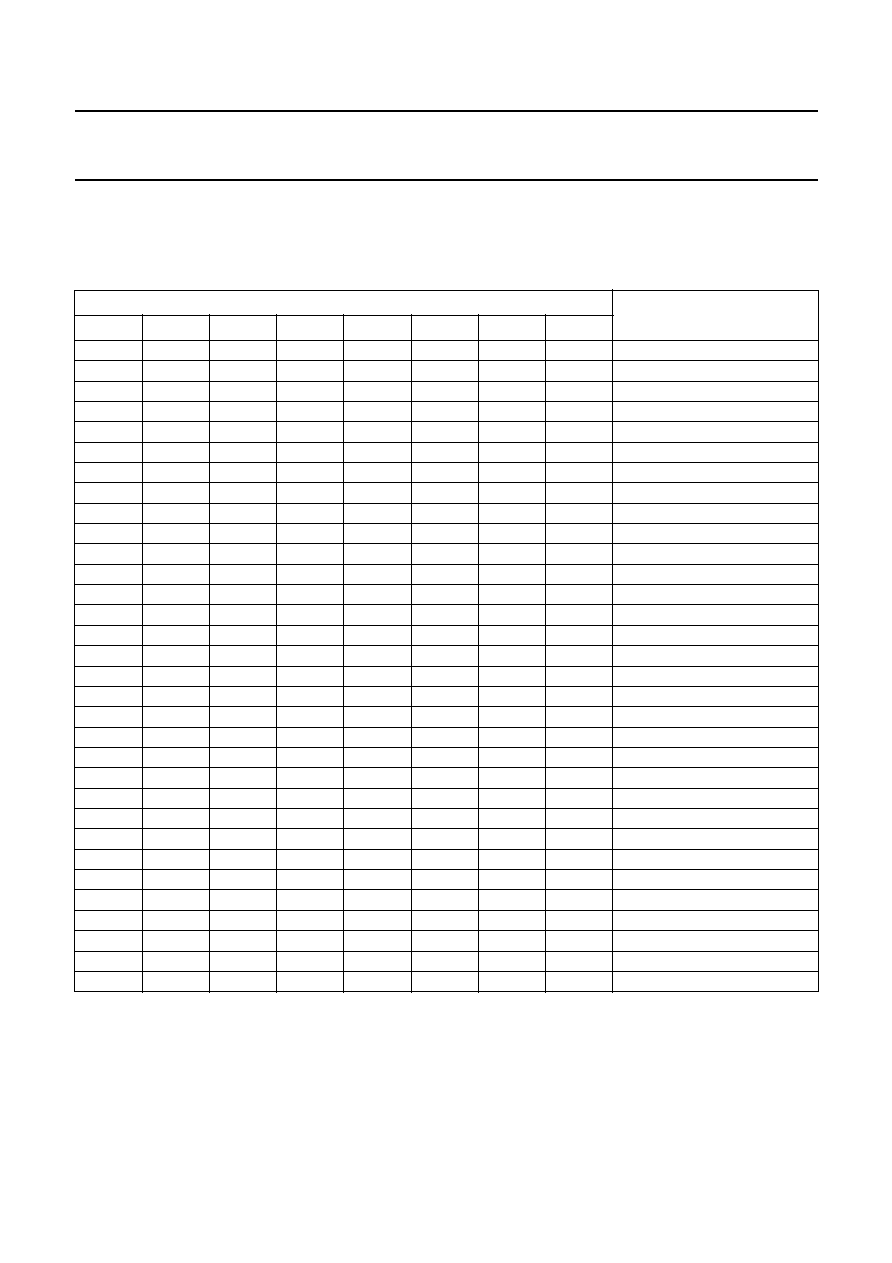
1999 Dec 20
70
Philips Semiconductors
Product specification
Digital TV Sound Processor (DTVSP)
TDA9870A
10.3.36 I
2
S2
INPUT LEVEL ADJUST REGISTER
This register is used to adjust the input level at the I
2
S2 interface. Left and right signal channel are treated identically.
Table 74 Subaddress 41
Note
1. The default setting at power-up is 00000000.
MSB
LSB
GAIN SETTING (dB)
B7
B6
B5
B4
B3
B2
B1
B0
0
0
0
0
1
1
1
1
+15
0
0
0
0
1
1
1
0
+14
0
0
0
0
1
1
0
1
+13
0
0
0
0
1
1
0
0
+12
0
0
0
0
1
0
1
1
+11
0
0
0
0
1
0
1
0
+10
0
0
0
0
1
0
0
1
+9
0
0
0
0
1
0
0
0
+8
0
0
0
0
0
1
1
1
+7
0
0
0
0
0
1
1
0
+6
0
0
0
0
0
1
0
1
+5
0
0
0
0
0
1
0
0
+4
0
0
0
0
0
0
1
1
+3
0
0
0
0
0
0
1
0
+2
0
0
0
0
0
0
0
1
+1
0
0
0
0
0
0
0
0
0 (note 1)
0
0
0
1
1
1
1
1
-
1
0
0
0
1
1
1
1
0
-
2
0
0
0
1
1
1
0
1
-
3
0
0
0
1
1
1
0
0
-
4
0
0
0
1
1
0
1
1
-
5
0
0
0
1
1
0
1
0
-
6
0
0
0
1
1
0
0
1
-
7
0
0
0
1
1
0
0
0
-
8
0
0
0
1
0
1
1
1
-
9
0
0
0
1
0
1
1
0
-
10
0
0
0
1
0
1
0
1
-
11
0
0
0
1
0
1
0
0
-
12
0
0
0
1
0
0
1
1
-
13
0
0
0
1
0
0
1
0
-
14
0
0
0
1
0
0
0
1
-
15
0
0
0
1
0
0
0
0
mute
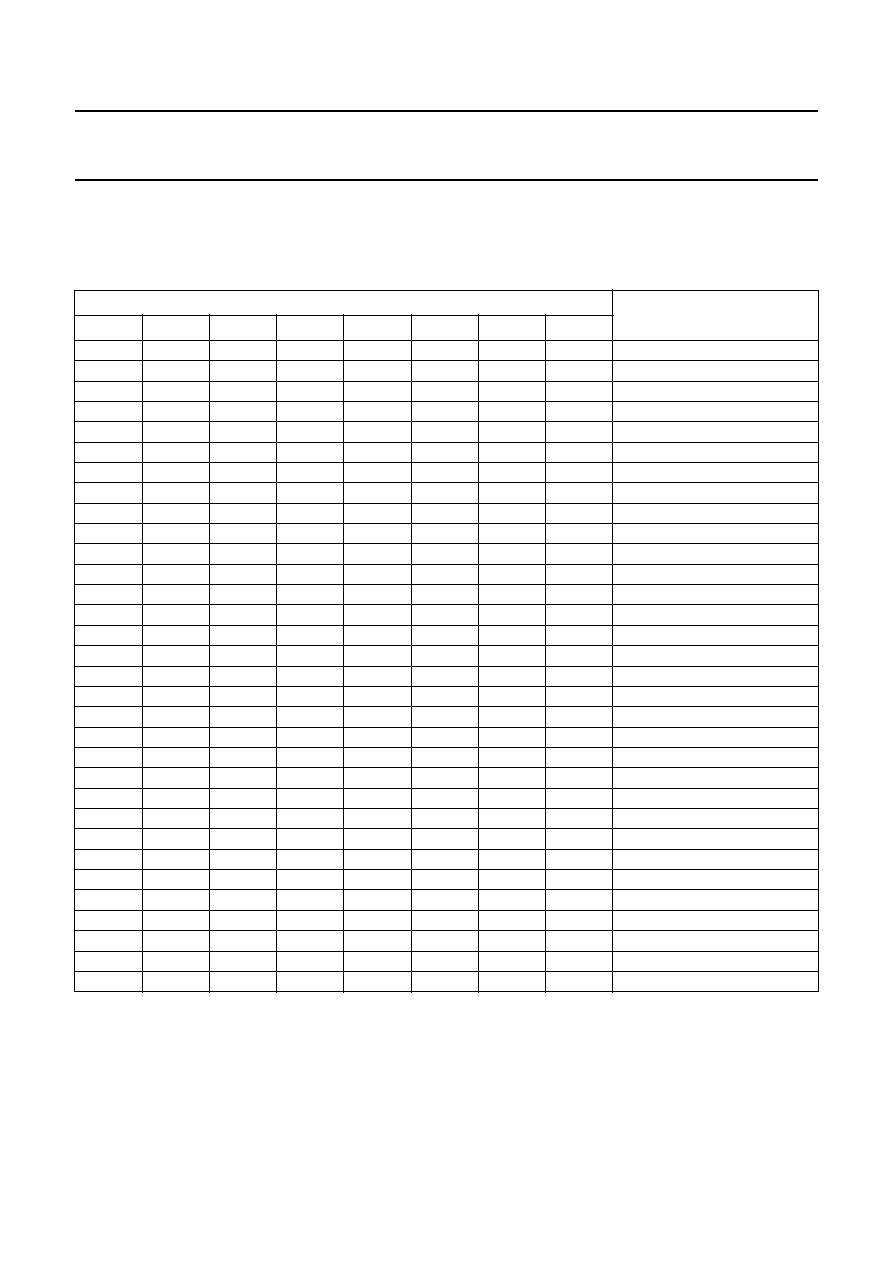
1999 Dec 20
71
Philips Semiconductors
Product specification
Digital TV Sound Processor (DTVSP)
TDA9870A
10.3.37 I
2
S2
OUTPUT LEVEL ADJUST REGISTER
This register is used to adjust the output level at the I
2
S2 interface. Left and right signal channel are treated identically.
Table 75 Subaddress 42
Note
1. The default setting at power-up is 00000000.
MSB
LSB
GAIN SETTING (dB)
B7
B6
B5
B4
B3
B2
B1
B0
0
0
0
0
1
1
1
1
+15
0
0
0
0
1
1
1
0
+14
0
0
0
0
1
1
0
1
+13
0
0
0
0
1
1
0
0
+12
0
0
0
0
1
0
1
1
+11
0
0
0
0
1
0
1
0
+10
0
0
0
0
1
0
0
1
+9
0
0
0
0
1
0
0
0
+8
0
0
0
0
0
1
1
1
+7
0
0
0
0
0
1
1
0
+6
0
0
0
0
0
1
0
1
+5
0
0
0
0
0
1
0
0
+4
0
0
0
0
0
0
1
1
+3
0
0
0
0
0
0
1
0
+2
0
0
0
0
0
0
0
1
+1
0
0
0
0
0
0
0
0
0 (note 1)
0
0
0
1
1
1
1
1
-
1
0
0
0
1
1
1
1
0
-
2
0
0
0
1
1
1
0
1
-
3
0
0
0
1
1
1
0
0
-
4
0
0
0
1
1
0
1
1
-
5
0
0
0
1
1
0
1
0
-
6
0
0
0
1
1
0
0
1
-
7
0
0
0
1
1
0
0
0
-
8
0
0
0
1
0
1
1
1
-
9
0
0
0
1
0
1
1
0
-
10
0
0
0
1
0
1
0
1
-
11
0
0
0
1
0
1
0
0
-
12
0
0
0
1
0
0
1
1
-
13
0
0
0
1
0
0
1
0
-
14
0
0
0
1
0
0
0
1
-
15
0
0
0
1
0
0
0
0
mute

1999 Dec 20
72
Philips Semiconductors
Product specification
Digital TV Sound Processor (DTVSP)
TDA9870A
10.3.38 B
EEPER FREQUENCY CONTROL REGISTER
This register is used to select from sample beeper oscillator frequencies. The beeper output signal is added to the Main
and Auxiliary channel output DAC.
Due to the frequency response of the audio DACs upsampling filters, the 25 kHz beep is approximately 5 dB louder than
the 390 Hz beep.
Table 76 Subaddress 43 (note 1)
Note
1. The default setting at power-up is 00000000.
10.3.39 B
EEPER VOLUME CONTROL REGISTER
This register is used to set the beeper volume. The gain setting is relative to digital full-scale at the input to the Main and
Auxiliary channel output DACs. The beeper volume is independent of any other volume setting.
The beeper signal is added to the Main and Auxiliary channel output signals in the 2
◊
f
s
domain. The beeper volume
should be set with great care, when the audio signals in the Main and Auxiliary channels are close to digital full-scale, to
avoid output signal distortion due to overload.
MSB
LSB
GENERATED FREQUENCY (Hz)
B7
B6
B5
B4
B3
B2
B1
B0
0
0
0
0
0
1
1
1
25000
0
0
0
0
0
1
1
0
7040
0
0
0
0
0
1
0
1
3580
0
0
0
0
0
1
0
0
1770
0
0
0
0
0
0
1
1
1270
0
0
0
0
0
0
1
0
900
0
0
0
0
0
0
0
1
640
0
0
0
0
0
0
0
0
390

1999 Dec 20
73
Philips Semiconductors
Product specification
Digital TV Sound Processor (DTVSP)
TDA9870A
Table 77 Subaddress 44
Note
1. The default setting at power-up is 00100000.
MSB
LSB
GAIN SETTING (dB)
B7
B6
B5
B4
B3
B2
B1
B0
0
0
0
0
0
0
0
0
0
0
0
1
1
1
1
1
1
-
3
0
0
1
1
1
1
1
0
-
6
0
0
1
1
1
1
0
1
-
9
0
0
1
1
1
1
0
0
-
12
0
0
1
1
1
0
1
1
-
15
0
0
1
1
1
0
1
0
-
18
0
0
1
1
1
0
0
1
-
21
0
0
1
1
1
0
0
0
-
24
0
0
1
1
0
1
1
1
-
27
0
0
1
1
0
1
1
0
-
30
0
0
1
1
0
1
0
1
-
33
0
0
1
1
0
1
0
0
-
36
0
0
1
1
0
0
1
1
-
39
0
0
1
1
0
0
1
0
-
42
0
0
1
1
0
0
0
1
-
45
0
0
1
1
0
0
0
0
-
48
0
0
1
0
1
1
1
1
-
51
0
0
1
0
1
1
1
0
-
54
0
0
1
0
1
1
0
1
-
57
0
0
1
0
1
1
0
0
-
60
0
0
1
0
1
0
1
1
-
63
0
0
1
0
1
0
1
0
-
66
0
0
1
0
1
0
0
1
-
69
0
0
1
0
1
0
0
0
-
72
0
0
1
0
0
1
1
1
-
75
0
0
1
0
0
1
1
0
-
78
0
0
1
0
0
1
0
1
-
81
0
0
1
0
0
1
0
0
-
84
0
0
1
0
0
0
1
1
-
87
0
0
1
0
0
0
1
0
-
90
0
0
1
0
0
0
0
1
-
93
0
0
1
0
0
0
0
0
mute (note 1)
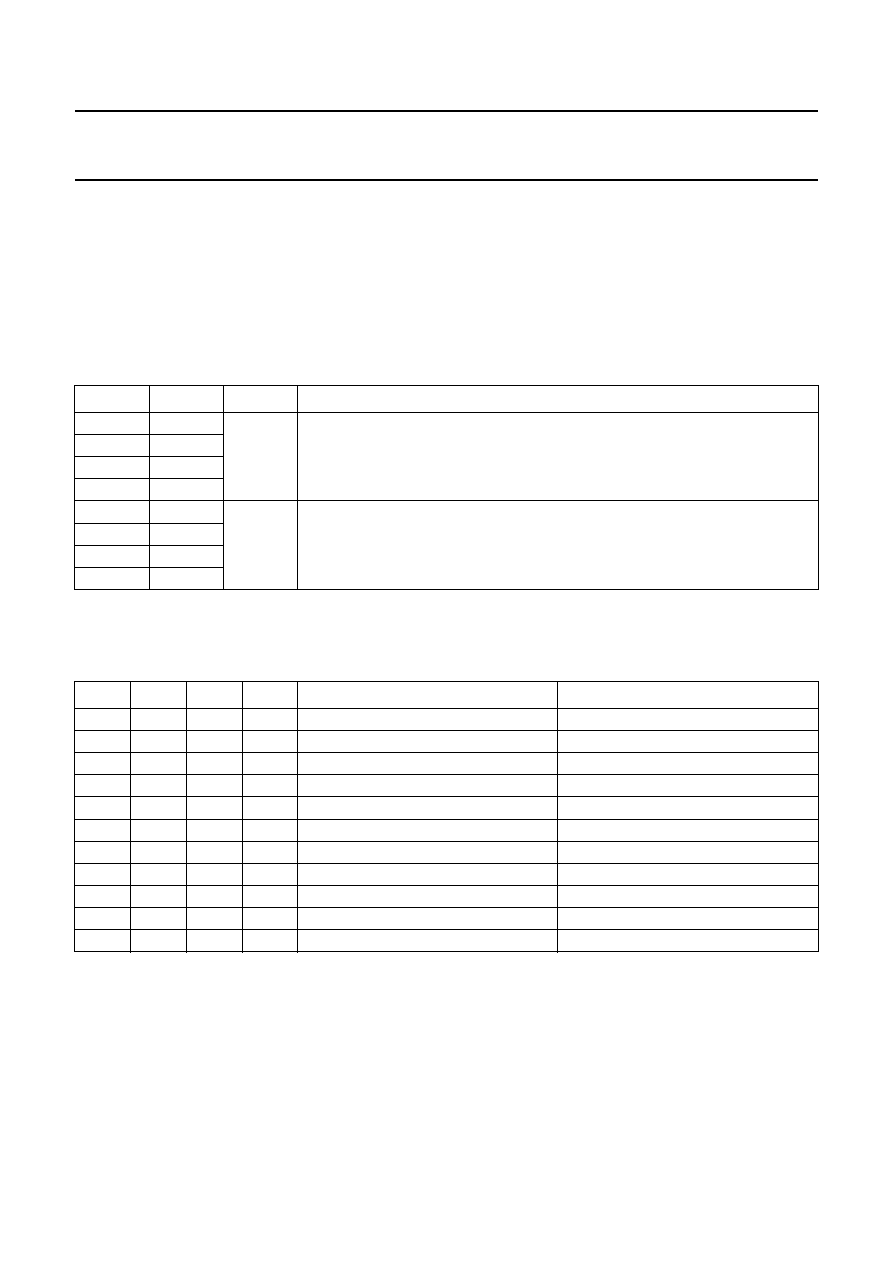
1999 Dec 20
74
Philips Semiconductors
Product specification
Digital TV Sound Processor (DTVSP)
TDA9870A
10.3.40 B
ASS BOOST CONTROL REGISTER
This register is used to select from a few sample bass boost settings to modify the frequency characteristics of the Main
channel (shelving filter). Bits B3 to B0 apply to the left channel, bits B7 to B4 apply to the right channel. This function
must be used with care in order to avoid clipping distortion at high volume settings.
More sophisticated control of the bass boost filter can be exercised in the expert mode (see Section 10.5). The user then
has full control over this second-order filter and can, within limits, realize bass equalizers with arbitrary centre
frequencies, Q factors and boost/cut settings.
Table 78 Subaddress 45 (note 1)
Note
1. The default setting at power-up is 00000000.
Table 79 Gain setting of right channel
BIT
NAME
VALUE
DESCRIPTION
7 (MSB)
B7
-
gain setting of right channel (see Table 79)
6
B6
5
B5
4
B4
3
B3
-
gain setting of left channel (see Table 80)
2
B2
1
B1
0 (LSB)
B0
B7
B6
B5
B4
GAIN SETTING (dB)
CORNER FREQUENCY (Hz)
1
0
1
0
20
350
1
0
0
1
18
350
1
0
0
0
16
350
0
1
1
1
14
350
0
1
1
0
12
350
0
1
0
1
10
350
0
1
0
0
8
350
0
0
1
1
6
350
0
0
1
0
4
350
0
0
0
1
2
350
0
0
0
0
0
350
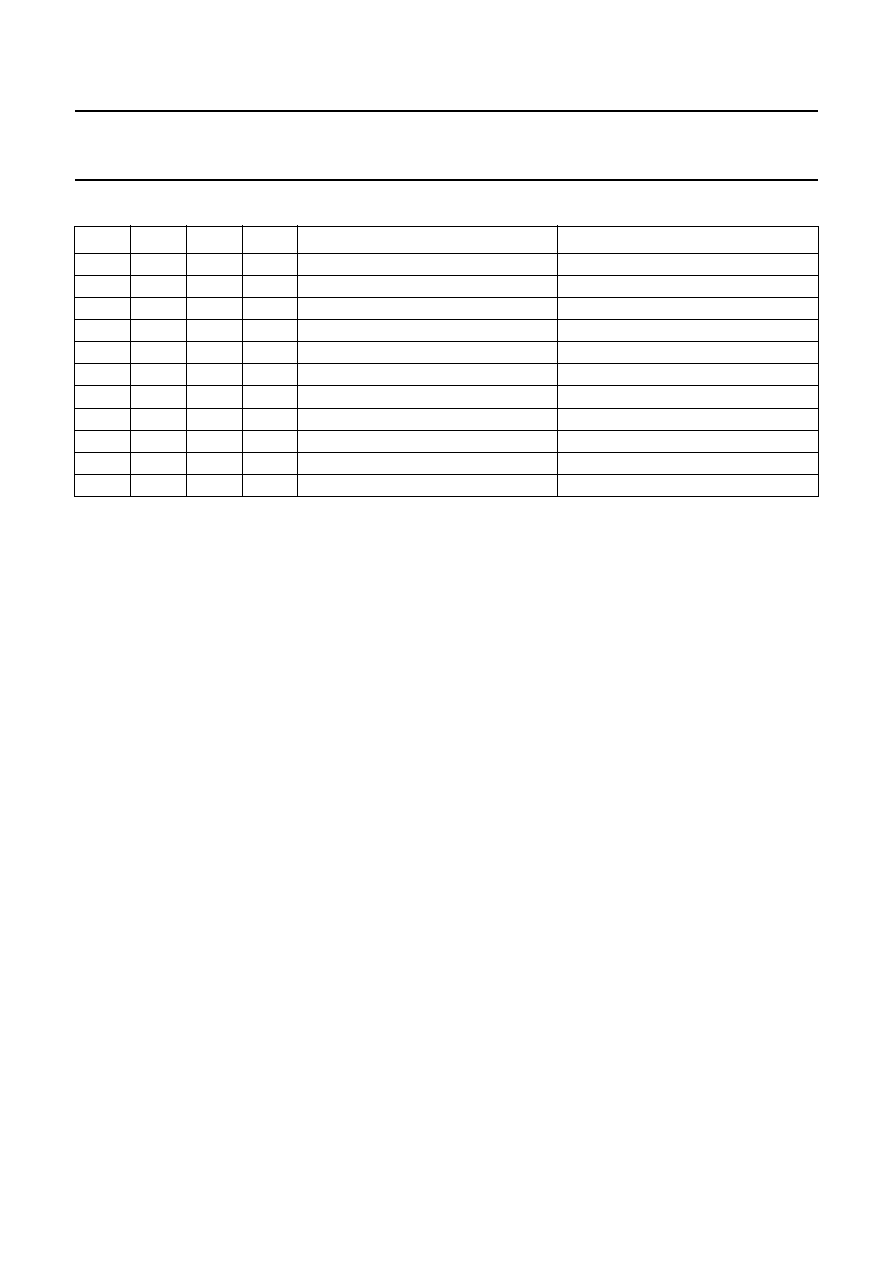
1999 Dec 20
75
Philips Semiconductors
Product specification
Digital TV Sound Processor (DTVSP)
TDA9870A
Table 80 Gain setting of left channel
B3
B2
B1
B0
GAIN SETTING (dB)
CORNER FREQUENCY (Hz)
1
0
1
0
20
350
1
0
0
1
18
350
1
0
0
0
16
350
0
1
1
1
14
350
0
1
1
0
12
350
0
1
0
1
10
350
0
1
0
0
8
350
0
0
1
1
6
350
0
0
1
0
4
350
0
0
0
1
2
350
0
0
0
0
0
350
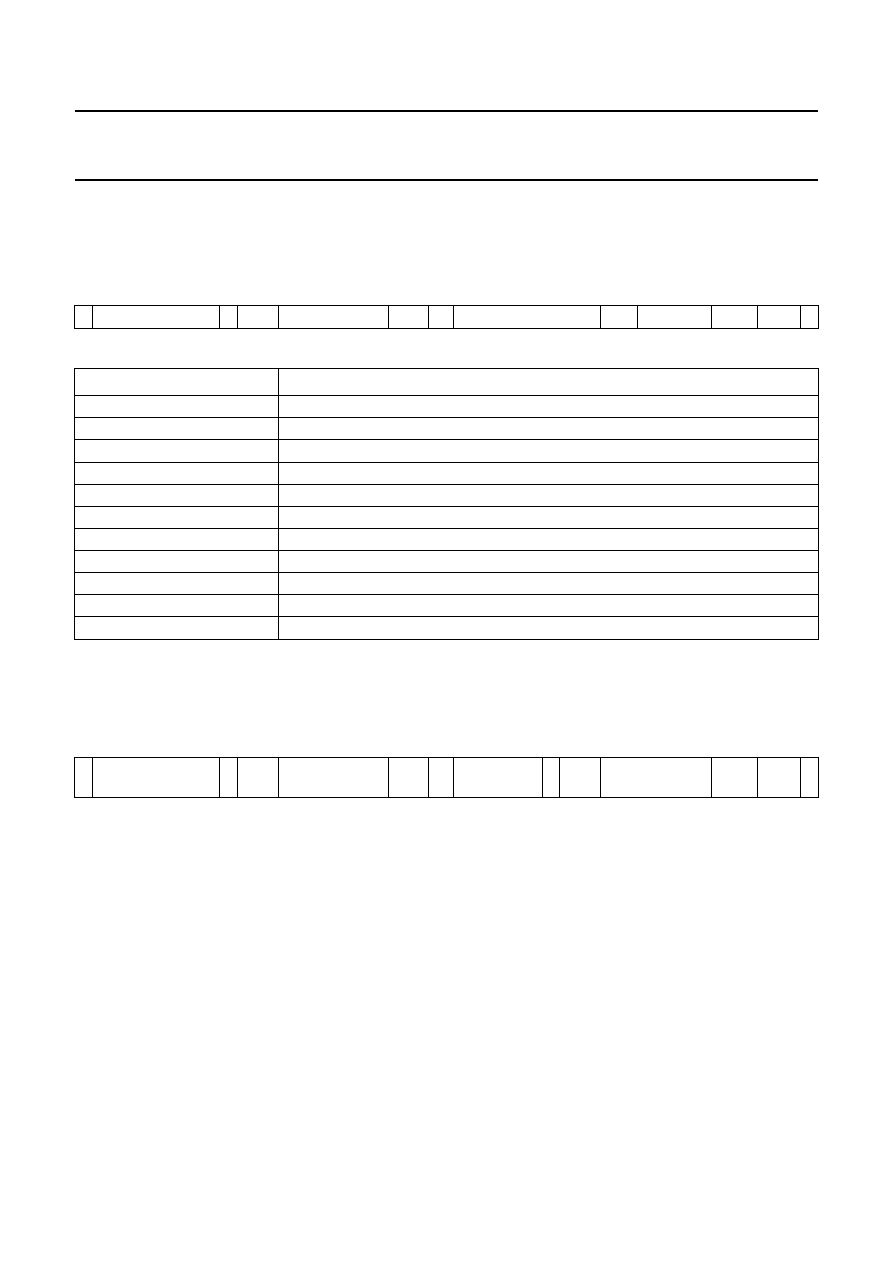
1999 Dec 20
76
Philips Semiconductors
Product specification
Digital TV Sound Processor (DTVSP)
TDA9870A
10.4
Slave transmitter mode
As a slave transmitter, the TDA9870A provides 13 registers with status information and data, a part of which is for Philips
internal purposes only. These registers can be accessed by means of subaddresses.
Table 81 General format for reading data from the TDA9870A
Table 82 Explanation of Tables 81 and 83
Reading of data can start at any valid subaddress. It is allowed to read more than 1 data byte per transmission from the
TDA9870A. In this situation, the subaddress is automatically incremented after each data byte, which results in reading
the sequence of data bytes from successive register locations, starting at SUBADDRESS.
Table 83 Format of a transmission using automatic incrementing of subaddresses
Note
1. n data bytes with auto-increment of subaddresses.
Each data byte in a read sequence, except for the last one, is acknowledged with Am (acknowledge by the master).
The subaddresses `wrap around' from decimal 255 to 0. If an attempt is made to read from a non-existing subaddress,
the device will send a data pattern of all ones, i.e. FF in hexadecimal notation.
S SLAVE ADDRESS 0 ACK SUBADDRESS ACK Sr
SLAVE ADDRESS
1
ACK
DATA NAm P
BIT
FUNCTION
S
START condition
SLAVE ADDRESS
7-bit device address
0
data direction bit (write to device)
ACK
acknowledge (by the slave)
SUBADDRESS
address of register to read from
Sr
repeated START condition
1
data direction bit (read from device)
DATA
data byte read from register
NAm
not acknowledge (by the master)
Am
acknowledge (by the master)
P
STOP condition
S SLAVE ADDRESS 0 ACK SUBADDRESS ACK Sr
SLAVE
ADDRESS
1 ACK
DATA BYTE
Am
(1)
DATA NAm P

1999 Dec 20
77
Philips Semiconductors
Product specification
Digital TV Sound Processor (DTVSP)
TDA9870A
Table 84 Overview of the slave transmitter registers; note 1
Notes
1. X indicates a bit that has not been assigned to a function. This bit is reserved for future extensions.
2. Registers from subaddress 251 to 255 are for Philips internal purposes only. They are considered as a set of
registers for the identification of individual members and some key parameters in a family of devices.
The following sub-sections provide a detailed description of the slave transmitter registers.
SUBADDRESS
(DECIMAL)
DATA
FUNCTION
MSB
LSB
0
s
s
X
X
X
s
s
s
device status (power-on, identification, etc.)
1
X
X
X
X
X
X
X
X
don't care; note 1
2
X
X
X
X
X
X
X
X
don't care; note 1
3
X
X
X
X
X
X
X
X
don't care; note 1
4
X
X
X
X
X
X
X
X
don't care; note 1
5
l
l
l
l
l
l
l
l
level read-out (MSB)
6
l
l
l
l
l
l
l
l
level read-out (LSB)
7
X
X
X
c
c
c
c
c
SIF level
251
a
a
a
a
a
a
a
a
test register 3; note 2
252
a
a
a
a
a
a
a
a
test register 2; note 2
253
a
a
a
a
a
a
a
a
test register 1; note 2
254
d
d
d
d
d
d
d
d
device identification code
255
s
s
s
s
s
s
s
s
software identification code
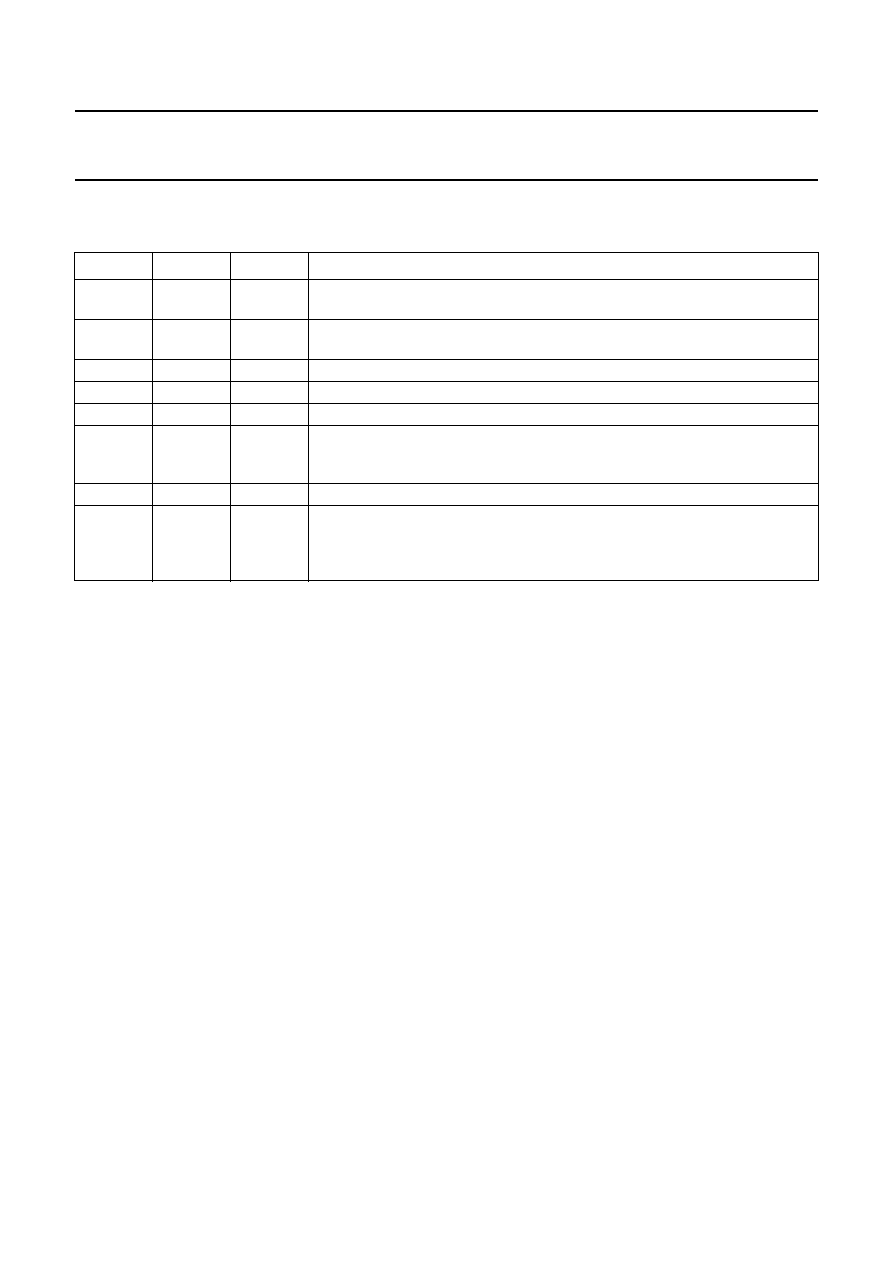
1999 Dec 20
78
Philips Semiconductors
Product specification
Digital TV Sound Processor (DTVSP)
TDA9870A
10.4.1
D
EVICE STATUS REGISTER
Table 85 Subaddress 0
10.4.2
R
EGISTER
1
Subaddress 1: These bits have not been assigned to a function. These bits are reserved for future extensions.
10.4.3
R
EGISTER
2
Subaddress 2: These bits have not been assigned to a function. These bits are reserved for future extensions.
10.4.4
R
EGISTER
3
Subaddress 3: These bits have not been assigned to a function. These bits are reserved for future extensions.
10.4.5
R
EGISTER
4
Subaddress 4: These bits have not been assigned to a function. These bits are reserved for future extensions.
BIT
NAME
VALUE
DESCRIPTION
7 (MSB)
P2IN
-
This bit reflects the status of the corresponding general purpose port of pin P2
(see Section 10.3.2).
6
P1IN
-
This bit reflects the status of the corresponding general purpose port of pin P1
(see Section 10.3.2).
5
B5
-
don't care
4
B4
-
don't care
3
B3
-
don't care
2
IDDUA
-
This bit is logic 1 if an FM dual-language signal has been identified. When
neither IDSTE nor IDDUA are set, the received signal has to be assumed to be
FM mono.
1
IDSTE
-
This bit is logic 1 if an FM stereo signal has been identified.
0 (LSB)
POR
-
Power fail bit: the power supply for the digital part of the device, V
DDD2
, has
temporarily been lower than the specified lower limit. If this is detected an
initialization of the TDA9870A has to be carried out to ensure a reliable
operation.

1999 Dec 20
79
Philips Semiconductors
Product specification
Digital TV Sound Processor (DTVSP)
TDA9870A
10.4.6
L
EVEL READ
-
OUT REGISTERS
These two bytes constitute a word that provides data from
a location that has been specified with the monitor select
register. The most significant byte of the data is stored at
subaddress 5.
If peak-level monitoring has been selected, the peak-level
monitoring register is cleared and monitoring resumes
after its contents has been transferred to these two bytes.
Table 86 Subaddresses 5 and 6
10.4.7
SIF
LEVEL REGISTER
When the SIF AGC is on, bits B4 to B0 of this register
contain a number that gives an indication of the SIF input
level. That number corresponds to the AGC gain register
setting (see Section 10.3.1).
When the SIF AGC is off, this register returns the contents
of the AGC gain register.
Table 87 Subaddress 7
10.4.8
T
EST REGISTER
3
This register contains, as a binary number, the highest
memory address used for the Coefficient RAM (CRAM,
expert mode).
Table 88 Subaddress 251
10.4.9
T
EST REGISTER
2
This register contains, as a binary number, the highest
subaddress used for slave receiver registers.
Table 89 Subaddress 252
SUB-
ADDRESS
BIT
DESCRIPTION
5
7 (MSB) most significant bit or sign bit
6
5
4
3
2
1
0 (LSB)
6
7 (MSB)
6
5
4
3
2
1
0 (LSB)
least significant bit
BIT
NAME
VALUE
DESCRIPTION
7 (MSB)
B7
X
bit not assigned
6
B6
X
bit not assigned
5
B5
X
bit not assigned
4
B4
-
indication of SIF
input level
3
B3
2
B2
1
B1
0 (LSB)
B0
MSB
LSB
B7
B6
B5
B4
B3
B2
B1
B0
0
1
1
1
1
1
1
1
MSB
LSB
B7
B6
B5
B4
B3
B2
B1
B0
0
0
1
0
1
1
0
1

1999 Dec 20
80
Philips Semiconductors
Product specification
Digital TV Sound Processor (DTVSP)
TDA9870A
10.4.10 T
EST REGISTER
1
This register contains, as a binary number, the highest
subaddress used for slave transmitter (status) registers.
Table 90 Subaddress 253
10.4.11 D
EVICE IDENTIFICATION CODE
There will be several devices in the digital TV sound
processor family. This byte is used to identify the individual
family members.
Table 91 Subaddress 254
10.4.12 S
OFTWARE IDENTIFICATION CODE
It is likely that during the life time of this family of devices
several versions of the DSP software will be made, e.g., to
accommodate new application concepts, respond to
customer wishes, etc. This byte is used to identify the
different releases.
Table 92 Subaddress 255
10.5
Expert mode
In addition to the slave receiver and slave transmitter
modes previously described, there is a special `expert'
mode that gives direct write access to the internal CRAM
of the DSP.
In this mode, transferred data contains 12-bit coefficients.
As these coefficients bypass on-chip coefficient look-up
tables for many functions, they directly influence the
processing of signals within the DSP.
This mode must be used with great care. It can be used to
create user-defined characteristics, such as a tone control
with different corner frequencies or special boost/cut
characteristics to correct the low-frequency loudspeaker
and/or cabinet frequency responses.
As the coefficients do not fit into one data byte, they have
to be split and arranged (see Table 95). The most
significant bit is transferred first.
The general format described in Table 95 shows the
minimum number of data bytes required, i.e. two bytes for
the transfer of a single coefficient.
Should more than one coefficient be sent, then the CRAM
address will be automatically incremented after each
coefficient, resulting in writing the sequence of coefficients
into successive memory locations, starting at
CRAM ADDRESS. A transmission can start with any valid
CRAM address. If two coefficients are to be transferred,
they are arranged as shown in Table 96.
With any odd number of coefficients to be transferred, the
least significant nibble of the last byte is regarded as
containing don't care data.
As the transfer of coefficients cannot be accomplished
within one audio sample period, it is necessary that
received coefficients be buffered and made active all at the
same time to avoid audio signal transients. The receive
buffer is designed to store up to 8 coefficients in addition
to the CRAM address. Each byte that fits into the buffer is
acknowledged with ACK (acknowledge). If an attempt is
made to write more coefficients than the buffer can store,
the device acknowledges with NACK (not acknowledge)
and any further coefficients are ignored. Coefficients that
are already in the receive buffer remain intact.
An expert mode transfer ends when the I
2
C-bus STOP
condition or a repeated START condition has been
detected. Only those coefficients that have been received
during the last transmission will then be copied from the
buffer to the CRAM.
To make efficient and correct use of the expert mode, it is
recommended to transfer all coefficients for any one
function in a single transmission.
There is no checking of memory addresses and the
automatic incrementing of addresses does not stop at the
highest used CRAM address. The user of this expert mode
must be fully acquainted with the relevant procedures.
More information concerning the functions of this device,
such as the number of coefficients per function, their
default values, memory addresses, etc., can be supplied
on request at a later date.
MSB
LSB
B7
B6
B5
B4
B3
B2
B1
B0
0
0
0
0
0
1
1
1
MSB
LSB
B7
B6
B5
B4
B3
B2
B1
B0
0
0
1
0
0
0
1
0
MSB
LSB
B7
B6
B5
B4
B3
B2
B1
B0
0
0
0
0
0
0
1
0

1999 Dec 20
81
Philips Semiconductors
Product specification
Digital TV Sound Processor (DTVSP)
TDA9870A
Table 93 General format for entering the expert mode and writing coefficients into the TDA9870A
Table 94 Explanation of Table 93
Table 95 General format (notes 1, 2 and 3)
Notes
1. X = don't care.
2. MST = most significant third.
3. LST = least significant third.
Table 96 Transfer of two coefficients
S
SLAVE
ADDRESS
0
ACK
10000000
ACK
CRAM
ADDRESS
ACK
DATA
ACK
DATA
ACK
P
BIT
FUNCTION
S
START condition
SLAVE ADDRESS
7-bit device address
0
data direction bit (write to device)
ACK
acknowledge
10000000
pattern to enter the expert mode
CRAM ADDRESS
start address of coefficient RAM to write to
DATA
data byte containing part of a coefficient
P
STOP condition
BYTE
DATA
DESCRIPTION
1 data byte
a
a
a
a
a
a
a
a
2 MST of 1st coefficient
2 data byte
a
a
a
a
X
X
X
X
1 LST of 1st coefficient
BYTE
DATA
DESCRIPTION
1 data byte
a
a
a
a
a
a
a
a
2 MST of 1st coefficient
2 data byte
a
a
a
a
b
b
b
b
1 LST of 1st coefficient + 1 MST of 2nd coefficient
3 data byte
b
b
b
b
b
b
b
b
2 LST of 2nd coefficient

1999 Dec 20
82
Philips Semiconductors
Product specification
Digital TV Sound Processor (DTVSP)
TDA9870A
11 I
2
S-BUS DESCRIPTION
The feature interface of the TDA9870A contains two serial
audio inputs and outputs and associated clock signals.
It can be used to supply, for example, audio signals from
received TV programs to a digital audio output device
(AES/EBU format), or import serial audio signals from
other sources for reproduction through the TV set's
loudspeaker and/or headphone channels. Apart from such
simple data input or output, it is also possible to run audio
signals through an external DSP, which performs some
additional functions, such as room simulation, Dolby
Surround Pro Logic etc. and feed those signals back into
the loudspeaker and/or headphone channels of the
TDA9870A.
Two serial audio formats are supported at the feature
interface, i.e. the I
2
S-bus format and a very similar
MSB-aligned format. The difference is illustrated in Fig.9.
In both formats the left audio channel of a stereo sample
pair is output first and is placed on the serial data line (SDI
for input, SDO for output) when the Word Select line (WS)
is LOW. Data is written at the trailing edge of SCK and
read at the leading edge of SCK. The most significant bit
is sent first.
At power-up, the outputs of the feature interface are
3-stated to reduce EMC and allow for combinations with
other ICs. If output is desired, it has to be activated by
means of an I
2
C-bus command.
When the output is enabled, the serial audio data can be
taken from pins SDO1 and SDO2. Depending on the
signal source, switch and matrix positions, the output can
be either mono, stereo or dual language sound on either
output.
The word select output is clocked with the audio sample
frequency at 32 kHz. The serial clock output (SCK) is
clocked at a frequency of 2.048 MHz. This means, that
there are 64 clock pulses per pair of stereo output
samples, or 32 clock pulses per sample. Depending again
on the signal source, the number of significant bits on the
serial data outputs, SDO1 and SDO2, is between
14 and 18.
Apart from just feeding a digital audio device, such as a
DAC or an AES/EBU transmitter, the serial data outputs
can be connected directly to the serial inputs (loop-back
connection) or first to an external device, e.g. a feature
DSP such as the SAA7710 and then back to the serial
inputs. In all of these configurations, the SCK and WS
clocks will be generated by the TDA9870A, which then is
the I
2
S-bus master.
The serial data inputs, SDI1 and SDI2, are active at all
times, independent of the serial data outputs being on or
off. When the serial data outputs are off (either after
power-up or via the appropriate I
2
C-bus command) serial
data and clocks WS and SCK from a separate digital audio
source can be fed into the TDA9870A, be processed and
output in accordance with internal selector positions,
provided that the following criteria are met:
∑
32 kHz audio sample frequency
∑
32 clock bits per sample
∑
External timing and data synchronized to TDA9870A.
In such cases, the external source is the I
2
S-bus master
and the TDA9870A is the I
2
S-bus slave.
To support synchronization of external devices or as a
master clock for them, a system clock output, SYSCLK, is
available from the TDA9870A. At power-up it is off. It can
be enabled and the output frequency set via an I
2
C-bus
command. Available output frequencies are
8.192, 12.288, 16.384 and 24.576 MHz.

1999 Dec 20
83
Philips Semiconductors
Product specification
Digital TV Sound Processor (DTVSP)
TDA9870A
handbook, full pagewidth
MGK112
SCK
WS
SD
LSB
MSB
one sample
LSB
MSB
handbook, full pagewidth
MGK113
SCK
WS
SD
LSB
MSB
one sample
LSB
MSB
Fig.9 Serial audio interface formats.
a. I
2
S-bus format.
b. MSB-aligned format.

1999 Dec 20
84
Philips Semiconductors
Product specification
Digital TV Sound Processor (DTVSP)
TDA9870A
12 APPLICATION INFORMATION
handbook, full pagewidth
1.5
R2
10 k
R1
1
µ
F
C6
C2
47 pF
C4
47 pF
C3
100 nF
C5
47
µ
F
C1
4.7
µ
F
VDDD2
VDDA
VSSA1
TEST1
Iref
VDEC1
VSSA3
MOR
AUXOL
PCAPL
PCAPR
SCOL2
SCOR2
SCOL1
SCOR1
i.c.
i.c.
i.c.
SCIL2
SCIL1
SCIR1
SCIR2
i.c.
Vref3
Vref2
Vref(n)
Vref(p)
VSSA2
VDEC2
VSSD3
VSSA4
VSSD2
AUXOR
LOR
i.c.
i.c.
ADDR1
SCL
SDA
SIFSAT
P2
CRESET
XTALI
XTALO
ADDR2
SIF1
SIFTV
P1
SIF2
VDDD1
VSSD1
VSSD4
Vref1
SYSCLK
SCK
WS
SDO2
SDO1
SDI2
SDI1
MONOIN
EXTIR
EXTIL
TEST2
LOL
MOL
61
60
59
58
57
56
55
54
53
52
51
48
47
50
49
46
43
42
41
45
44
40
39
38
35
34
33
37
36
62
63
64
4
5
6
7
8
9
10
11
12
13
14
17
18
15
16
19
22
23
24
20
21
25
26
27
30
31
32
28
470 nF
C7
470 nF
C8
470 nF
C9
29
3
2
1
1.5
2.2
2.2
µ
F
47
µ
F
2.2
µ
F
C33
C31
C28
C32
2.2
µ
F
C30
2.2
µ
F
C27
2.2
µ
F
C25
2.2
µ
F
C20
2.2
µ
F
C19
2.2
µ
F
C18
47
µ
F
C15
47
µ
F
C14
4.7
µ
F
C16
2.2
µ
F
C17
47
µ
F
C21
10 nF
C29
10 nF
C26
10 nF
C24
10 nF
C23
10 nF
C13
330 nF C12
330 nF
C11
330 nF C10
330 nF
C22
10 nF
2.2
µ
F
47
µ
F
C34
C35
R19
R8
+
5 V
+
5 V
+
5 V
15 k
R7
R6
15 k
R3
15 k
R5
15 k
R4
270
24.576 MHz
MHB596
TDA9870A
(TDA9870AH)
(53) 61
(52) 60
(51) 59
(50) 58
(49) 57
(48) 56
(47) 55
(46) 54
(45) 53
(44) 52
(43) 51
(40) 48
(39) 47
(42) 50
(41) 49
(38) 46
(35) 43
(34) 42
(33) 41
(37) 45
(36) 44
(32) 40
(31) 39
(30) 38
(27) 35
(26) 34
(25) 33
(29) 37
(28) 36
(54) 62
(55) 63
(56) 64
4 (60)
5 (61)
6 (62)
7 (63)
8 (64)
9 (1)
10 (2)
11 (3)
12 (4)
13 (5)
14 (6)
17 (9)
18 (10)
15 (7)
16 (8)
19 (11)
22 (14)
23 (15)
24 (16)
20 (12)
21 (13)
25 (17)
26 (18)
27 (19)
30 (22)
31 (23)
32 (24)
28 (20)
29 (21)
3 (59)
2 (58)
1 (57)
Fig.10 Schematic for measurements.
The pin numbers given in parenthesis refer to the TDA9870AH version.
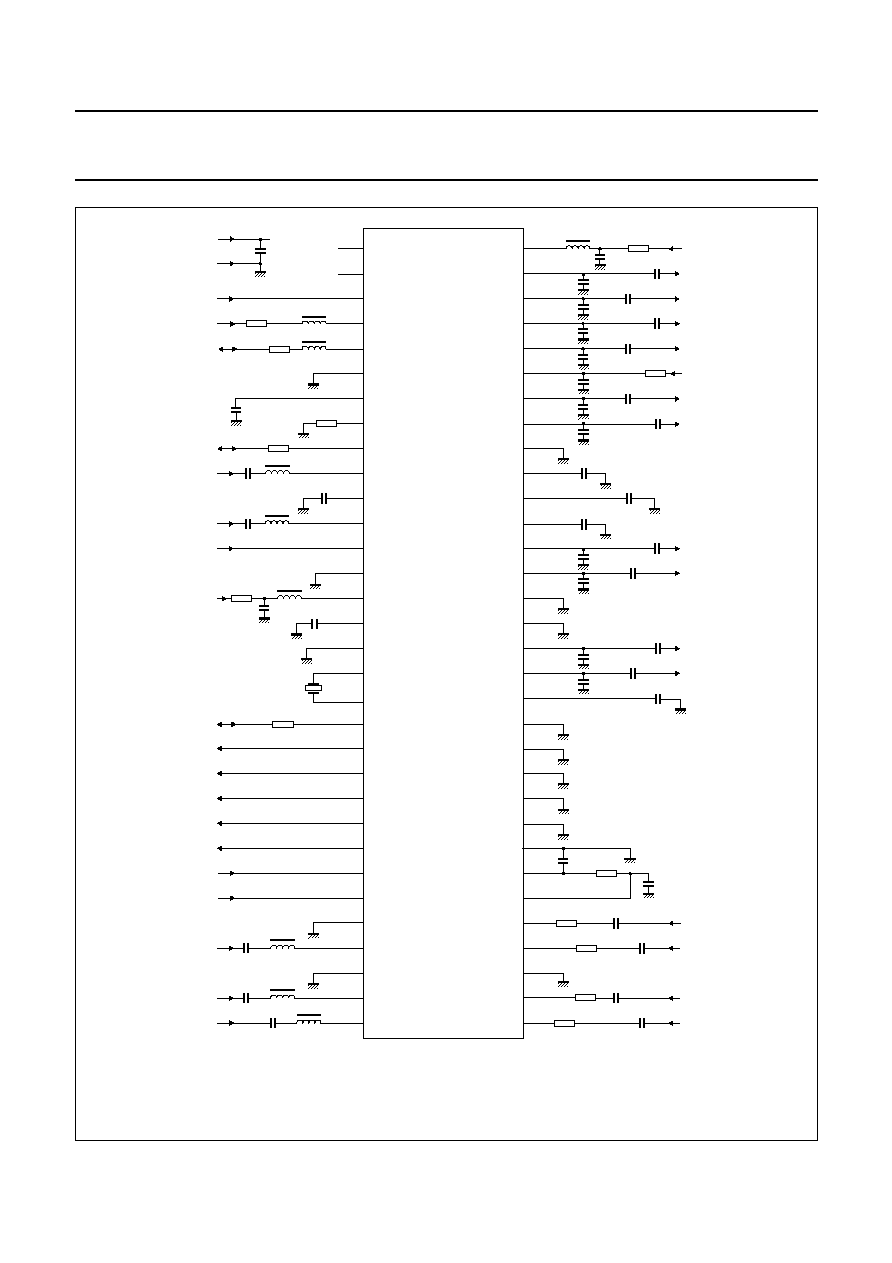
1999 Dec 20
85
Philips Semiconductors
Product specification
Digital TV Sound Processor (DTVSP)
TDA9870A
handbook, full pagewidth
MHB597
1
R5
10 k
R3
2.2 k
R4
1
µ
F
C7
C3
47 pF
C5
47 pF
C4
100 nF
C6
470 nF
C2
470 nF
TDA9870A
(TDA9870AH)
VDDD2
VDDA
VSSA1
TEST1
Iref
VDEC1
VSSA3
MOR
AUXOL
PCAPL
PCAPR
SCOL2
SCOR2
SCOL1
SCOR1
i.c.
i.c.
i.c.
SCIL2
SCIL1
SCIR1
SCIR2
i.c.
Vref3
Vref2
Vref(n)
Vref(p)
VSSA2
VDEC2
VSSD3
VSSA4
VSSD2
AUXOR
LOR
i.c.
i.c.
ADDR1
SCL
SDA
SIFSAT
P2
CRESET
XTALI
XTALO
ADDR2
SIF1
SIFTV
P1
SIF2
VDDD1
VSSD1
VSSD4
Vref1
SYSCLK
SCK
WS
SDO2
SDO1
SDI2
SDI1
MONOIN
EXTIR
EXTIL
TEST2
LOL
MOL
(53) 61
(52) 60
(51) 59
(50) 58
(49) 57
(48) 56
(47) 55
(46) 54
(45) 53
(44) 52
(43) 51
(40) 48
(39) 47
(42) 50
(41) 49
(38) 46
(35) 43
(34) 42
(33) 41
(37) 45
(36) 44
(32) 40
(31) 39
(30) 38
(27) 35
(26) 34
(25) 33
(29) 37
(28) 36
(54) 62
(55) 63
(56) 64
4 (60)
5 (61)
6 (62)
7 (63)
8 (64)
9 (1)
10 (2)
11 (3)
12 (4)
13 (5)
14 (6)
17 (9)
18 (10)
15 (7)
16 (8)
19 (11)
22 (14)
23 (15)
24 (16)
20 (12)
21 (13)
25 (17)
26 (18)
27 (19)
30 (22)
31 (23)
32 (24)
28 (20)
470 nF
C8
470 nF
C9
470 nF
C10
29 (21)
3 (59)
2 (58)
1 (57)
1
2.2
2.2
µ
F
470 nF
2.2
µ
F
C39
C36
C32
470 pF
C38
470 pF
C40
C37
2.2
µ
F
C35
2.2
µ
F
C33
2.2
µ
F
C29
2.2
µ
F
C25
2.2
µ
F
C23
2.2
µ
F
C21
47
µ
F
C16
47
µ
F
C15
470 nF
C17
2.2
µ
F
C19
47
µ
F
C26
10 nF
C34
10 nF
C31
10 nF
C30
10 nF
C20
470 pF
C24
470 pF
C22
470 pF
C18
470 pF
C28
10 nF
C14
330 nF C13
330 nF
C12
330 nF C11
330 nF
C27
10 nF
2.2
µ
F
470
nF
C41
C42
R13
R12
+
5 V
+
5 V
+
5 V
15 k
R11
R10
15 k
R7
15 k
R9
15 k
R8
270
24.576 MHz
L9
L8
L7
L6
2.2 k
R6
L5
L4
L3
100
R1
L1
100
R2
L2
47
µ
F
C1
0 V
POWER
+
5 V
Fig.11 Schematic for application.
L1 to L9 are ferrite beads.
The pin numbers given in parenthesis refer to the TDA9870AH version.
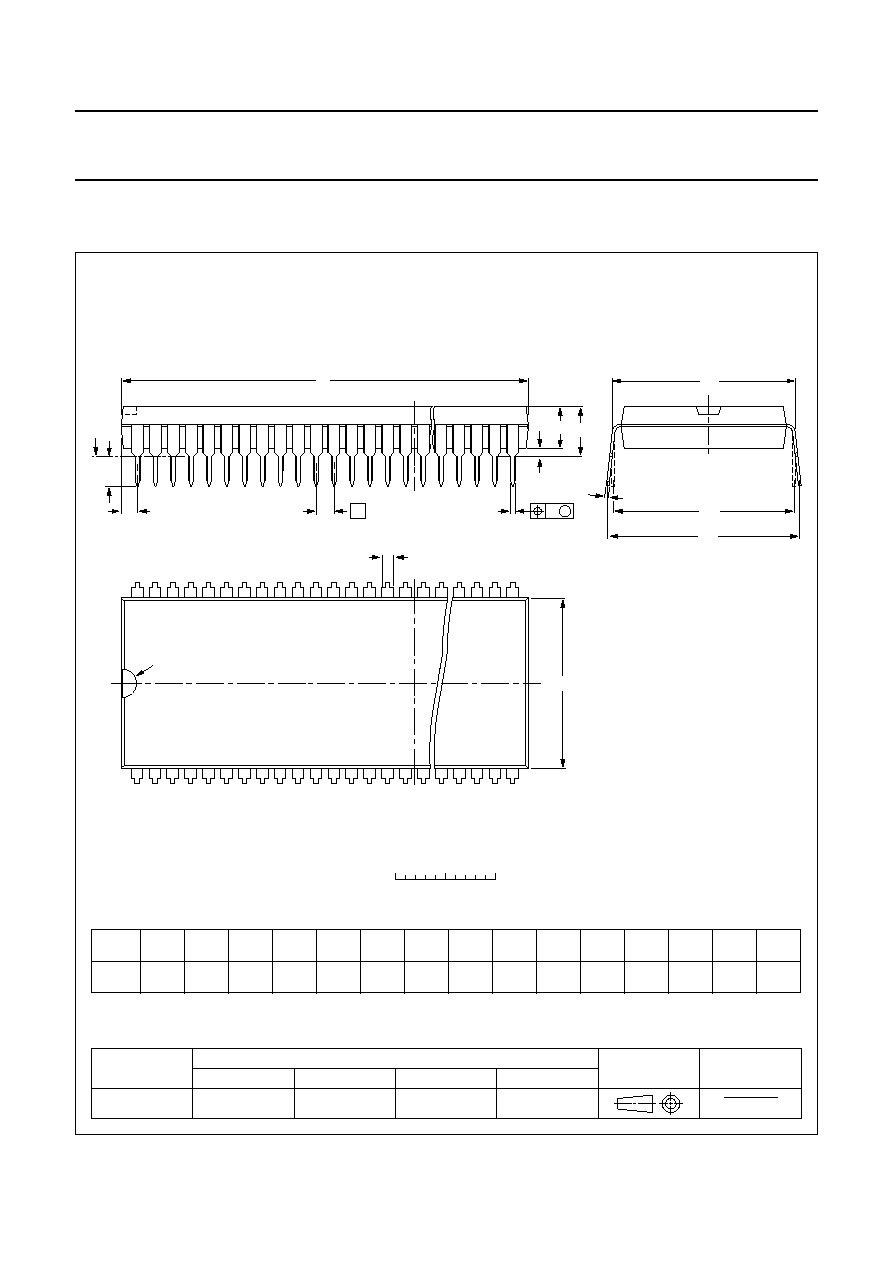
1999 Dec 20
86
Philips Semiconductors
Product specification
Digital TV Sound Processor (DTVSP)
TDA9870A
13 PACKAGE OUTLINES
UNIT
b
1
c
E
e
M
H
L
REFERENCES
OUTLINE
VERSION
EUROPEAN
PROJECTION
ISSUE DATE
IEC
JEDEC
EIAJ
mm
DIMENSIONS (mm are the original dimensions)
SOT274-1
MS-021
95-02-04
99-12-27
b
max.
w
M
E
e
1
1.3
0.8
0.53
0.40
0.32
0.23
58.67
57.70
17.2
16.9
3.2
2.8
0.18
1.778
19.05
19.61
19.05
20.96
19.71
1.73
5.84
0.51
4.57
M
H
c
(e )
1
M
E
A
L
seating plane
A
1
w
M
b
1
e
D
A
2
Z
0
5
10 mm
scale
Note
1. Plastic or metal protrusions of 0.25 mm maximum per side are not included.
(1)
(1)
D
(1)
Z
64
1
33
32
b
E
pin 1 index
A
max.
1
2
A
min.
A
max.
SDIP64: plastic shrink dual in-line package; 64 leads (750 mil)
SOT274-1
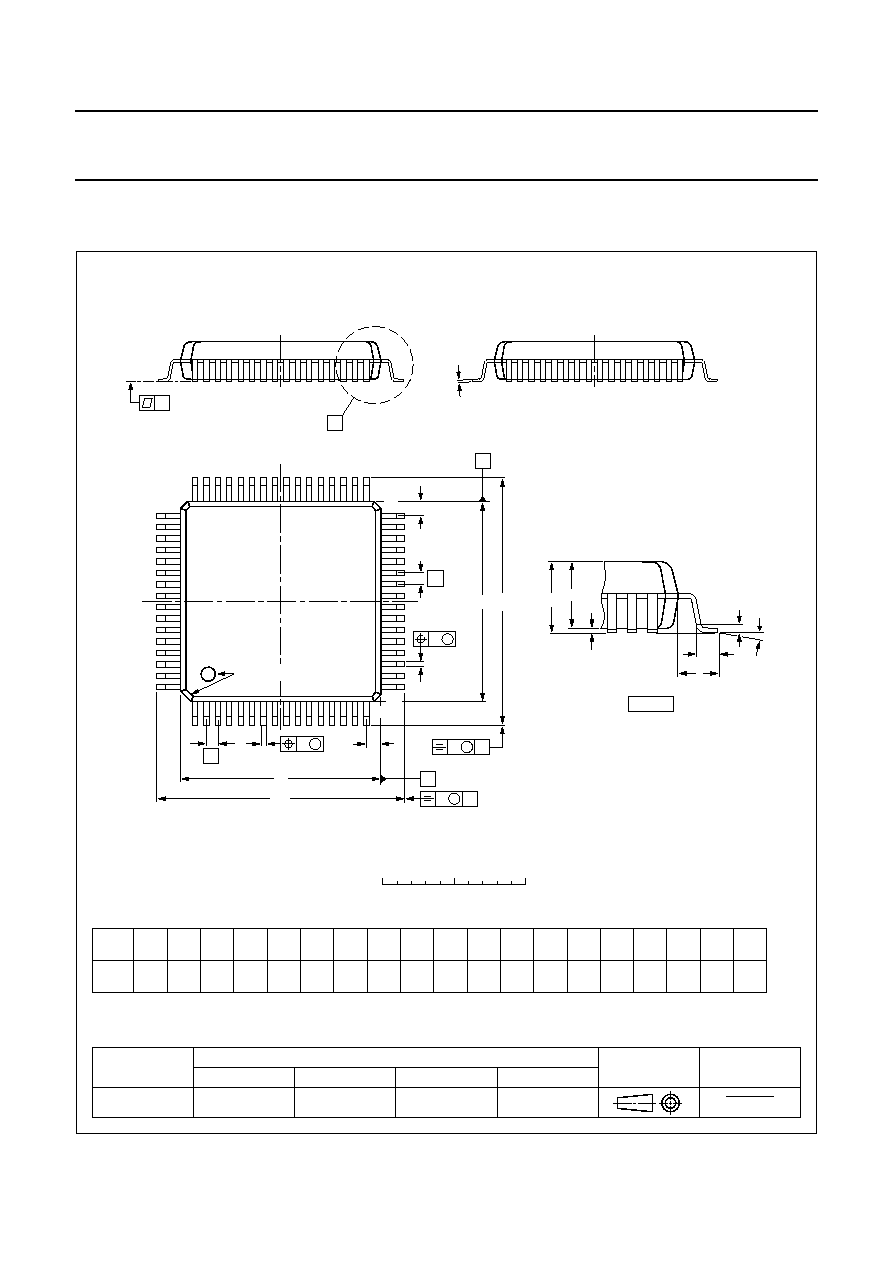
1999 Dec 20
87
Philips Semiconductors
Product specification
Digital TV Sound Processor (DTVSP)
TDA9870A
UNIT
A
1
A
2
A
3
b
p
c
E
(1)
e
H
E
L
L
p
Z
y
w
v
REFERENCES
OUTLINE
VERSION
EUROPEAN
PROJECTION
ISSUE DATE
IEC
JEDEC
EIAJ
mm
0.25
0.10
2.75
2.55
0.25
0.45
0.30
0.23
0.13
14.1
13.9
0.8
17.45
16.95
1.2
0.8
7
0
o
o
0.16
0.10
0.16
1.60
DIMENSIONS (mm are the original dimensions)
Note
1. Plastic or metal protrusions of 0.25 mm maximum per side are not included.
1.03
0.73
SOT393-1
MS-022
97-08-04
99-12-27
D
(1)
(1)
(1)
14.1
13.9
H
D
17.45
16.95
E
Z
1.2
0.8
D
e
E
A
1
A
L
p
detail X
L
(A )
3
B
16
y
c
E
H
A
2
D
Z D
A
Z E
e
v
M
A
1
64
49
48
33
32
17
X
b
p
D
H
b
p
v
M
B
w
M
w
M
0
5
10 mm
scale
pin 1 index
QFP64: plastic quad flat package; 64 leads (lead length 1.6 mm); body 14 x 14 x 2.7 mm
SOT393-1
A
max.
3.00

1999 Dec 20
88
Philips Semiconductors
Product specification
Digital TV Sound Processor (DTVSP)
TDA9870A
14 SOLDERING
14.1
Introduction
This text gives a very brief insight to a complex technology.
A more in-depth account of soldering ICs can be found in
our
"Data Handbook IC26; Integrated Circuit Packages"
(document order number 9398 652 90011).
There is no soldering method that is ideal for all IC
packages. Wave soldering is often preferred when
through-hole and surface mount components are mixed on
one printed-circuit board. However, wave soldering is not
always suitable for surface mount ICs, or for printed-circuit
boards with high population densities. In these situations
reflow soldering is often used.
14.2
Through-hole mount packages
14.2.1
S
OLDERING BY DIPPING OR BY SOLDER WAVE
The maximum permissible temperature of the solder is
260
∞
C; solder at this temperature must not be in contact
with the joints for more than 5 seconds. The total contact
time of successive solder waves must not exceed
5 seconds.
The device may be mounted up to the seating plane, but
the temperature of the plastic body must not exceed the
specified maximum storage temperature (T
stg(max)
). If the
printed-circuit board has been pre-heated, forced cooling
may be necessary immediately after soldering to keep the
temperature within the permissible limit.
14.2.2
M
ANUAL SOLDERING
Apply the soldering iron (24 V or less) to the lead(s) of the
package, either below the seating plane or not more than
2 mm above it. If the temperature of the soldering iron bit
is less than 300
∞
C it may remain in contact for up to
10 seconds. If the bit temperature is between
300 and 400
∞
C, contact may be up to 5 seconds.
14.3
Surface mount packages
14.3.1
R
EFLOW SOLDERING
Reflow soldering requires solder paste (a suspension of
fine solder particles, flux and binding agent) to be applied
to the printed-circuit board by screen printing, stencilling or
pressure-syringe dispensing before package placement.
Several methods exist for reflowing; for example,
infrared/convection heating in a conveyor type oven.
Throughput times (preheating, soldering and cooling) vary
between 100 and 200 seconds depending on heating
method.
Typical reflow peak temperatures range from
215 to 250
∞
C. The top-surface temperature of the
packages should preferable be kept below 230
∞
C.
14.3.2
W
AVE SOLDERING
Conventional single wave soldering is not recommended
for surface mount devices (SMDs) or printed-circuit boards
with a high component density, as solder bridging and
non-wetting can present major problems.
To overcome these problems the double-wave soldering
method was specifically developed.
If wave soldering is used the following conditions must be
observed for optimal results:
∑
Use a double-wave soldering method comprising a
turbulent wave with high upward pressure followed by a
smooth laminar wave.
∑
For packages with leads on two sides and a pitch (e):
≠ larger than or equal to 1.27 mm, the footprint
longitudinal axis is preferred to be parallel to the
transport direction of the printed-circuit board;
≠ smaller than 1.27 mm, the footprint longitudinal axis
must be parallel to the transport direction of the
printed-circuit board.
The footprint must incorporate solder thieves at the
downstream end.
∑
For packages with leads on four sides, the footprint must
be placed at a 45
∞
angle to the transport direction of the
printed-circuit board. The footprint must incorporate
solder thieves downstream and at the side corners.
During placement and before soldering, the package must
be fixed with a droplet of adhesive. The adhesive can be
applied by screen printing, pin transfer or syringe
dispensing. The package can be soldered after the
adhesive is cured.
Typical dwell time is 4 seconds at 250
∞
C.
A mildly-activated flux will eliminate the need for removal
of corrosive residues in most applications.
14.3.3
M
ANUAL SOLDERING
Fix the component by first soldering two
diagonally-opposite end leads. Use a low voltage (24 V or
less) soldering iron applied to the flat part of the lead.
Contact time must be limited to 10 seconds at up to
300
∞
C.
When using a dedicated tool, all other leads can be
soldered in one operation within 2 to 5 seconds between
270 and 320
∞
C.
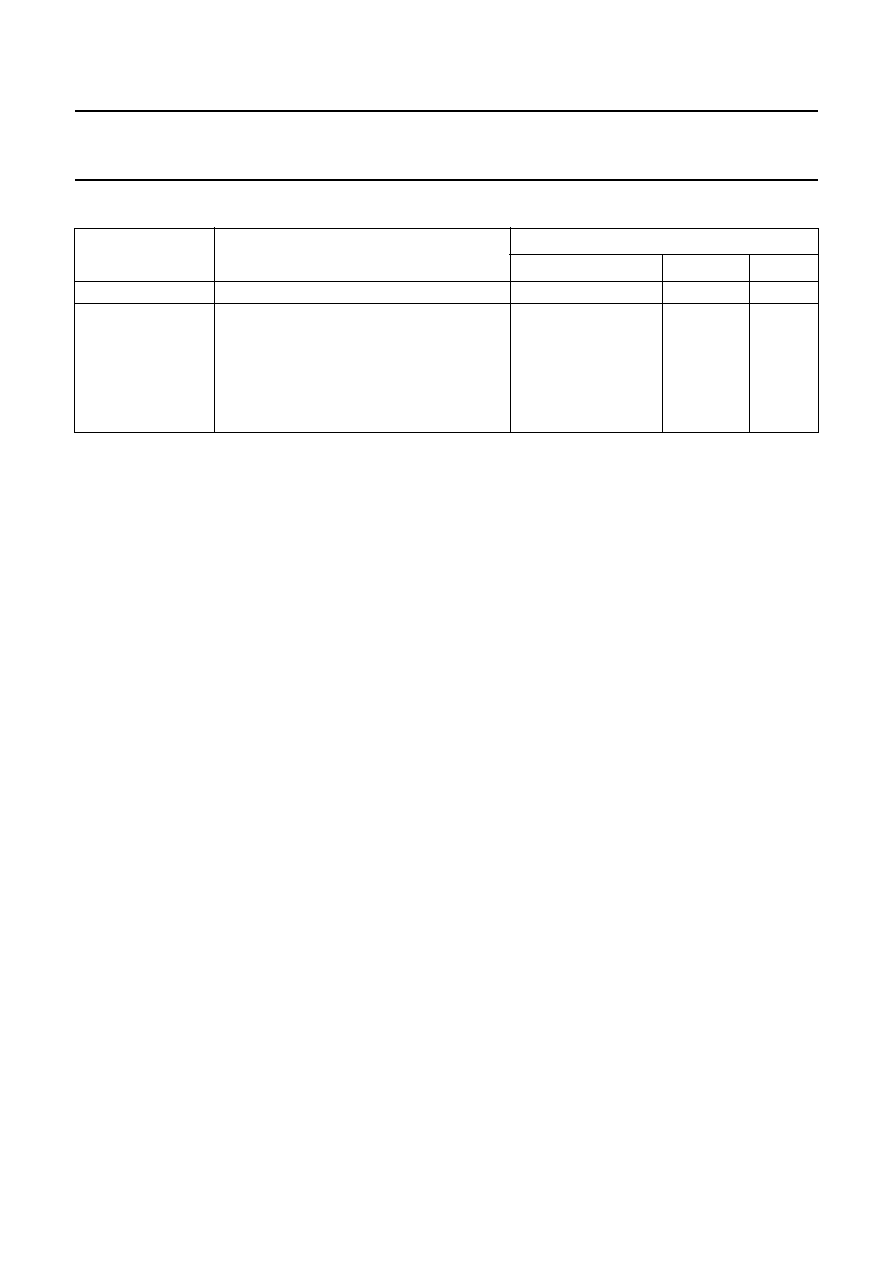
1999 Dec 20
89
Philips Semiconductors
Product specification
Digital TV Sound Processor (DTVSP)
TDA9870A
14.4
Suitability of IC packages for wave, reflow and dipping soldering methods
Notes
1. All surface mount (SMD) packages are moisture sensitive. Depending upon the moisture content, the maximum
temperature (with respect to time) and body size of the package, there is a risk that internal or external package
cracks may occur due to vaporization of the moisture in them (the so called popcorn effect). For details, refer to the
Drypack information in the
"Data Handbook IC26; Integrated Circuit Packages; Section: Packing Methods".
2. For SDIP packages, the longitudinal axis must be parallel to the transport direction of the printed-circuit board.
3. These packages are not suitable for wave soldering as a solder joint between the printed-circuit board and heatsink
(at bottom version) can not be achieved, and as solder may stick to the heatsink (on top version).
4. If wave soldering is considered, then the package must be placed at a 45
∞
angle to the solder wave direction.
The package footprint must incorporate solder thieves downstream and at the side corners.
5. Wave soldering is only suitable for LQFP, QFP and TQFP packages with a pitch (e) equal to or larger than 0.8 mm;
it is definitely not suitable for packages with a pitch (e) equal to or smaller than 0.65 mm.
6. Wave soldering is only suitable for SSOP and TSSOP packages with a pitch (e) equal to or larger than 0.65 mm; it is
definitely not suitable for packages with a pitch (e) equal to or smaller than 0.5 mm.
MOUNTING
PACKAGE
SOLDERING METHOD
WAVE
REFLOW
(1)
DIPPING
Through-hole mount DBS, DIP, HDIP, SDIP, SIL
suitable
(2)
-
suitable
Surface mount
BGA, SQFP
not suitable
suitable
-
HLQFP, HSQFP, HSOP, HTQFP, HTSSOP,
SMS
not suitable
(3)
suitable
-
PLCC
(4)
, SO, SOJ
suitable
suitable
-
LQFP, QFP, TQFP
not recommended
(4)(5)
suitable
-
SSOP, TSSOP, VSO
not recommended
(6)
suitable
-

1999 Dec 20
90
Philips Semiconductors
Product specification
Digital TV Sound Processor (DTVSP)
TDA9870A
15 DEFINITIONS
16 LIFE SUPPORT APPLICATIONS
These products are not designed for use in life support appliances, devices, or systems where malfunction of these
products can reasonably be expected to result in personal injury. Philips customers using or selling these products for
use in such applications do so at their own risk and agree to fully indemnify Philips for any damages resulting from such
improper use or sale.
17 PURCHASE OF PHILIPS I
2
C COMPONENTS
Data sheet status
Objective specification
This data sheet contains target or goal specifications for product development.
Preliminary specification
This data sheet contains preliminary data; supplementary data may be published later.
Product specification
This data sheet contains final product specifications.
Limiting values
Limiting values given are in accordance with the Absolute Maximum Rating System (IEC 134). Stress above one or
more of the limiting values may cause permanent damage to the device. These are stress ratings only and operation
of the device at these or at any other conditions above those given in the Characteristics sections of the specification
is not implied. Exposure to limiting values for extended periods may affect device reliability.
Application information
Where application information is given, it is advisory and does not form part of the specification.
Purchase of Philips I
2
C components conveys a license under the Philips' I
2
C patent to use the
components in the I
2
C system provided the system conforms to the I
2
C specification defined by
Philips. This specification can be ordered using the code 9398 393 40011.

1999 Dec 20
91
Philips Semiconductors
Product specification
Digital TV Sound Processor (DTVSP)
TDA9870A
NOTES

© Philips Electronics N.V.
SCA
All rights are reserved. Reproduction in whole or in part is prohibited without the prior written consent of the copyright owner.
The information presented in this document does not form part of any quotation or contract, is believed to be accurate and reliable and may be changed
without notice. No liability will be accepted by the publisher for any consequence of its use. Publication thereof does not convey nor imply any license
under patent- or other industrial or intellectual property rights.
Internet: http://www.semiconductors.philips.com
1999
68
Philips Semiconductors ≠ a worldwide company
For all other countries apply to: Philips Semiconductors,
International Marketing & Sales Communications, Building BE-p, P.O. Box 218,
5600 MD EINDHOVEN, The Netherlands, Fax. +31 40 27 24825
Argentina: see South America
Australia: 3 Figtree Drive, HOMEBUSH, NSW 2140,
Tel. +61 2 9704 8141, Fax. +61 2 9704 8139
Austria: Computerstr. 6, A-1101 WIEN, P.O. Box 213,
Tel. +43 1 60 101 1248, Fax. +43 1 60 101 1210
Belarus: Hotel Minsk Business Center, Bld. 3, r. 1211, Volodarski Str. 6,
220050 MINSK, Tel. +375 172 20 0733, Fax. +375 172 20 0773
Belgium: see The Netherlands
Brazil: see South America
Bulgaria: Philips Bulgaria Ltd., Energoproject, 15th floor,
51 James Bourchier Blvd., 1407 SOFIA,
Tel. +359 2 68 9211, Fax. +359 2 68 9102
Canada: PHILIPS SEMICONDUCTORS/COMPONENTS,
Tel. +1 800 234 7381, Fax. +1 800 943 0087
China/Hong Kong: 501 Hong Kong Industrial Technology Centre,
72 Tat Chee Avenue, Kowloon Tong, HONG KONG,
Tel. +852 2319 7888, Fax. +852 2319 7700
Colombia: see South America
Czech Republic: see Austria
Denmark: Sydhavnsgade 23, 1780 COPENHAGEN V,
Tel. +45 33 29 3333, Fax. +45 33 29 3905
Finland: Sinikalliontie 3, FIN-02630 ESPOO,
Tel. +358 9 615 800, Fax. +358 9 6158 0920
France: 51 Rue Carnot, BP317, 92156 SURESNES Cedex,
Tel. +33 1 4099 6161, Fax. +33 1 4099 6427
Germany: Hammerbrookstraþe 69, D-20097 HAMBURG,
Tel. +49 40 2353 60, Fax. +49 40 2353 6300
Hungary: see Austria
India: Philips INDIA Ltd, Band Box Building, 2nd floor,
254-D, Dr. Annie Besant Road, Worli, MUMBAI 400 025,
Tel. +91 22 493 8541, Fax. +91 22 493 0966
Indonesia: PT Philips Development Corporation, Semiconductors Division,
Gedung Philips, Jl. Buncit Raya Kav.99-100, JAKARTA 12510,
Tel. +62 21 794 0040 ext. 2501, Fax. +62 21 794 0080
Ireland: Newstead, Clonskeagh, DUBLIN 14,
Tel. +353 1 7640 000, Fax. +353 1 7640 200
Israel: RAPAC Electronics, 7 Kehilat Saloniki St, PO Box 18053,
TEL AVIV 61180, Tel. +972 3 645 0444, Fax. +972 3 649 1007
Italy: PHILIPS SEMICONDUCTORS, Via Casati, 23 - 20052 MONZA (MI),
Tel. +39 039 203 6838, Fax +39 039 203 6800
Japan: Philips Bldg 13-37, Kohnan 2-chome, Minato-ku,
TOKYO 108-8507, Tel. +81 3 3740 5130, Fax. +81 3 3740 5057
Korea: Philips House, 260-199 Itaewon-dong, Yongsan-ku, SEOUL,
Tel. +82 2 709 1412, Fax. +82 2 709 1415
Malaysia: No. 76 Jalan Universiti, 46200 PETALING JAYA, SELANGOR,
Tel. +60 3 750 5214, Fax. +60 3 757 4880
Mexico: 5900 Gateway East, Suite 200, EL PASO, TEXAS 79905,
Tel. +9-5 800 234 7381, Fax +9-5 800 943 0087
Middle East: see Italy
Netherlands: Postbus 90050, 5600 PB EINDHOVEN, Bldg. VB,
Tel. +31 40 27 82785, Fax. +31 40 27 88399
New Zealand: 2 Wagener Place, C.P.O. Box 1041, AUCKLAND,
Tel. +64 9 849 4160, Fax. +64 9 849 7811
Norway: Box 1, Manglerud 0612, OSLO,
Tel. +47 22 74 8000, Fax. +47 22 74 8341
Pakistan: see Singapore
Philippines: Philips Semiconductors Philippines Inc.,
106 Valero St. Salcedo Village, P.O. Box 2108 MCC, MAKATI,
Metro MANILA, Tel. +63 2 816 6380, Fax. +63 2 817 3474
Poland: Al.Jerozolimskie 195 B, 02-222 WARSAW,
Tel. +48 22 5710 000, Fax. +48 22 5710 001
Portugal: see Spain
Romania: see Italy
Russia: Philips Russia, Ul. Usatcheva 35A, 119048 MOSCOW,
Tel. +7 095 755 6918, Fax. +7 095 755 6919
Singapore: Lorong 1, Toa Payoh, SINGAPORE 319762,
Tel. +65 350 2538, Fax. +65 251 6500
Slovakia: see Austria
Slovenia: see Italy
South Africa: S.A. PHILIPS Pty Ltd., 195-215 Main Road Martindale,
2092 JOHANNESBURG, P.O. Box 58088 Newville 2114,
Tel. +27 11 471 5401, Fax. +27 11 471 5398
South America: Al. Vicente Pinzon, 173, 6th floor,
04547-130 S√O PAULO, SP, Brazil,
Tel. +55 11 821 2333, Fax. +55 11 821 2382
Spain: Balmes 22, 08007 BARCELONA,
Tel. +34 93 301 6312, Fax. +34 93 301 4107
Sweden: Kottbygatan 7, Akalla, S-16485 STOCKHOLM,
Tel. +46 8 5985 2000, Fax. +46 8 5985 2745
Switzerland: Allmendstrasse 140, CH-8027 ZÐRICH,
Tel. +41 1 488 2741 Fax. +41 1 488 3263
Taiwan: Philips Semiconductors, 6F, No. 96, Chien Kuo N. Rd., Sec. 1,
TAIPEI, Taiwan Tel. +886 2 2134 2886, Fax. +886 2 2134 2874
Thailand: PHILIPS ELECTRONICS (THAILAND) Ltd.,
209/2 Sanpavuth-Bangna Road Prakanong, BANGKOK 10260,
Tel. +66 2 745 4090, Fax. +66 2 398 0793
Turkey: Yukari Dudullu, Org. San. Blg., 2.Cad. Nr. 28 81260 Umraniye,
ISTANBUL, Tel. +90 216 522 1500, Fax. +90 216 522 1813
Ukraine: PHILIPS UKRAINE, 4 Patrice Lumumba str., Building B, Floor 7,
252042 KIEV, Tel. +380 44 264 2776, Fax. +380 44 268 0461
United Kingdom: Philips Semiconductors Ltd., 276 Bath Road, Hayes,
MIDDLESEX UB3 5BX, Tel. +44 208 730 5000, Fax. +44 208 754 8421
United States: 811 East Arques Avenue, SUNNYVALE, CA 94088-3409,
Tel. +1 800 234 7381, Fax. +1 800 943 0087
Uruguay: see South America
Vietnam: see Singapore
Yugoslavia: PHILIPS, Trg N. Pasica 5/v, 11000 BEOGRAD,
Tel. +381 11 62 5344, Fax.+381 11 63 5777
Printed in The Netherlands
545004/02/pp
92
Date of release:
1999 Dec 20
Document order number:
9397 750 06064



























































































